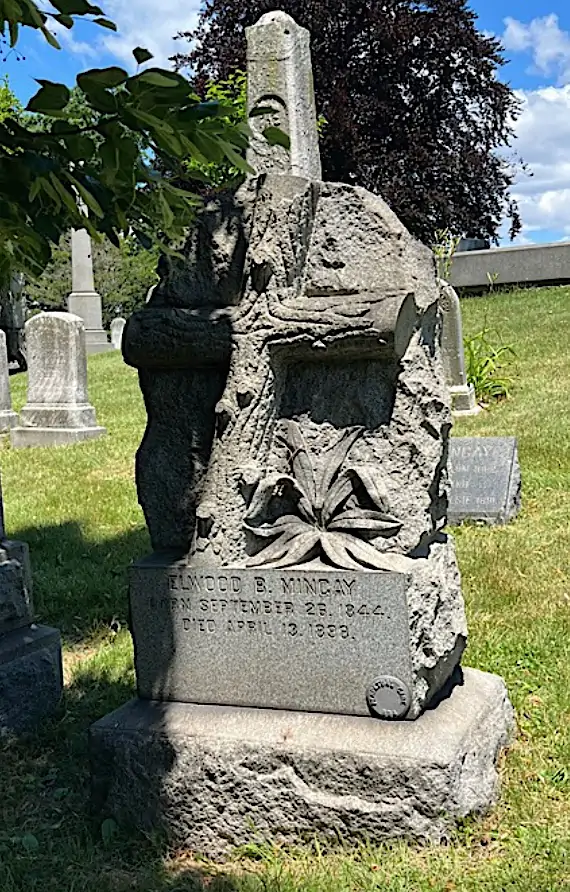McKEWAN, JOHN P. (1845-1886). Private, 84th Regiment, New York State National Guard, Company B. After McKewan enlisted as a private in 1864, he mustered into the 84th Regiment and mustered out after his service of 100 days. According to his obituary in the New York Evening Post, he was a stockbroker who had been a member of the Stock Exchange for seventeen years and had an office at 56 Broadway in Manhattan. An article in the New York Daily Graphic reported that he joined the firm of Alexander Taylor’s Sons on May 2, 1881. As per his obituary in the New York Tribune, veterans of the 7th Regiment were requested to attend his funeral. That obituary noted that he was popular among members of the Stock Exchange who were preparing to draft resolutions to honor his memory. His last residence was 26 West 48th Street in Manhattan. McKewan’s obituary in the Evening Post noted that he died after a four-day bout with pneumonia. Section 177, lot 16302.
Civil War Bio Search
McKILLOP (or McKILLUP), GEORGE (1844-1883). Private, 51st New York Infantry, Company F. Born in Dublin, Ireland, McKillup enlisted as a private at Brooklyn on April 8, 1864, and immediately mustered into the 51st New York. As per his muster roll, he was a farmer who was 5′ 2½” tall with blue eyes, light hair and a light complexion. On September 30, 1864, he was taken prisoner of war at the Battle of Poplar Grove Church, Virginia, and was held at Salisbury, North Carolina, until he was paroled on March 13, 1865. He was discharged on June 20, 1865, at New York City.
An article in the Rochester [New York] Democrat and Chronicle on January 29, 1877, notes that George McKillop took over the management of The Commercial Agency from his uncle and that George, “who grew up in the business from his infancy,” possessed the integrity and ability to handle every detail of the firm. As per the Rochester Directories for 1878 and 1879, he was the manager of a collection agency. His last residence was 199 North Street in Rochester, New York. Section 72, lot 17378.
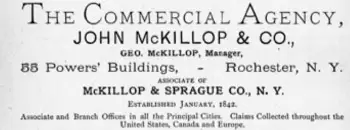
McKINLEY (or KENNEDY), THOMAS (1842-1883). Musician, 1st New York Infantry, Companies G and F. A native of New York, he enlisted as a private at New York City on December 9, 1861, and mustered immediately into Company G of the 1st New York Infantry. He was promoted to musician at some point and transferred to Company F on January 20, 1862. McKinley mustered out on May 25, 1861, at New York City. As per his soldier history, he was also known as Thomas Kennedy. The census of 1880 records his occupation as iron molder. He last lived at 239 2nd Street in Brooklyn. He died of an aneurysm. Section 14, lot 4969, grave 205.
McKNIGHT, JOHN (1821-1873). Private, 39th New York Infantry, Company F. A native of Ireland, McKnight was listed as a foreman in a stone yard on the 1860 census and a stone cutter on his 1863 Draft Registration. McKnight enlisted as a private at New York City on November 30, 1863, mustered immediately into the 39th New York, and mustered out on July 1, 1865, at Alexandria, Virginia. He last resided at 506 West 13th Street in Manhattan. His death was caused by phthisis. Section 116, lot 4073, grave 69.
McKNIGHT, ROBERT (1838-1878). Sergeant, 73rd New York Infantry, Companies H and A. Born in New York State, McKnight enlisted at Brooklyn as a private on August 6, 1861, mustered into Company H of the 73rd New York, and was promoted to corporal on September 1, 1861, effective upon his transfer to Company A. His promotion and transfer preceded his official mustering in on September 29. On November 6, 1861, he became sergeant of Company A. Listed on the rolls as of October 15, 1862, there is no further record of his service. His last residence was 241 Nassau Street in Brooklyn. His cause of death was listed as tubercular meningitis. Section A, lot 9146, grave 49.
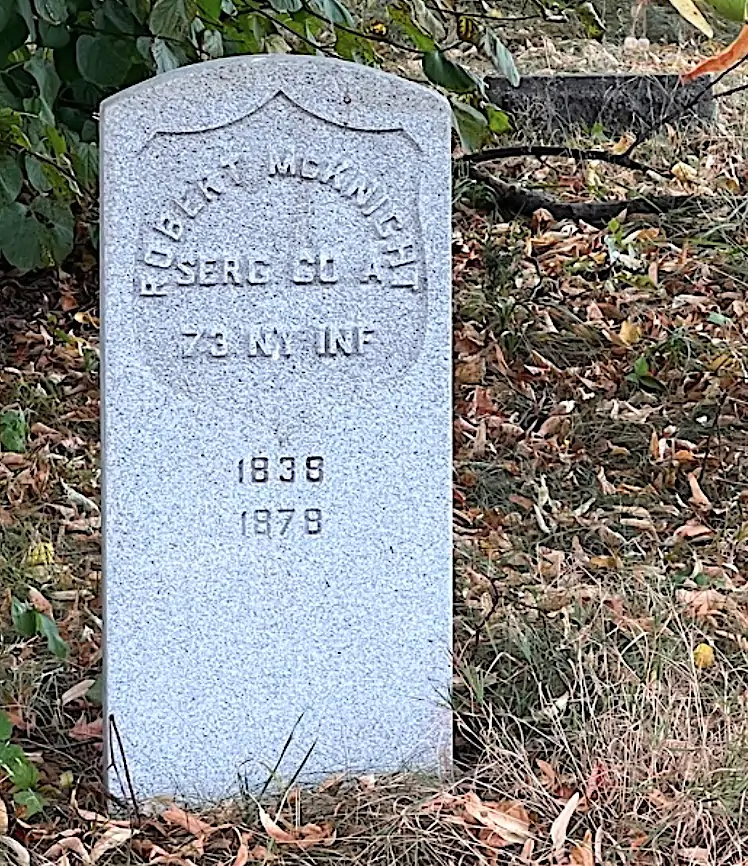
McKNIGHT, WILLIAM (1840-1914). Medal of Honor recipient; coxswain, United States Navy. Born in Ulster County, New York, McKnight was gun captain aboard the USS Varuna during the attacks on Forts Jackson and St. Philip, which protected the entrance to New Orleans, Louisiana. His citation reads, “Captain of a gun on board the USS Varuna during the attacks on Forts Jackson and St. Philip and in action against the rebel ship Morgan, 24 April 1862. During this action at extremely close range, while the ship was under furious fire and was twice rammed by the rebel ship Morgan, McKnight remained steadfast at his gun throughout the thickest of the fight and was instrumental in inflicting damage on the enemy until the Varuna, so badly damaged that she was forced to beach, was finally sunk.” His obituary in the Brooklyn Daily Eagle confirms his membership in the Medal of Honor Legion of the United States and reports that he was one of seventy men from New York who were awarded that decoration. That obituary notes that McKnight was a good friend of Admiral David Farragut and that Farragut was influential in promoting McKnight from coxswain to first mate to captain.
In civilian life, McKnight was a dealer in butter and eggs in the Washington Market in Manhattan, a position that he held for over twenty-seven years. After retiring from the business, he was a shipwright at the Brooklyn Navy Yard. The Eagle noted that McKnight was one of the oldest readers of that newspaper, never missing a copy during his last thirty years. Among friends, he was known as a champion checker player who was always ready for a game. He was also a member of the Bethany Presbyterian Church. In about 1910, he developed paralysis and then the hardening of the arteries that ultimately caused his death. He last lived at 326 Woodland Avenue in Woodhaven, Queens. Section 185, lot 23348.
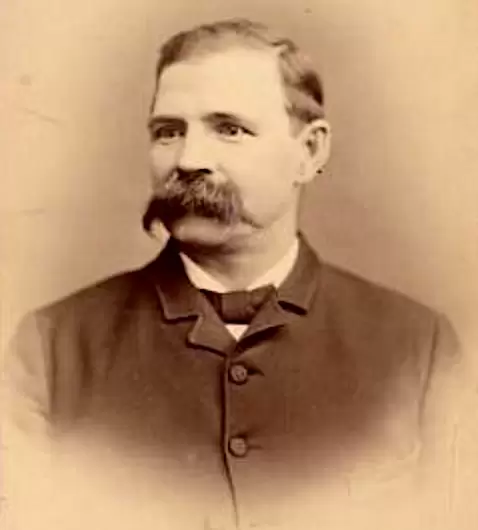
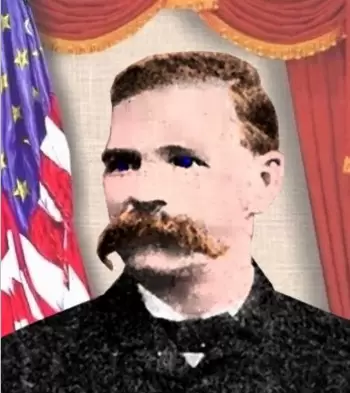
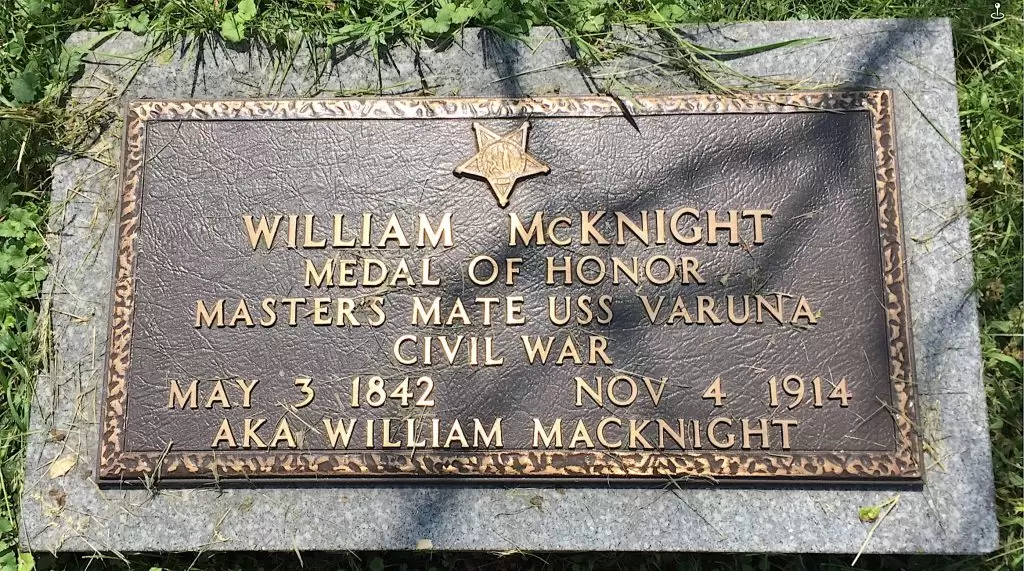
McLAIN (or McLEAN), JOHN (1844-1917). Private, 41st New York Infantry, Companies C and B. A native of New York City, he enlisted there on August 24, 1863, as a private, and immediately mustered into Company C of the 41st New York. On June 10, 1864, he transferred into Company B, and was discharged for disability on October 4, 1864, at Hilton Head, South Carolina. He was a member of the G.A.R. His last residence was 195 West 10th Street in Manhattan. He succumbed to apoplexy. Section 183, lot 20256, grave 1.
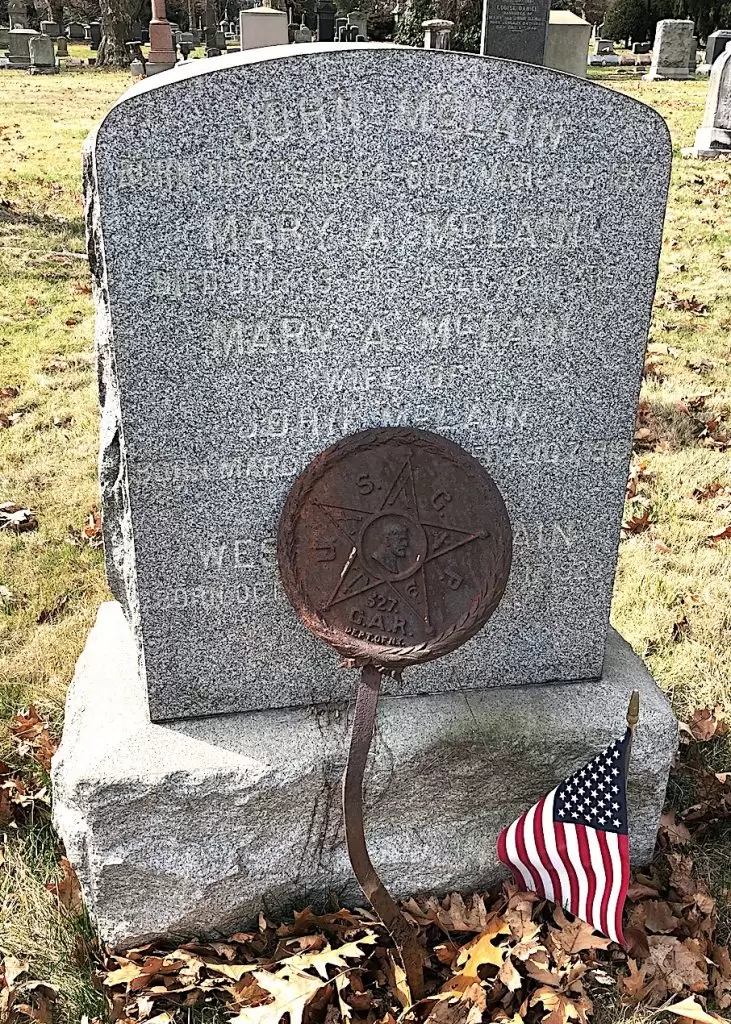
McLAUGHLIN, CHARLES ADAMS (1839-1902). Superintendent of Records, Adjutant General’s Department; private, 9th New York Regiment, New York State Militia. A New York City native, he was a clerk who was 5′ 4½” tall with gray eyes, light brown hair and a fair complexion. According to his obituary in The New York Times, McLaughlin first served in the 9th Regiment, New York State Militia, where he was detailed to the Commissary Department under General Banks. As per his soldier record, he enlisted as a private at New York City on May 27, 1861, and mustered that day into Company G of the 83rd Infantry. (The 83rd was formed from the 9th Regiment.) The 83rd, known as one of the “fighting regiments,” participated in the Rockville Expedition on June 10 through July 7, 1861 then served along the Potomac until March 1862. The regiment was stationed along the Rappahannock River in the spring of 1862, and fought in Pope’s Campaign in Northern Virginia. McLaughlin fought at the Battles of South Mountain and at Antietam, Maryland, September 16-17, 1862, at which time the 83rd lost 114 men.
McLaughlin’s soldier record notes that he was discharged for promotion to hospital steward on September 26, 1862. He re-enlisted at Washington, D.C., three days later and was then was attached to the Adjutant General’s Office at Washington, D.C., on an unknown date. A year later, he aided in the establishment of the Provost Marshal’s Bureau and became Superintendent of Records when the two offices merged. McLaughlin was discharged on April 8, 1863.
In 1868, he was the Washington correspondent for The Brooklyn Times. After returning to Brooklyn, he was active in political life assuming the position of secretary to Mayors Hunter and Schroeder. Subsequently, he was Registrar of Water Rates from 1878-1890. Continuing his interest in military affairs, he belonged to the Veteran Association of the 9th Regiment and the Engineering Corps of the 13th Regiment. He was also a Freemason. His obituary notes that he was involved in the insurance business on Court Street in Brooklyn. Nine months before his death, the Christian Nation reported that he had his tongue surgically removed on May 12 at the Seney Hospital and that a mechanical appliance would enable him to talk. Members of his Masonic lodge and comrades from the 9th Regiment were invited to attend his funeral. He last lived at 361 Quincy Street in Brooklyn. His obituary attributed his death from cancer as a result of his smoking. Section 146, lot 25513, grave 2.
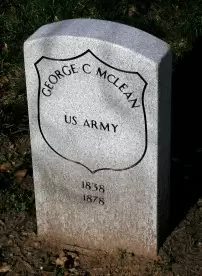
McLEAN, GEORGE C. (1838-1878). Unknown soldier history. McClean, a native New Yorker, served in the Civil War. Details of his military record are not known. He last resided at 12 Fulton Street, Brooklyn, New York. His death was attributed to exhaustion. Section 115, lot 13536 (Soldiers’ Lot), grave 126.
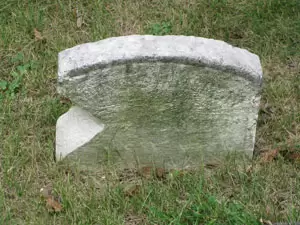
McLEAY (or McCLEARY, McLAY), DAVID (1846-1885). Landsman, United States Navy; private, 9th New York Veteran Cavalry, Company F. A native of New York City, McLeay enlisted as a seaman in the United States Navy on February 25, 1863, served on board the USS Princess Royal, then re-enlisted on January 2, 1864, and was discharged on February 27, 1865, from the USS Savannah. On April 4, 1865, he enlisted as a private and joined the 9th New York Veteran Cavalry. He was borne on the rolls as David McLay. As per his muster roll, he was a plumber who was 5′ 5″ tall with gray eyes, brown hair and a fair complexion. He mustered out with his company on July 17, 1865, at Cloud’s Mills, Virginia.
The 1880 census identifies McLeay as a news dealer. His last residence was 37 West 48th Street in Manhattan. His death was caused by complications from arthritis. Mary A. McLeay, who is interred with him, applied for a widow’s pension in 1890 from the Navy which was granted under certificate 6,960. Thomas, McLaey wrote to the Pension Bureau on behalf of his sister-in-law stating that “…she is sickly, very poor, and she and her children often have to go to bed hungry. Her daughter is sickly and their case is one that deserves to be acted on specially. I am in poor health and circumstances myself, and have to work hard to support myself and family, so am not able to help my sister-in-law as I otherwise would….” Section 105, lot 1919.
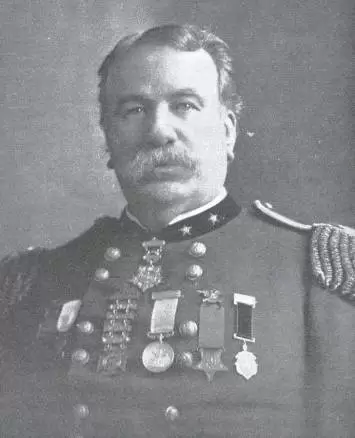
McLEER, JAMES (1839-1922). Captain, first lieutenant and second lieutenant by brevet; sergeant, 84th New York (14th Brooklyn) Infantry, Company C. A native of Brooklyn, he worked in the law office of General Philip S. Crooke (see) and was about to be admitted to the bar when the Civil War broke out. He enlisted as a private on April 18, 1861, and mustered into the 14th Brooklyn on May 23. His obituary notes that when the 14th was camped at Fort Greene, Brooklyn, before starting for the frontlines, it was known familiarly as the “Red-Legged Devils” because of the soldiers’ distinctive Zouave trousers.
On July 21, 1861, McLeer was wounded in the head and arm at First Bull Run, Virginia. Suffering from a painful wound near one eye, he was placed in an ambulance, but was abandoned by the teamster; he then managed to walk across Cub Run to safety. As a result of these injuries, he was hospitalized for several months. Promoted to corporal on November 1, 1861, he was wounded at Groveton, Virginia, on August 29, 1862, and his left arm was amputated. The pain from his arm stump plagued him throughout his lifetime. He was promoted to sergeant on March 1, 1863, and subsequently discharged for disability on July 27, 1863. McLeer was promoted by brevet to second lieutenant, first lieutenant, and captain on April 4, 1867.
After the Civil War, McLeer practiced law, was elected Brooklyn auditor and street commissioner, served as United States Pension Agent for Long Island, was appointed postmaster of Brooklyn by President Rutherford B. Hayes and served in that position from 1877-1887, and was then Brooklyn city assessor. Active in military affairs, McLeer was post commander of the G.A.R.’s Wadsworth Post #4 and a member of the Ulysses S. Grant Post #327, and rose to the rank of brigadier general, brigade commander, 2nd Brigade, New York National Guard, the head of all militia in Brooklyn. He took part in the mobilization of Brooklyn regiments during the Spanish-American War. His obituary in the Brooklyn Daily Eagle began and concluded with this tribute:
All old Brooklyn mourns the death of General James McLeer at the age of 83. We are inclined to think that in public life of the city, as in public life of the borough, no man was more loved, no man more respected. He had shed his blood for the Union, he had come back to civil existence with one arm gone and one leg permanently injured, and yet a strong constitution and normal habits of life enabled him to render fine service to the community, fine service to the National Guard of the State for fifty-six years…..
…Sons and grandsons find example and stimulation in General McLeer’s career. Courage, enthusiasm, kindness, fortitude, on so broad a field, however have a wider influence, They reach and touch friends, acquaintances, the entire community. The general effect on character-making is their chief contribution to a common humanity.
He last lived at 309 East 21st Street in Brooklyn. He succumbed to arteriosclerosis. Section 114, lot 16977.
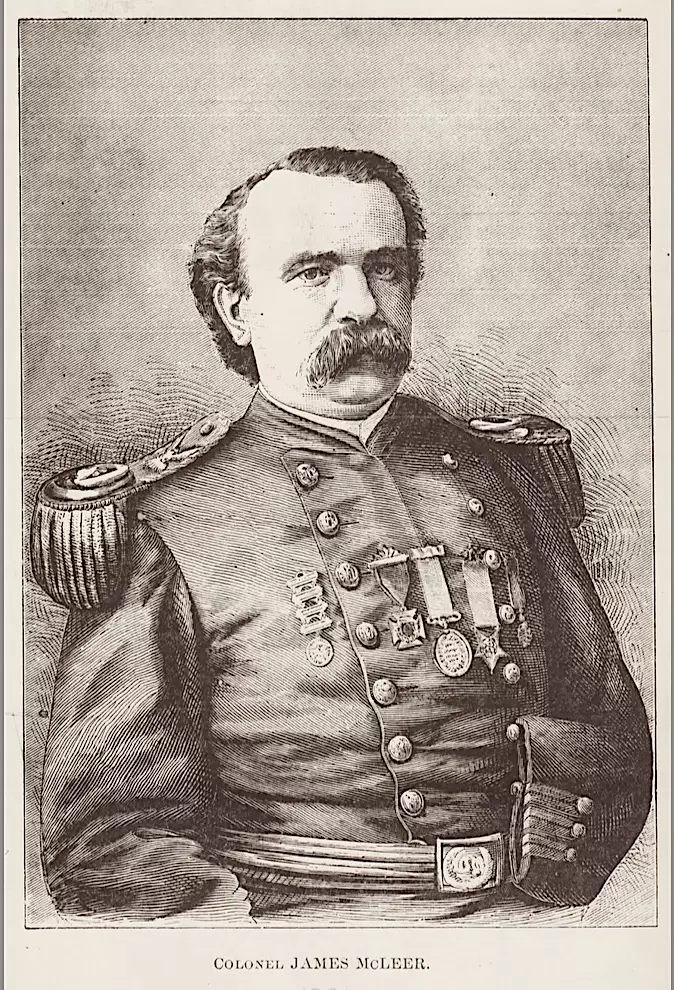
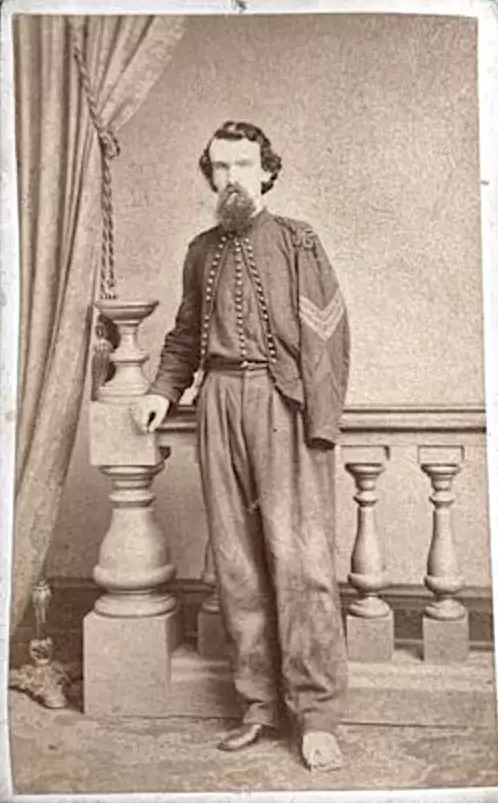
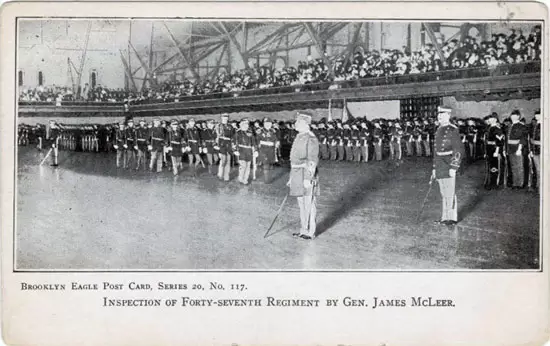
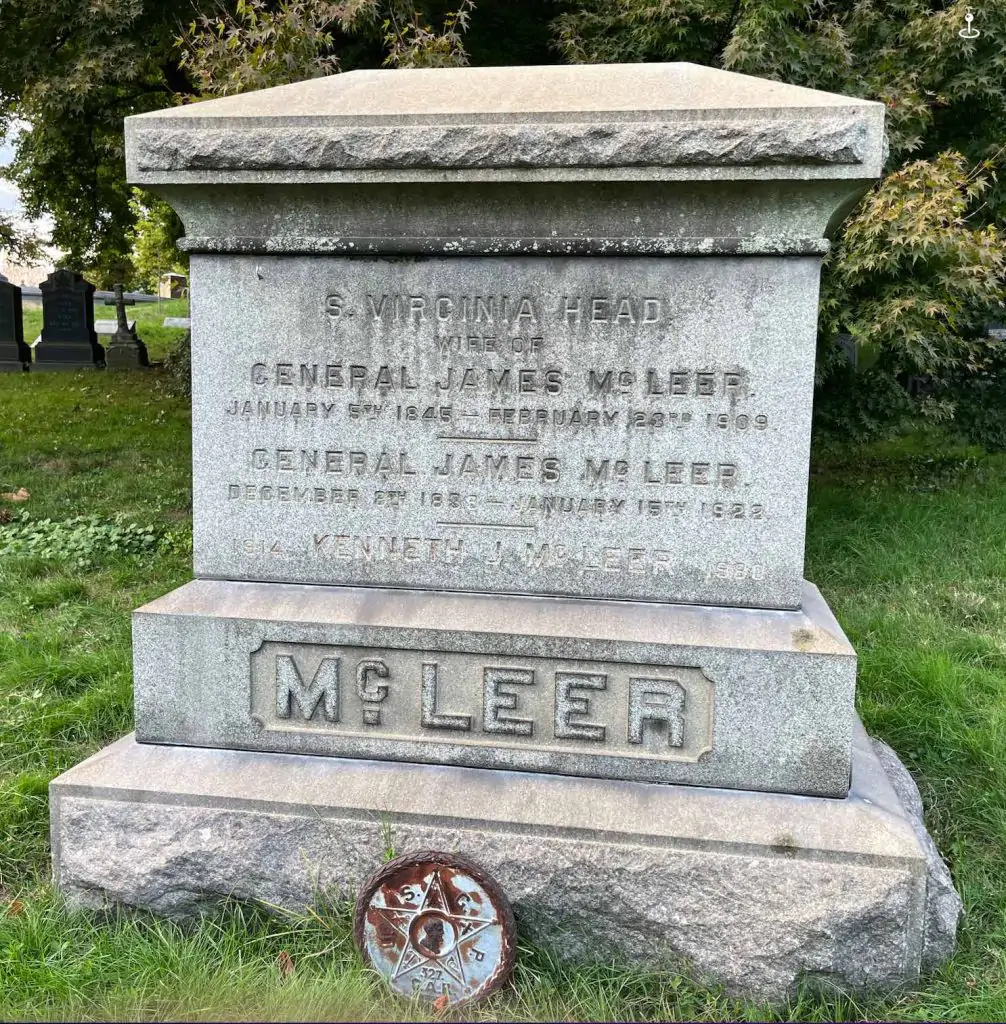
McLELLAN , DAVID (1825-1867). Major, 79th New York Infantry. Originally from Pollockshaws, Scotland, McLellan was a lithographer in Glasgow who immigrated to the United States in 1847, and soon became a naturalized citizen. He continued in his trade in New York City where his firm, a partnership with his brother James and known as D & J. McLellan, became successful lithographers known for advancing their art in the U.S. and for having integrity. After his brother James died unexpectedly in 1860, the firm was known as D. McLellan & Bros.
At the onset of the Civil War, he played a major role in organizing the 79th Regiment, also known as the Highland Guards; many of the recruits were from the same region of Scotland as McLellan. After enlisting as major at New York City on April 29, 1861, he was commissioned into the Field and Staff of the 79th New York on June 1. Early in the Civil War, the 79th wore a distinctive dress uniform that included red and white knee-socks in a diamond-shaped checkered pattern with a dirk, a knife used in hand-to-hand combat, placed in the right sock. Kilts and a white sporran (purse) were also worn. Although many men in the regiment wore a traditional boat-shaped Glengarry hat, McLellan chose a cap with a spectacular feather, a perk that officers had in uniform choice. According to his obituaries on July 28, 1867, in The New York Times and the New York Tribune, he commanded the 79th after the fall of Colonel Cameron at the Battle of Bull Run, Virginia, and was discharged on August 10, 1861.
Active in promoting Scottish heritage, McLellan was member and chief of the Caledonian Club of New York for five years. The obituaries confirmed that he was involved in the organization of the 79th and was active in the regiment until his death. He was held in such esteem that the regiment’s flag was ordered to be draped in mourning for three months to memorialize him and the commissioned officers were ordered to wear mourning badges during that period. He was also a Freemason who at one time held the position of master of his lodge, the Scotia Lodge #634, whose history recalled his devotion to matters of special concern to Scotsmen, his service in the Civil War, and his “superior intellectual ability, pleasing personal presence, and genial and kindly nature.” Another article about his funeral in the New York Herald, which also noted his active role in organizing the 79th Regiment during the Civil War, reports that his name was universally known and respected among Scottish citizens of New York. The Herald stated that his friends remembered his kind disposition and said that “he had not a personal enemy in the world.” He died from dysentery at his home at 317 West 12th Street in Manhattan.
Two gravestones mark his final resting place. One was put there by his wife (“IN MEMORY OF MY DEAR BELOVED HUSBAND”) and the other, according to its inscription, was “ERECTED BY HIS FRIENDS TO HIS MEMORY.” The inscriptions on his tombstone confirm his leadership of the 79th, his role in the Caledonian Club and his membership and position as master in the Freemasons. Section 160, lot 11520.
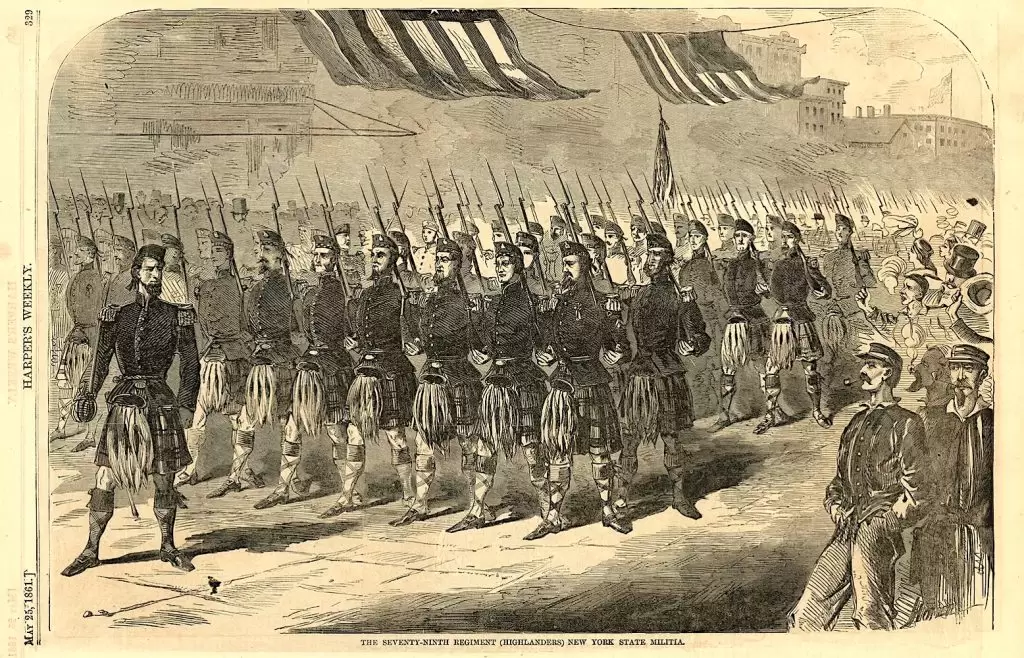
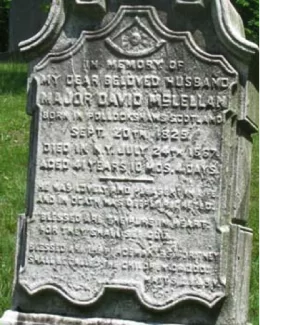
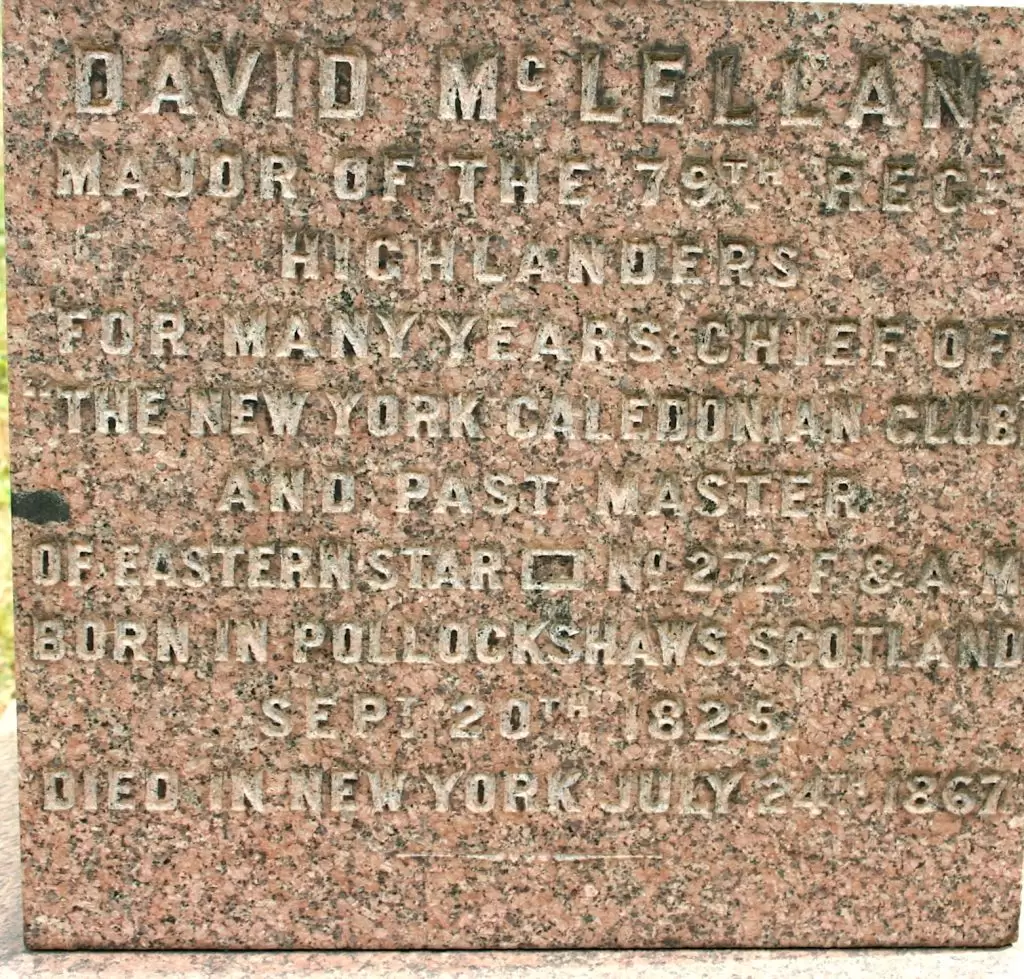
McLEOD (or McCLEOD), ANDREW (1842-1924). Private, 7th New Jersey Infantry, Company F. Although some documents report that McLeod was born in New Jersey, an online biography indicates that he was from New Brunswick, Canada. During the Civil War, he enlisted as a private on September 2, 1861, mustered into Company F of the 7th New Jersey that day, and was discharged for disability on February 2, 1863, at Newark, New Jersey.
McLeod worked for the Waterbury Clock Company for 50 years and belonged to the Ulysses S. Grant Post #327 of the Grand Army of the Republic. In 1880, he applied for and received a pension, certificate 204,244. His last address was 1039 Lafayette Avenue in Brooklyn. He was survived by his wife, Sarah McLeod. According to his obituary in the Brooklyn Daily Eagle, his funeral was held at the Grant Post headquarters at 489 Washington Avenue in Brooklyn. Comrades were requested to come in uniform and that the Grand Army ritual would be observed. His death was attributed to heart disease. Section 142, lot 24362, grave 5.
McLEOD, THEODORUS (or THEODORE, THEODOSIUS) (1844-1920). Corporal, 38th Pennsylvania Militia, Company D; private, 84th Regiment, New York State National Guard, Company F. A New York City native, he began his first two years of higher education at Lafayette College before taking time off to serve in the Union cause. The records of Union College, his second school, indicate that he was a private with the 5th Pennsylvania Volunteers in 1862, but that service is not indicated in his soldier or pension records. After taking time off from his studies, McLeod enlisted as a corporal at Easton, Pennsylvania, on June 29, 1863, mustered into Company D, or Captain Hay’s Company, of the 38th Pennsylvania Militia on July 3 at Reading, and mustered out on August 7, 1863. He re-enlisted in 1864 and served for 100 days in Company F of the 84th New York State National Guard.
After resuming his studies, McLeod graduated from Union College, class of 1865, then studied law in New York City and was admitted to the bar in 1868. He practiced law for several years in Pittsburgh, then returned to New York City where he was a lawyer, notary public and commissioner for Pennsylvania at 55 Liberty Street. On February 5, 1870, he was appointed assistant registrar of the Croton Aqueduct Department. Remaining active in military affairs, he became a captain of the 84th New York State National Guard on May 30, 1870. The 1878 New York City Directory identifies him as a lawyer, notary, and commissioner; the 1894 New York City Directory states that he was an examiner. McCleod was employed at the Custom House for 35 years. In 1907, his application for an invalid pension was approved, certificate 1,139,911. His obituary in The New York Times confirmed his service in the 84th New York National Guard. His last residence was 111 Union Avenue in Clifton, New Jersey. His death was attributed to arteriosclerosis with gangrene. Section 24, lot 6745.
McLETCHIE (or McLATCHIE), ANDREW (1836-1867). Assistant surgeon, 79th New York Infantry. McLetchie, who was originally from Scotland, enlisted as an assistant surgeon at New York City on June 26, 1861, and was commissioned into the Field and Staff of the 79th New York (the Highlanders). He was taken as a prisoner of war at the Battle of First Bull Run, Virginia, on July 21, 1861, and held in confinement at the Liggon Tobacco Factory in Richmond, Virginia, on July 23. The aforementioned factory was confiscated in 1861 and used as a prison for Union soldiers and later as a hospital for Libby Prison. McLetchie was paroled back to Union forces two months later and was discharged from service on April 15, 1862. He apparently re-enlisted at some point and worked as an assistant surgeon at Camp Parole on the outskirts of Annapolis, Maryland.
But, McLetchie’s service was not without controversy. He is named in “Tarnished Scalpels: The Court-martials of Fifty Union Surgeons” (2000) by Thomas Power Lowry and Jack D. Welsh. The authors, in their chapter about McLetchie, note that he was charged with being drunk while in charge of the hospital at Camp Parole from January 6 through March 6, 1863, and again from March 21 through April 4, 1863. He was so drunk on June 10, 1863, that he had to be helped to bed and was also drunk in August 1863 and January 1864. On January 22, 1864, he was charged with “conduct unbecoming an officer” when he left Camp Parole without permission for Annapolis, returned to camp around midnight, drunk, did not know the camp password, and tried to ride his horse past two sentry guards; the next morning he failed to report to headquarters as promised. At his court-martial in January 1864, it was asserted that when McLetchie returned to camp, he was drunk, had thick speech, staggered when he dismounted, could not control his horse, and failed to show up at headquarters. One doctor testified that McLetchie, apparently due to his drinking, was unable to remember patients’ answers to his questions and was unfit and unable to concentrate. Further, he appeared to be drunk, could not express himself clearly, smelled of liquor, and had to be undressed and put to bed by the orderlies on numerous occasions. Two doctors defended McLetchie stating that his “thick speech” was the result of his Scottish brogue and that even a glass of cider flushed his cheeks. Initially found guilty, his dismissal was recommended. However, J. R. Magruder, the mayor of Annapolis, wrote to President Abraham Lincoln urging McLetchie’s reinstatement, noting his bravery at First Bull Run and claiming he was a “worthy gentleman” who had the support of twenty-three officers of the 79th Highlanders. Ultimately, John Hay, one of Lincoln’s two secretaries, noted that the President had removed the “disability” resting on Surgeon McLetchie, making him eligible for reappointment as of May 5, 1864. McCletchie was then contracted to work as a private physician for the federal government in Baltimore for $100.00 per month. Lowry and Welsh noted that he served briefly at Annapolis and Baltimore in 1865 and with the 8th Infantry.
As per his obituary in the New York Herald, Mcletchie was a member of the Caledonian Club; members of that organization were invited to attend his funeral as were members of the 79th who were asked to assemble at the armory in uniform. His last residence was on West 59th Street and Eighth Avenue in Manhattan. In 1891, an application was made for a minor’s pension by his twenty-six year old daughter, Kate Dodson, application 531,984, but it was never certified. The daughter, who communicated with the Pension Bureau for nine years, declared that her father died from disease contracted while in service, but no evidence of service-related disability or treatment was found. Section D, lot 7078, grave 342.
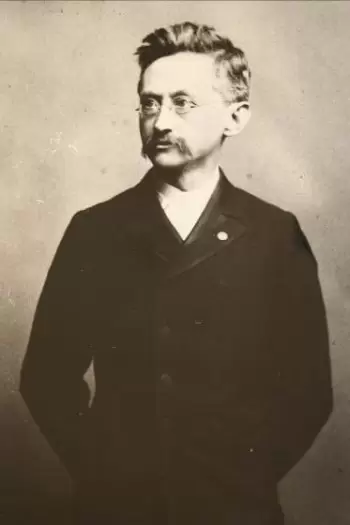
McMAHON, AUGUSTINE R. (1846-1932). Private, 10th New Jersey Infantry, Company A. A native of Ireland, he immigrated to the United States when he was two years old. During the Civil War, McMahon enlisted and mustered into the 10th New Jersey on June 10, 1864, and mustered out at Hall’s Hill, Virginia, on July 1, 1865. he became a naturalized citizen on November 7, 1867.
In civilian life, McMahon was a lawyer who served for some time on the Commissioners of Estimate on the New York Court of Appeals. At the time of his passport application in 1891, he was 5′ 8½” tall with blue-gray eyes, a straight nose, high forehead, dark hair with gray, a rosy complexion and a thin face. On July 3, 1891, he transferred from the Phil Kearny Post #8 of the G.A.R. into the Lafayette Post #140. In 1903, he applied for and received an invalid pension, certificate 1,067,741. His obituary in The New York Times confirms his membership in the Lafayette Post #140 of the G.A.R. He last lived in the Bronx. His death was attributed to senility. Section 55, lot 645.
McMASTER, JR., JAMES (1838-1863). Private, 79th New York Infantry, Company F. Of Scottish birth, McMaster lived at 452 West 25th Street in Manhattan when he enlisted and mustered into the 79th New York (the Highland Guard) on July 6, 1862, at New York City. As per his muster roll, he was a stone cutter who was 5′ 4½” tall with blue eyes, brown hair and a fair complexion. He died of intermittent fever (malaria) on October 19, 1863, at the regimental hospital in Nicholasville, Kentucky. Section 160, lot 11510.
McMENOMY, EDWARD T. (1836-1872). Sergeant, 162nd New York Infantry, Company E. A native of New York City, McMenomy enlisted there as a private on September 5, 1862, and mustered into the 162nd five days later. As per his muster roll, he was a clerk who was 5′ 8″ tall with black eyes, black hair and a dark complexion. He was promoted to sergeant on October 18, 1862, but was reduced in rank to private the next month on November 1 and served in that capacity until he was discharged for disability on March 3, 1863, at Fort Monroe, Virginia. Upon his death, his mother, Eliza McMenomy (who is in the same lot), applied for a pension, application 300,962, but there is no certificate number. Section 41, lot 3267.
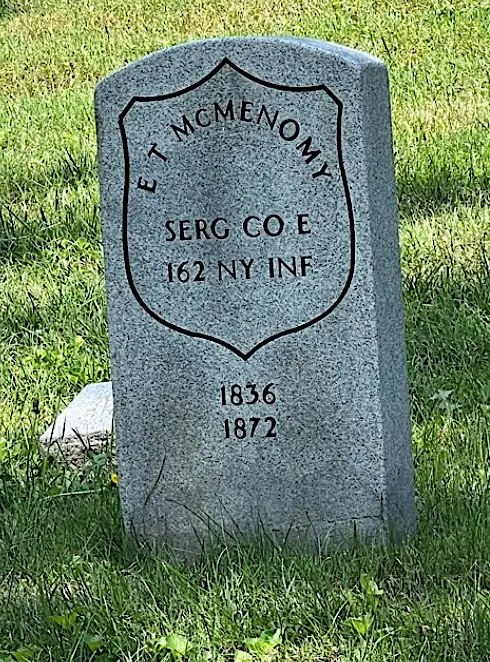
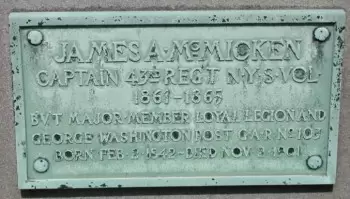
McMICKEN (or McMICKLIN), JAMES ALEXANDER (1842-1901). Major by brevet; captain, 43rd New York Infantry, Company A; private, 7th Regiment, New York State Militia, Company B. McMicken enlisted in the 7th for its 1861 activation, which lasted from April 18, 1861, to June 3, 1861. After re-enlisting at Albany, New York, his birthplace, on August 3, 1861, and mustering into the 43rd Regiment as a second lieutenant, he soon rose through the ranks being promoted to first lieutenant on October 1, 1861, then to captain on July 17, 1862. He fought with the 43rd in the Peninsula Campaign and was at the Battles of South Mountain and Antietam, Maryland. At Antietam, General Hancock ordered him to “clear out” a house full of sharpshooters and was complimented by the general for his successful performance. On November 30, 1862, he was discharged on account of ill health. McMicken also served in the Field and Staff of the United States Army. He was brevetted to major on September 30, 1868, “for gallant and meritorious services.”
In civilian life, McMicken was a member of the Stock Exchange and belonged to the Loyal Legion, Army and Navy Club, and the George Washington Post #103 of the G.A.R. As per his obituary in the New York Herald, members of groups in which he had been a member, including the Washington Post of the G.A.R. (of which he was a senior vice commander), Loyal Legion, and 7th Regiment Veterans’ Association, were requested to attend his funeral. He last lived at 7 Elliot Place in Brooklyn. Section 154, lot 25261, grave 9.
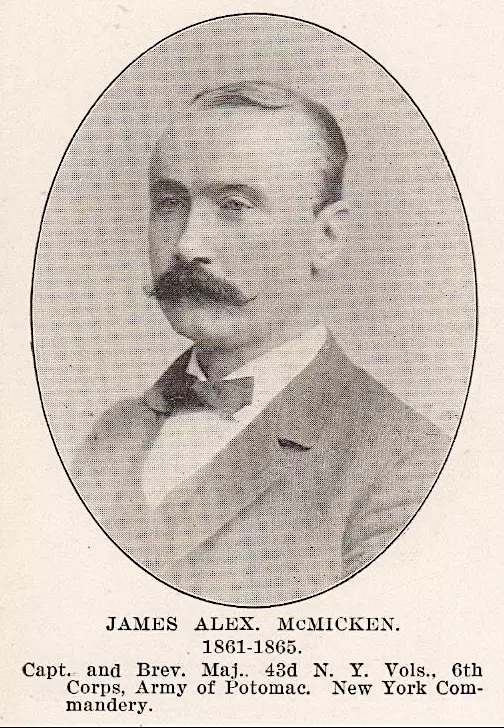
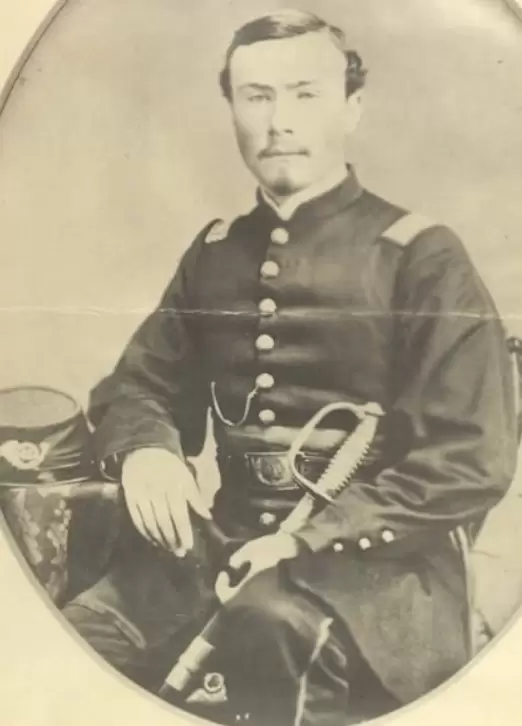
McMILLAN, JOHN (1840-1867). Drummer, 13th Regiment, New York State National Guard, Company A. Enlisting as a drummer at Brooklyn on May 28, 1862, he mustered immediately into the 13th Regiment, and mustered out on September 12 of that year at Brooklyn. He last resided at 313 West 23rd Street in Brooklyn. Originally interred on January 9, 1867, he was re-interred at the current site on June 12, 1902. Section 62, lot 6431.
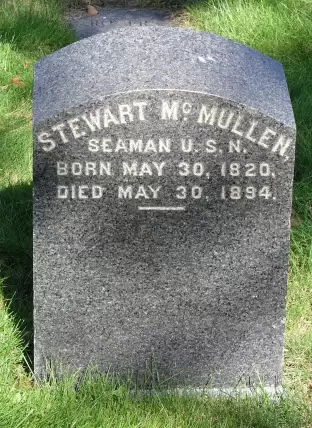
McMULLEN, STEWART (1820-1894). Seaman, United States Navy. McMullen was born in Ireland. He served as a seaman in the United States Navy. He enlisted as a seaman on the USRS North Carolina on June 12, 1861, and was transferred to the USS Roanoke eight days later. He was then transferred to the USS Fort Henry on March 31, 1862, and served on the USS Ohio as of August 14, 1864, from which he was discharged as master-at-arms on September 1. After re-enlisting as a seaman on the USS Vermont on October 13, 1864, he was transferred to the USS Sabine one week later, to the USS Young Rover on October 28, and then returned to the USS Ohio on May 31, 1865, from which he was discharged on August 22, 1865.
McMullen continued his Naval service when he re-enlisted as a seaman on the USRS Vermont on January 11, 1867, and transferred to the USS Yantic on January 31, to the USS New Hampshire on January 10, 1868, then returned to the USRS Vermont on February 19, 1868, from which he returned to the USS New Hampshire on April 15, 1868, the USS Savannah on May 10, 1868, from which he was discharged on August 28, 1868. He re-enlisted as a seam on the USRS Vermont on May 5, 1869, was transferred to the USS Sabine on June 7 and to the USRS Ohio on August 3, 1870 before returning to the USRS Vermont five days later. McMullen was sent to the USS Guerriere on September 5, 1870 and discharged from there on March 22, 1872. Re-enlisting as a seaman and returning to the USRS Vermont for assignment on May 7, 1872, he was transferred to the USS Saugus on May 22, then to the USS Ossipee on July 9, 1874, to the USS Colorado on July 31, 1874, and discharged on May 24, 1875. Continuing in service, he re-enlisted as a seaman on the USRS Vermont on August 23, 1875, was transferred to the USS Frolic on September 21, 1875, and then served on the USS Brooklyn as of December 4, 1875, the USS Marion as of April 17, 1876, the USS Tennessee as of May 11, 1878, and the USS Colorado from July 7, 1878, until his discharge on August 23, 1878. He re-enlisted on the USS Colorado on May 12, 1881, and transferred to the USS Vandalia on June 11, 1881, from which he was discharged on May 29, 1884.
In 1890, he applied for an invalid pension citing failing eyesight, rheumatism, and general disability, application 22,159; his application was rejected. His last residence was at 194 Seventh Avenue in Manhattan. McMullen’s death certificate cites rheumatism as the primary cause of death. His service is inscribed on his gravestone. Rachael McMullen, who is interred with him, applied for and received a pension in 1894, certificate 10,374. Rachel had been previously married to Robert McMullen, Stewart’s brother, who died in 1875; she and Stewart McMullen were married in 1882. Section 135, lot 27263, grave 2311.
McMURRAY, ALBERT K. (1824-1910). First lieutenant, 106th New York Infantry, Company I; sergeant, 7th New York Cavalry, Company D; 2nd New York Mounted Rifles, Company D. A native of New York, he enlisted as a sergeant at Ogdensburgh, New York, on October 6, 1861, and mustered into the 7th New York Cavalry on November 6. He was reduced to the rank of private on March 14, 1862, before mustering out on March 31 at Washington, D.C. Later that year, he re-enlisted at Ogdensburgh as a first lieutenant on August 16, was commissioned into the 106th New York eleven days later, and was honorably discharged on January 13, 1863. As per the 1863 Draft Registration, he was living in St. Lawrence, New York, where he was employed as a painter. McMurray also served in the 2nd New York Mounted Rifles, Company D.
After the war, McMurray was a member of the G.A.R.’s Ulysses S. Grant Post #327. He may have been the Albert K. McMurray who obtained patent 91,469 for an improved rocking chair and patent 227,698 for an “apparatus for collecting natural mineral water and charging liquids with natural carbonic acid gas.” In 1891, his application for an invalid pension was granted, certificate 902,536. McMurray was admitted to the National Home for Disabled Volunteer Soldiers in Dayton, Ohio, in 1899. At that time, he was a widower who was 5′ 9″ tall with fair skin, blue eyes, and dark hair. He listed his occupation as brush-maker and noted that he suffered the effects of the grippe which he had four months prior to his admission to the facility and had age-related debility. His application noted that he would be discharged to Denver, Colorado.
At the time of the 1900 census, McMurray lived in Sanilac, Michigan and was still employed as a brush-maker. His last residence was in San Diego, California, where his death was listed in the San Diego Union. As per his obituary, he belonged to the San Diego County Civil War Veterans and the Heintzelman Post #33 of the G.A.R.; members of the G.A.R. were invited to attend his funeral. He died on August 21, 1910, and was interred at Green-Wood on May 11, 1911. Section 87 lot 1715, grave 7.
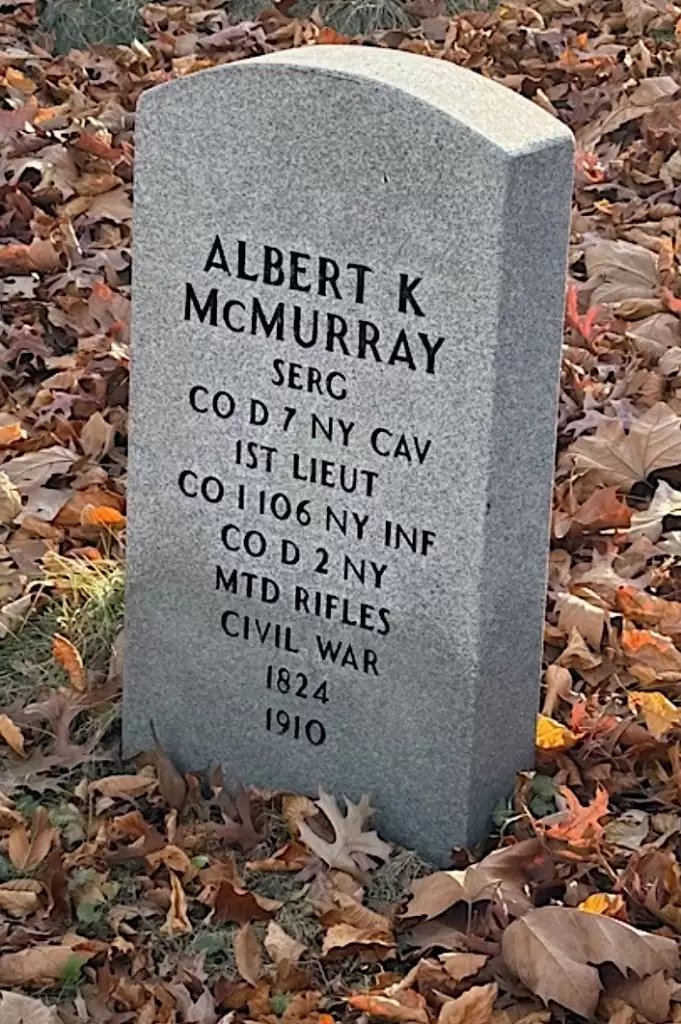
McMURRAY (or MCMURREY), JR., DAVID (1847-1866). Private, 5th Light Artillery, United States Army, Battery B; 5th Veteran Infantry, Company E. McMurray, a Brooklyn native, first served as a private in the 5th Light Artillery. On May 31, 1865, he was transferred into the 5th Veterans and was discharged at Hart’s Island, New York Harbor, on August 21, 1865. He was listed as absent and sick at the time his unit mustered out. According to a descendant, he died at his home at 68 Gansevoort Street in Manhattan from typhoid fever while on furlough on October 1, 1866. Section A, lot 9146, grave 160.
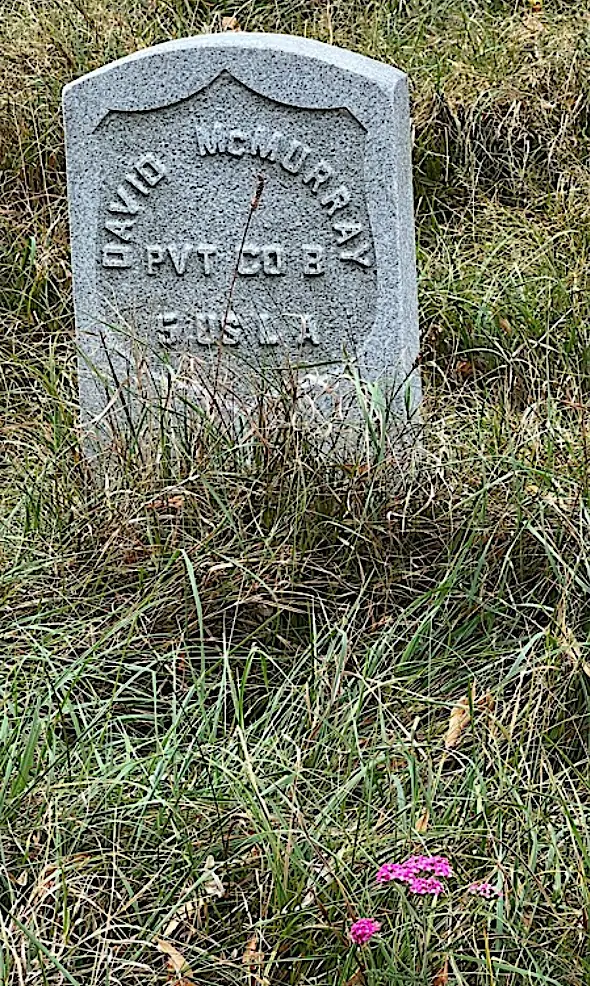
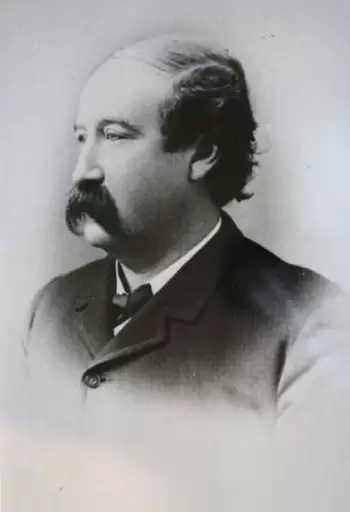
McMURRAY, ROBERT KERMIT (1837-1910). Second lieutenant, 13th Regiment, New York State Militia, Engineers, and Company E. A Brooklyn native, his father owned a line of clipper ships that docked in Brooklyn. As per his obituary in the Brooklyn Daily Eagle, which confirms his Civil War service, he received a scientific education both in the United States and abroad. After enlisting at Brooklyn as a private on April 23, 1861, he mustered into the 13th Regiment, Engineers, for three months on May 17. As per his obituary in The Locomotive, the periodical of the company for which he worked, he was assigned almost immediately by General Benjamin F. Butler to superintend the construction of the first military railroad in the United States. McMurray commanded 3,000 troops on this project. This railroad extended from the wharves of the military academy at Annapolis, Maryland, to the juncture of the Elk Ridge Railroad, two miles away. That account notes that in four days, the land was surveyed, the road-bed leveled, and the railroad constructed and tested by the first train. His obituary in the Brooklyn Daily Eagle relates the same achievement but notes that the task was accomplished in twenty-four hours. McMurray was thanked by the War Department for this monumental engineering effort. He mustered out on August 6, 1861. In 1862, when his unit was reactivated and part of the 13th National Guard, he was promoted to second lieutenant on May 28, commissioned into Company E the same day, participated in several skirmishes near Suffolk and Black Water, Virginia, and mustered out on September 12 at Brooklyn. He returned the next year to the same company, was commissioned in on June 20, 1863, and mustered out on July 21 at Brooklyn.
In civilian life, McMurray joined the Hartford Steam Boiler Insurance Company of New York as of December 24, 1867, ultimately becoming its chief inspector. (His brother was the special agent for the same company in Saratoga, New York, as noted in Robert’s obituary in The Saratogian.) McMurray was the first to advocate welded rather than riveted boilers and planned the 1890 construction of the tall smoke stack for the Clark Thread Company’s factory in Newark, New Jersey. Although initially criticized by some engineers, the tall chimney construction became commonplace. He also advocated steam boiler insurance, primarily as a preventive measure. At the time of the 1880 census, he was living in Castleton, Staten Island, and was employed in accident insurance. He listed his occupation as boiler inspector when he mustered into the G.A.R. on July 3, 1891. In 1904, his application for an invalid pension was granted, certificate 1,098,944. On February 22, 1906, he was honored by his company and received the honorary title, “Dean of Steam Boiler Inspection.”
A man of many pursuits, McMurray owned a yacht, the Aeolus, was a member of the New York Yacht Club, the 13th Regiment Veterans’ Association, the Freemasons (he was a 32nd degree Scottish Rite Mason), the Ulysses S. Grant Post #327 of the G.A.R., and the Society of Old Brooklynites. The Locomotive (Volume 28, 1911), a periodical of the Hartford Steam Boiler Inspection and Insurance Company, confirms his Civil War service and honors McMurray’s life in his obituary by remarking on his “estimable personal qualities” and “the breadth and soundness of his professional attainments.” His last address was 435 Washington Avenue in Brooklyn. He died after a short bout of pneumonia. An article in the Niagara Falls Gazette on May 31, 1934, “Lloyd’s Register Shows Aged Yachts Are Still In Use,” noted that McMurray’s yacht, originally built for him by Sammy Ayres in 1880 and not rebuilt, was still plying the waters of New York Harbor under the flag of the Crescent Athletic-Hamilton Club. Section 177, lot 13619, grave 2.
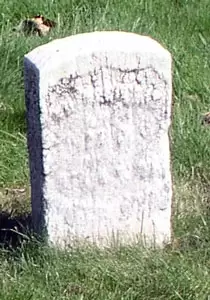
McMURRAY, WILLIAM (1843-1900). Private, 9th New York Infantry, Company G. McMurray was originally from Fort Lee, New Jersey. He enlisted as a private at New York City on May 3, 1861, and mustered into the 9th New York, also known as the Hawkins’ Zouaves, the next day. He mustered out of service on May 20, 1863, at New York City. In civilian life, he was the stage carpenter for the pantomime artist and clown George L. Fox. The 1886 New York City Directory lists him as a carpenter.
On May 4, 1900, the New York Herald and The New York Times, both of which confirmed McMurray’s Civil War service, reported on his circumstances of his death. He came home from work suffering from a nose bleed that his daughter temporarily stopped with cold towels. However, he awoke during the night with his bedclothes soaked in blood. Again, his daughter stopped the hemorrhage but the next day, two doctors were unable to stop the bleeding and he bled to death. His last residence was 309 West 119th Street in Manhattan. Shortly after his death in 1900, his widow applied for and received a pension, certificate 510,025. Section 136, lot 28307, grave 378.
McNALLY, JOHN JONES (1838-1894). Private, 4th New York Infantry, Company K. A native of New York City, McNally enlisted there on April 23, 1861, and mustered in on May 2. His muster roll notes that he was paid by the State $3.24 from April 23 to May 2. He was discharged for disability on August 10, 1862, at Suffolk, Virginia. According to the 1870 census, he was a machinist; the 1880 census notes that he was a janitor. He last lived at 334 East 37th Street in New York City. McNally’s death was caused by apoplexy. Section 135, lot 27273, grave 1419.
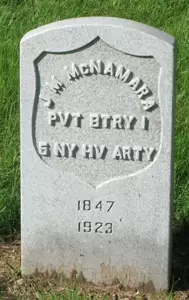
McNAMARA, JUSTIN M. (also enlisted as WILSON, JOHN) (1847-1923). Private, 5th New York Heavy Artillery, Battery I. A native of New York, McNamara enlisted as a private under the alias “John Wilson” at Jamaica, mustered into the 5th New York Heavy Artillery that same day, and mustered out on June 24, 1865, at Harpers Ferry, West Virginia.
McNamara was the subject of an article in The New York Times on June 17, 1872. As per that account, McNamara’s wife, Mary McCarthy, came home drunk and found her husband sleeping on the roof of their house at 252 Delancey Street. After waking him, an altercation ensued and the two either lost their balance or were dragged off the roof, falling forty feet to the sidewalk. McNamara suffered a broken leg; McCarthy was slightly injured; another paper, the Jamestown Daily Journal, incorrectly reported that they were fatally injured.
The 1875 New York City Directory lists McNamara as a caulker. In 1892, he applied for and received an invalid pension, certificate 860,251. In 1897, he was listed as a first class wood caulker at the New York Navy Yard. McNamara was a member of the George G. Meade Post #38 of the Grand Army of the Republic; members of the Meade Post were invited to attend his funeral. An article in The Saratogian on August 22, 1918, reported that McNamara and another Civil War veteran vacationed in Saratoga Springs. That article, which focused on their wartime service, incorrectly identified their regiment as the 5th New York Cavalry. His last residence was 41 Greenwich Avenue in Manhattan. According to his obituary in The New York Times, he died after a long illness. Section 15, lot 17263, grave 916.
McNARY, WILLIAM HENRY (1831-1890). Brigadier general by brevet; colonel, 158th New York Infantry; engineer, 13th New York Infantry. Born in Brooklyn, McNary’s obituaries in the New York Herald, Brooklyn Daily Eagle and The New York Times report that he served with the 14th Regiment prior to the Civil War with the rank of captain. In civilian life, he was a machinist and inventor; one of his patents (1861) was for a knitting apparatus. His passport application of 1861 notes that he was 5′ 9½” tall with gray eyes, dark auburn hair, fair complexion, a prominent nose and forehead, and medium nose. During the Civil War, he enlisted at Brooklyn as an engineer on May 28, 1862, mustered immediately into the Field and Staff of the 13th New York, and mustered out on September 12 at Brooklyn. He was then immediately commissioned into the 158th New York as its lieutenant colonel with rank from August 29. As per his muster roll, he was an engineer who was 5′ 10″ tall with gray eyes, brown hair and a light complexion. The 158th Regiment was primarily stationed in North and South Carolina. He was promoted to colonel on April 16, 1865, and mustered out on June 30, 1865, at Richmond, Virginia. He was brevetted brigadier general of volunteers on March 13, 1865, “for gallant and meritorious services.”
In his field report of April 15, 1865, from Appomattox Court-House, McNary wrote about the charge on Fort Gregg, Virginia, on April 2, “…At the storming and capture of Fort Gregg, this regiment, together with the Eighty-ninth New York Volunteers, advanced in the face of a very heavy front fire, and after a bloody and determined resistance on the part of the enemy the fort was carried at the point of the bayonet…The staff of the State colors and both flags bear many marks of the enemy’s fire…” Shedding more light on that action, Colonel Harrison Fairchild, commanding the 89th New York, cited McNary’s leadership and the actions of the 158th: “…they charged the works, capturing 300 prisoners, one six-gun battery, horses, harness, and appurtenances, two battle-flags, all of which was turned over to the provost-marshal of the Sixth Corps.”
McNary’s obituaries note that he was an advocate of the formation of the G.A.R., was the first vice commander of the organization, and was a member of Rankin Post # 10. Because of McNary’s prominence in the G.A.R., his portrait was displayed at the Rankin Post’s headquarters. The 1870 census lists him as an inventor. He often traveled to Europe to sell patents for his knitting machines in Germany, France and England. In 1881, his wife and daughter accompanied him and they remained on the continent for nine years. When McNary returned to Brooklyn in 1890, he brought home a collection of souvenirs including a magnificent basket-hilt sword with a 32 inch flexible blade (photos below) crafted by Nathaniel Jeffrey, a jeweler and sword-cutter to the king during the 1750s. (The padding in the photo was added later). He last lived at 191 State Street in Brooklyn. McNary died of heart failure after a bout of pneumonia; a delegation from the Rankin Post attended his funeral. Josephine McNary, who is interred with him, applied for and received a widow’s pension in 1890, certificate 302,065. His sword was passed on to his descendants. Section 12, lot 12367.
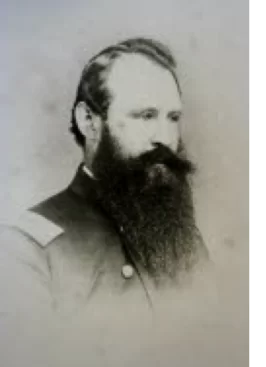

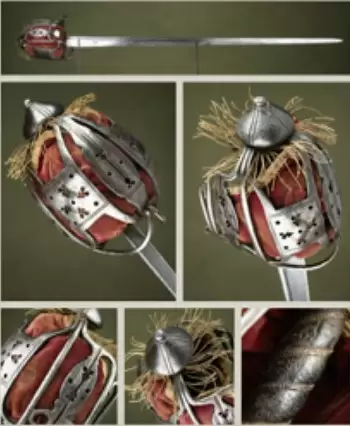
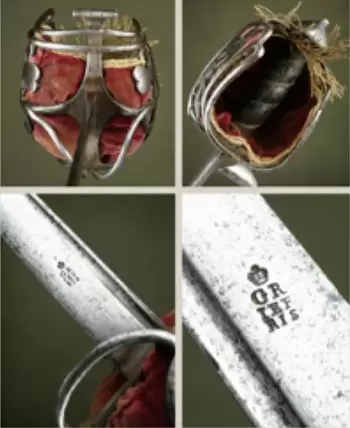
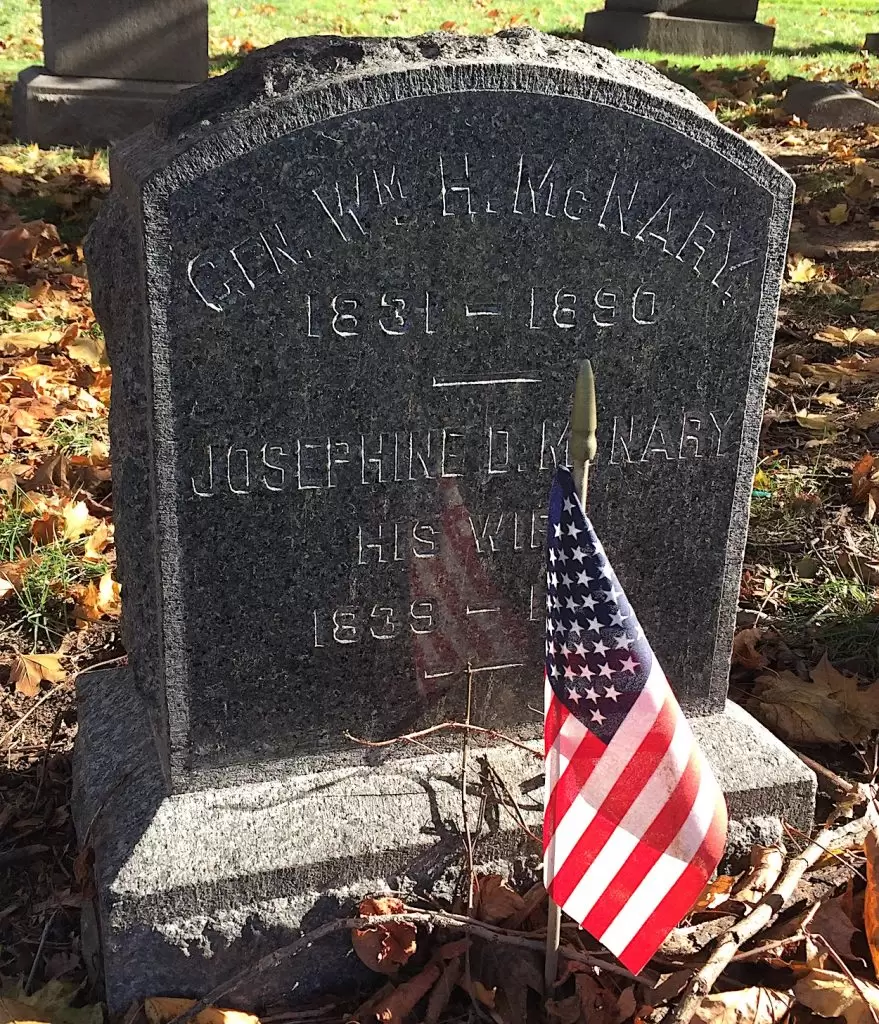
McNEIL, DANIEL (or JOHN) (1814-1883). Surgeon, 21st New Jersey Infantry. A native of Washington, New York, he enlisted as a surgeon on September 12, 1862, and was commissioned into the Field and Staff of the 21st New Jersey three days later. He mustered out on June 19, 1863, at Trenton, New Jersey. The History of Homeopathy and Its Institutions in America by William Harvey King, which reports that McNeil was a surgeon “during the rebellion,” lists him as a physician who practiced in West Hoboken, New Jersey, in 1865 and in Jersey City in 1875. The 1880 census indicates that he was a physician whose personal estate was $800; he is listed as a physician in the 1883 Jersey City Directory. As per one obituary, in which he was referred to as Dr. John McNeil, he was one of the commissioners of the County Board of Health in Jersey City. That obituary and his obituary in the New York Herald confirm his Civil War service. His last residence was 555 Palisade Avenue in Jersey City, New Jersey. Nephritis was the cause of his death. He was survived by his wife, Sarah Holmes McNeil, who is interred with him, and four children. Section 145, lot 24076.
McNEILL (or McNEIL), JOHN (1834-1889). Captain, 84th New York (14th Brooklyn) Infantry, Company H. McNeill, who was born in Willsborough, Ireland, was a painter by trade who immigrated to the United States in about 1854. As per his obituary in the New York Herald, he joined the 14th regiment in October 1856, and was promoted to corporal in November 1858. During the Civil War, McNeill enlisted at Brooklyn on April 18, 1861, as a private, and mustered into the 14th on May 23. On July 21, 1861, he was taken as a prisoner of war at Bull Run, Virginia, was confined at Richmond, Virginia, two days later, and exchanged on an unknown date. As per his muster roll, he was captured while on picket duty at Falls Church, Virginia, on November 18, 1861, and exchanged on December 6, 1862. His muster roll notes that he returned to duty on December 16, 1862. He rose to first sergeant on August 4, 1861, to second lieutenant on March 2, 1862, but was not mustered in at that rank, and became a captain on October 24, 1862. His obituary notes that he was with the 14th at the Battle of Gettysburg, Pennsylvania, on July 1-3, 1863. McNeill mustered out on June 6, 1864, and according to his obituary, was made a brevet major of U.S. Volunteers after his discharge.
The 1870 census reports that McNeill was a painter and he is listed as a painter in the 1883 Brooklyn Directory. He continued his service with the 14th throughout his lifetime and was elected major in 1886, a position he held up to his death. His tombstone is inscribed with the dates of his long-term service in the 14th. He last lived at 844 Fulton Street in Brooklyn where he died after a short illness. Section 109, lot 438.
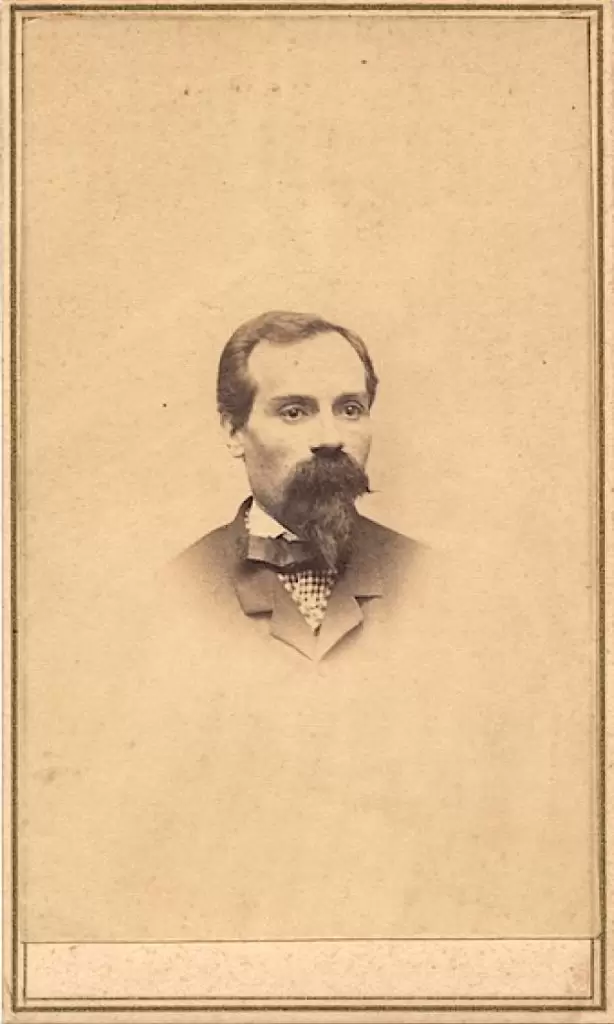
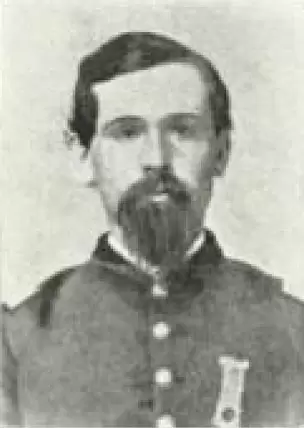
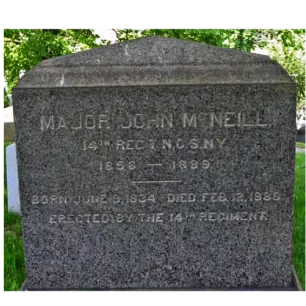
McNEILL, THOMAS (1832-1885). Second lieutenant, 52nd Regiment, New York State National Guard, Company D. Of Irish origin, he enlisted at Brooklyn as a second lieutenant on June 19, 1863, and was commissioned into the 52nd National Guard that day. The 52nd was ordered to Harrisburg, Pennsylvania, two days later to meet the Confederate invasion, took part in a skirmish at Oyster Point, Pennsylvania, on June 28, and mustered out at Brooklyn after serving 30 days, and after the invasion had been turned back, on July 25. As per the 1880 census and the 1882 Brooklyn Directory, he was a painter. His last address was 160 Washington Street in Brooklyn. He died of chronic Bright’s disease. Section 146, lot 25626.
McNIFF (or MacNIFF), LOTHIAN (or LATHIAN) (1846-1907). Private, 84th Regiment, New York State National Guard, Company A. Born in Tivoli, New York, he was a drummer in the 84th New York National Guard serving for 30 days in 1863. In 1864, he served as a private in the 84th New York National Guard for 100 days. This regiment was raised in New York City on July 12, 1864, and mustered out on October 29. His last service was with Sheridan in the Shenandoah Valley.
After the Civil War, he was employed by the commission firm of Dunham & Buckley. He is listed in the 1880 census as a store clerk. He applied for an invalid pension in 1904, application 1,321,430. A member of the Winchester Post #197 of the G.A.R., he also belonged to the Long Island Council, Royal Arcanum. A secretary and librarian for many years at the Sunday school of Lafayette Avenue Presbyterian Church, he died of apoplexy at his home, 440 Lafayette Avenue in Brooklyn. Section 173, lot 21653.
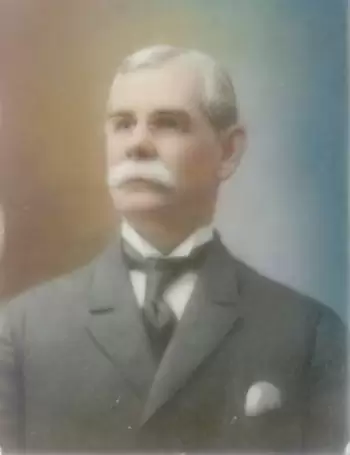
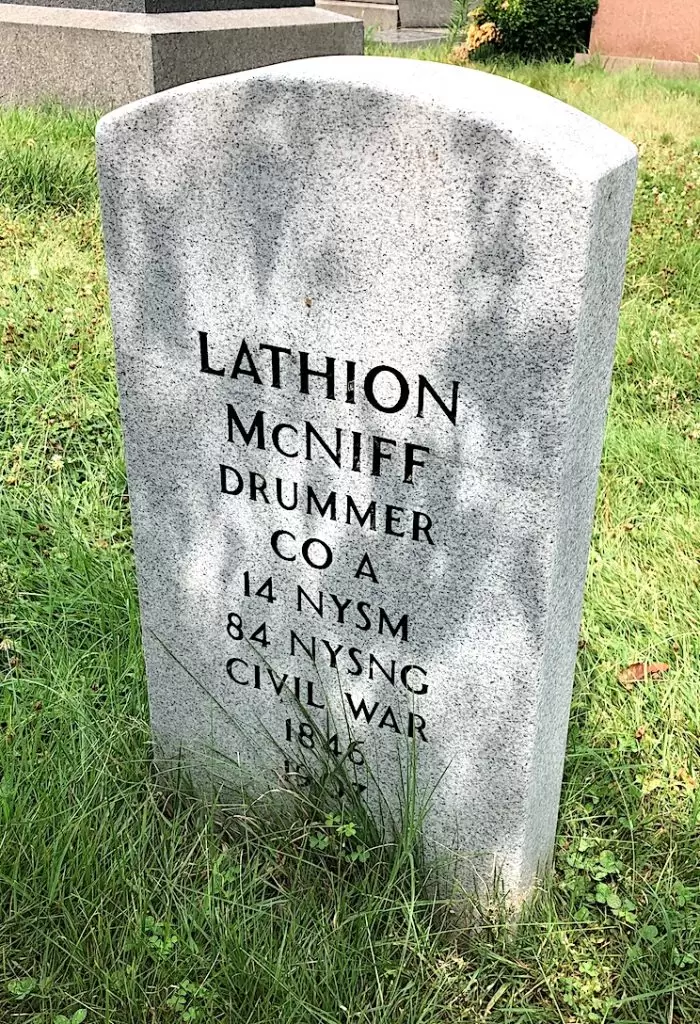
McNISH (or MacNEISH), ANDREW (1840-1916). Landsman, United States Navy. McNish was born in Cutchogue, Suffolk County. An article in the Brooklyn Daily Eagle on August 17, 1859, notes that McNish was elected as a plumber with the Fire Department on Warren Street in Brooklyn. The 1860 census indicates that he was a plumber’s apprentice. During the Civil War, he enlisted at New York City as a landsman on November 6, 1862, and served in the United States Navy until he was discharged at Brooklyn in December 1863. According to his enlistment records, he was a baker (like his father). On September 23, 1864, he re-enlisted as a landsman and returned to the Navy, served on board the USS Pawtuxet, andwas discharged “at the end of war” on July 5, 1865, at Brooklyn.
According to the 1880 census, McNish was living in Albany, New York, where he was a railroad conductor; the family moved to Peekskill, New York in 1892. The Highland Democrat in an article on December 17, 1892, reported that McNish was the officer of the day for the Abram S. Vosburgh Post #95 of the G.A.R. in Peekskill; he was re-elected to that position in December 1894. In April 1893, his application for a plumber’s license in Peekskill was approved; his shop, specializing in plumbing and gas and steam fitting was at 826 South Street where he advertised having thirty years’ experience in that trade (see ad below). The 1900 census states that he was living in Brooklyn and working there as a plumber; he is listed as a plumber in the 1901 Brooklyn Directory and as a steamfitter in the 1904 Brooklyn Directory.
McNish was a steam-fitter at the time he entered the National Home for Disabled Volunteer Soldiers at Hampton, Virginia, on September 28, 1911. At that time, he was 5′ 9″ tall with brown eyes, gray hair and a dark complexion. He was discharged from that facility on August 12, 1916. He had a pension from the Navy under certificate 34,736. According to his obituaries in the Brooklyn Daily Eagle and the Brooklyn Standard Union, he was a member of the Brooklyn Volunteer Firemen’s Association, Waterwitch Hose #8; members were invited to attend his funeral. His last residence was 884 Flatlands Avenue in Brooklyn. Rose McNish, his second wife, applied for and was granted a widow’s pension, certificate 820,674. Section 82, lot 1746.
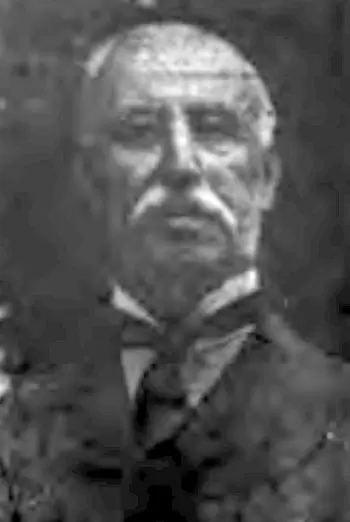

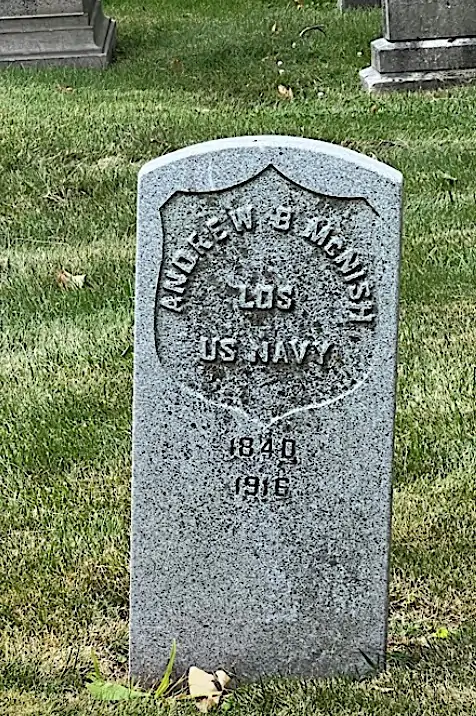
McPHAIL, DANIEL H. (1813-1884). Lieutenant colonel by brevet; major and additional paymaster, United States Volunteers Paymaster’s Department. Born in Baltimore, Maryland, he was appointed second lieutenant of the United States Army by President Andrew Jackson in 1837. While serving with the 5th Infantry, U. S. Army at Fort Snelling, the Magazine of Western History, Volume 11, reports that McPhail, short in stature but with a temper, had an incident related to the famous slave, Dred Scott. Apparently, Surgeon Emerson of the 5th Infantry brought Dred Scott with him to Fort Snelling, Minnesota, bought Scott a wife, and tried to secure a stove for them as winter approached in 1837. McPhail, who was quartermaster in charge of supplies, told Emerson that Scott would have to wait until others were accommodated. McPhail was then insulted by Emerson and proceeded to strike the surgeon in the face breaking his eyeglasses and bruising his nose. An uproar ensued when Emerson ran to his quarters to get a pair of pistols but the dispute subsided and was referred to as a “tempest in a teapot.”
McPhail served in the 5th Infantry of the U.S. Army from 1837-1849, including service in the Mexican War as a captain as of July 10, 1846, and was brevetted to major on August 20, 1847, for “meritorious conduct in the Battles of Contreras and Churubusco, Mexico.” As per his obituary in the New York Tribune, he served under Generals Taylor and Scott in numerous battles and his bravery was evident: “In one engagement his uniform was pierced with bullet holes in the front and across the shoulders.” That obituary goes on to note that the city of Baltimore presented him in February 1849 with a sword with a silver scabbard (photo below), made especially for him by Baltimore cutler Samuel Jackson, and inscribed with the names of the engagements in which he took part (Monterey, Vera Cruz, San Antonio, Churubusco, Molino Del Ray, Chapultepac, Garita de Belen, Garita de San Cosine, Mexico City). The octagon-shaped hilt of the sword was mounted with a silver head of George Washington. He resigned his commission on April 30, 1849, and lived in Baltimore. On October 16, 1852, he wrote an angry letter to the editor of the Brooklyn Daily Eagle noting that his name was mocked as “Mr. McPhay, a locofoco orator from Baltimore,” who supported Franklin Pierce for president. In 1860, although an ardent Democrat, he was one of the 1,016 Baltimoreans, a city with many Southern sympathizers, who cast a ballot for President Abraham Lincoln.
At the onset of the Civil War, McPhail was offered a commission by General Scott and served on the staff of General Rosencrans with Garfield and Hayes. (See his letter of acceptance below.) He entered service as a major on June 1, 1861, and was commissioned into the United States Volunteers and promoted to major and additional paymaster that day. McPhail was involved in a controversial case involving Judge Richard Bennett Carmichael of Baltimore who was accused of tampering with Union supporters during the November elections and of being a Southern sympathizer. McPhail, the Deputy Provost Marshal of the Baltimore Military Police, accompanied by two policemen, went to Carmichael’s courtroom to arrest him. Carmichael, according to John W. Crisfield in the Collected Works of Abraham Lincoln, Volume 5, attacked one of the policemen. In the altercation that ensued, McPhail was “compelled to use force to secure him, and he unluckily received a superficial wound on the head….” Carmichael was taken into federal custody in late May 1862; eventually, he was released by order of Secretary of War Edwin Stanton on December 2, 1862. Subsequently, he was the chief paymaster at Wheeling, West Virginia. He was promoted by brevet to lieutenant colonel on March 13, 1865, “for faithful and meritorious service,” and remained in service at New Orleans, Louisiana, and Charleston, South Carolina, until he resigned on January 1, 1869. The 1880 census lists him as living with his sister in Brooklyn but not employed. He last lived at 43 Sand Street in Brooklyn. His death was attributed to general debility. Section 23, lot 4049.
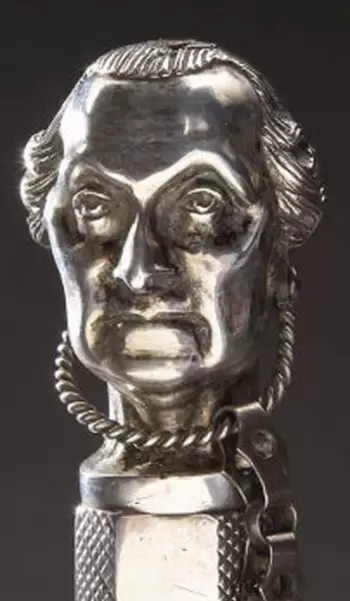
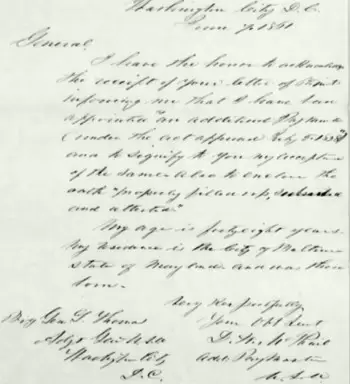
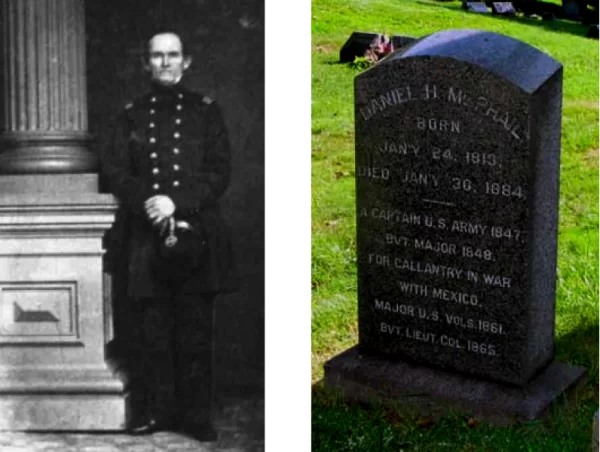
McQUEEN, JAMES (1831-1861). Captain, 15th New York Engineers, Company B. Born in Scotland, McQueen grew up to be a firefighter with the Neptune Engine Company #2 on Hicks Street in Brooklyn before the Civil War. In addition, he was active in Democratic Party politics and, according to an article in the Brooklyn Daily Eagle on June 14, 1855, he was one of the men from the Democratic Central Union Club who was chosen to serve as “banner guard” at a planned march in support of the presidential nomination of James Buchanan and John C. Breckinridge. On June 17, 1861, he enlisted as a captain at Willets Point, New York, and was immediately commissioned into the 15th Engineers.
The circumstances of his death are confusing in the written reports. On September 17, 1861, the Brooklyn Daily Eagle reported that McQueen had been injured and that, with no accurate reports on his injury, it was assumed that he was wounded in a skirmish with the pickets of the enemy. The article concluded, “Capt. McQueen is too good a man to lose at the juncture of affairs about Washington. His loss will be a sad one for the regiment to which he is attached, for no braver man exists than he is.” As per his soldier record and the official list of Volunteer Deaths, he died on September 18, 1861, at Alexandria, Virginia, from an accidental skull fracture; the Brooklyn Daily Eagle reported on September 19 that he died from a fall from his horse. The Brooklyn Daily Eagle, in that obituary, noted that he was a prominent politician in the Democratic Party and was held in high esteem by those in his party and by his friends. On September 24, 1861, a subsequent article in the Brooklyn Daily Eagle indicated that he died in an Army hospital from the effects of a bayonet wound suffered in an encounter with the enemy’s pickets. That article goes on to say that the Brooklyn Common Council had appropriated $250 to defray the expenses of McQueen’s funeral and that a committee headed by Francis B. Spinola (see) would draft a testimonial to commemorate McQueen’s service in the Army.
In advance of his funeral, that committee directed preparations to assure proper respect and observance of military orders for McQueen’s remains. McQueen was temporarily placed in a vault at Alexandria where he was embalmed; the New York Committee telegraphed that it would begin the process of returning his body home. The Fire Department, of which McQueen was a member, would be invited to the funeral and the military would be asked to participate. Members of the Board of Aldermen as well as ordinary citizens and family would also attend the funeral at City Hall. Alderman Strong of the Common Council indicated that McQueen was the first officer from Brooklyn who lost his life in the line of duty and that condolences were necessary for his aged parents for whom he was the sole support. Strong said, “There was no better incentive to bravery on the battlefield than the consciousness that Brooklyn would take care of the families of those who fell in defence of their country.”
On September 29, the date that the funeral took place, McQueen’s elaborate metal coffin was brought to Brooklyn’s City Hall. The funeral procession was accompanied by the tolling of fire bells. The procession moved toward the grave and flags at Brooklyn’s City Hall and other public sites were lowered to half-staff. Among those in the procession were a detachment of police, members of his regiment, pall-bearers, and an honor guard consisting of members of the Engineer Corps. In addition, the procession included McQueen’s parents, clergy, and members of the Common Council and Fire Department. The following resolutions were adopted by the Common Council and were reprinted in an article about his funeral, which was held at Brooklyn City Hall, that appeared in The New York Times on September 30:
Resolved, that the Common Council has heard, with feelings of deep regret, of the death of Capt. JAMES MCQUEEN, of Company B, Fifteenth Regiment, N.Y.S.V., who was killed at the seat of war in Virginia, in discharge of his duty.
Resolved, That we bow in submission to the terrible decree by which our country has lost a brave officer, Brooklyn an honorable citizen, and the aged parents of the deceased their only main stay.
Resolved, That we mingle our grief with the sorrow-stricken father and mother, and hereby tender to them, in this their hour of trial, our heartfelt sympathy and condolence.
Resolved, That a committee of three be appointed to take into consideration the appropriateness of offering to the aged parents of the deceased such testimonials, in the name of the city, as may to some extent manifest their appreciation of the virtue and services of the gallant dead.
He was interred on September 29. The New York Herald, in its article about the funeral, of which Spinola was the grand marshal, noted that the members of the procession wore white satin badges bound with black crepe and that the engineers of the Fire Department had their trumpets draped in crepe. Ordinary citizens gathered in the vicinity of the procession route “to indulge in the melancholy duty of paying a last tribute to the dead soldier.” The Herald reported that thousands of people thronged the streets and that a deep feeling of sympathy was pervasive. The hearse was drawn by four black horses bedecked with the trappings of mourning. As per The New York Times in its report of McQueen’s funeral at City Hall, members off the Board of Alderman, military, firemen and private citizens attended. The Times included the aforementioned resolutions in its article. As per the Brooklyn Daily Eagle, the procession moved through Montague Place, Clinton Street, Hamilton Avenue, Third Avenue and then to 24th Street, a route thronged with 8,000-10,000 spectators. Following the funeral services at the gravesite, members of the 13th regiment fired off a final salute to McQueen. The Brooklyn Daily Eagle reported that the Reverend Henry Jackson Van Dyke, a controversial figure who preached about the Biblical basis of slavery, presided over the military funeral rites. Section 105, lot 13104.
McVEY, ROBERT (1822-1873). Private, 119th New York Infantry, Company F. Of Irish origin, the 1860 census reports that he was a laborer. During the Civil War, McVey enlisted as a private on August 5, 1862, and mustered into the 119th Infantry on September 5. As per his muster roll, he was a baker who was 5′ 7″ tall with blue eyes, brown hair and a medium complexion. On May 2, 1863, he was wounded in action at the Battle of Chancellorsville, Virginia. He mustered out on June 7, 1865, at Bladensburg, Maryland. Trow’s New York City Directory for 1867-68 and the 1870 census state that he was a laborer; the New York City Directory for 1872 indicates that he was employed as a baker. His last address was 49 Norfolk Street in Manhattan. The cause of his death was pneumonia. Section 17, lot 17245, grave 367.
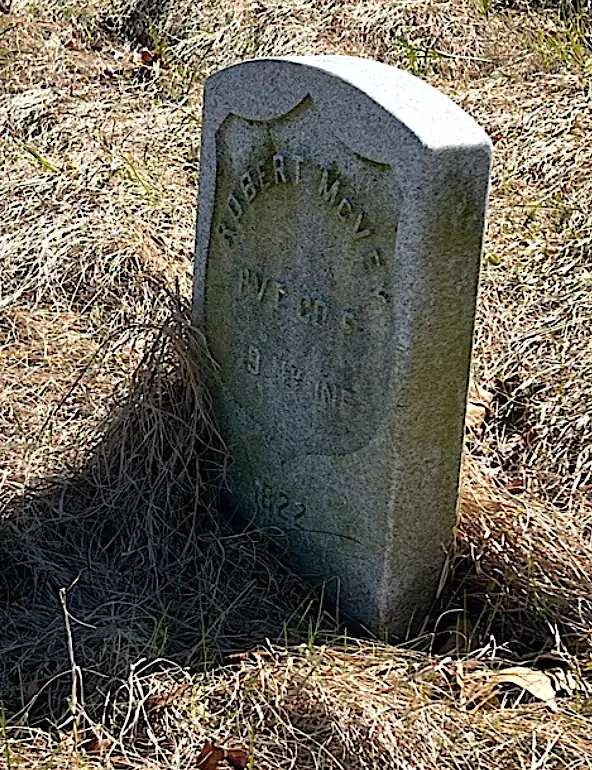
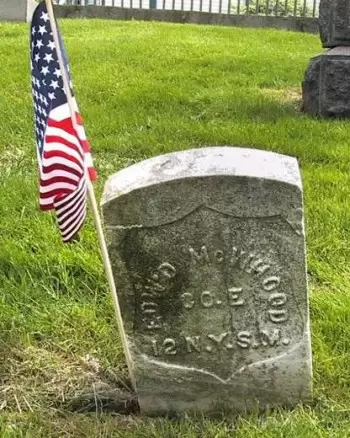
McWHOOD (or McELROOD), EDWARD (or EDWIN) (1843-1924). Private, 12th Regiment, New York State Militia, Company E. Born in New York City, McWhood, who was also known as Edwin McElrood, served with the 12th Regiment for three months in 1862 from May 31 through October 8 and returned to the 12th Regiment in 1863 for 30 days from June 17 through July 30.
The 1880 census shows that he was a bookbinder living in Newark, New Jersey. In 1897, he applied for and received an invalid pension, certificate 1,113,421. He was still living in Newark and employed as a bookbinder according to the 1900 and 1910 censuses, and a help wanted ad in the New York Daily Tribune on January 15, 1910. The 1920 census indicates he was a bookbinder living in New York City. He last lived at 70 Bank Street in Manhattan but also owned a summer house in New Baltimore, New York, that was purchased in 1922. He died of heart disease. A government-issued gravestone inscribed with his Civil War service marks his burial site.
In January 1930, Ida McWhood, who is interred with him, applied for and received a widow’s pension, certificate a-5-23-30. In her application, it was determined that “she was one-fourth disabled from normal earning” on account of her age. The property she owned in New Baltimore, New York, was valued at $2,000, and her only income was derived from boarders during the summer months. The recommended pension was $30 a month. On April 25, 1930, The Recorder reported that President Hoover signed a private bill sponsored by Congressman Pratt that granted Ida McWhood, who otherwise would not have been eligible, a Civil War widow’s pension. Section 143, lot 31397.
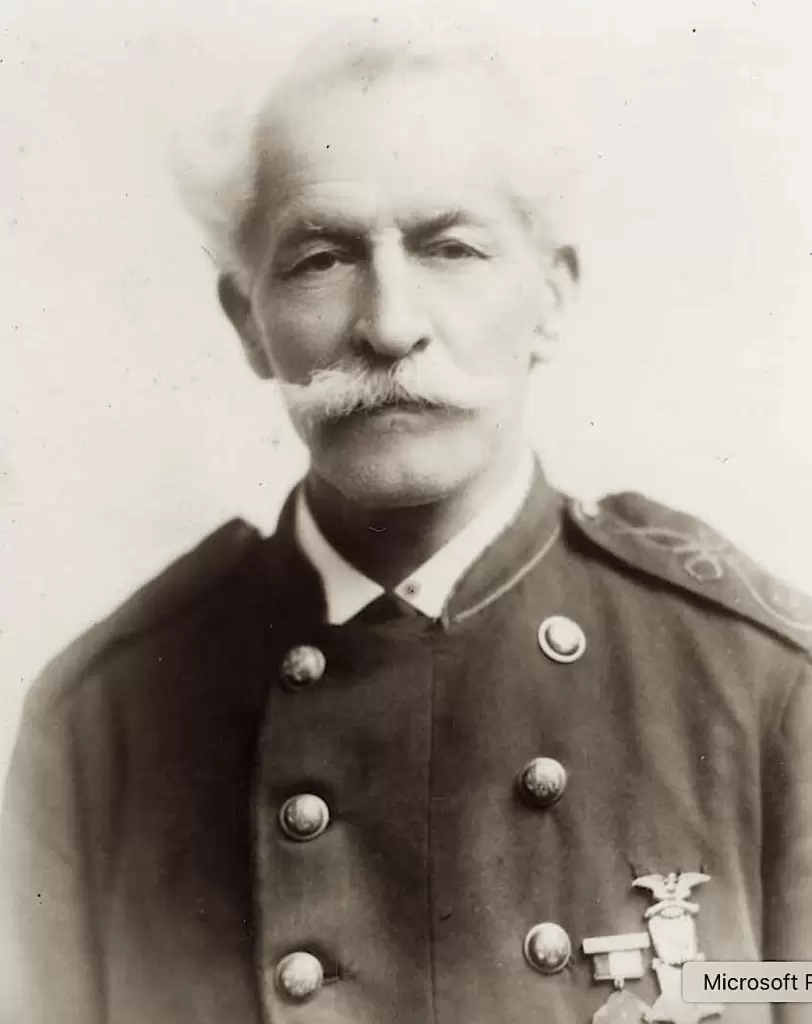
McWILLIAMS, CHARLES S. (1844-1907). Musician, 143rd New York Infantry, Company G. A native of New York, he enlisted as a musician at Bloomingburg, New York, on August 14, 1862, and mustered into the 143rd on September 9. As per his muster roll, McWilliams was absent and sent to the hospital in Fairfax Seminary, Virginia, from April 15 through April 20, 1862. The Veterans Census of 1890 notes that he was wounded in the right shoulder at the Battle of Resaca, Georgia (May 13-15, 1864). He mustered out after three years of service on July 20, 1865, at Alexandria, Virginia.
The 1880 census indicates that McWilliams was a student; according to the 1884 Brooklyn Directory, he was a bookkeeper. The 1885, 1888 and 1889 Brooklyn Directories state that he was a cabinetmaker. In 1889, he applied for and received an invalid pension, certificate 557,688. He was admitted to the United States National Home for Disabled Soldiers in Dayton, Ohio, on June 9, 1897. At that time, he was a 5′ 6″ tall bookkeeper with gray eyes, gray hair and a dark complexion. He cited his wartime right calf injury and cardiac troubles as the reasons for his admission. No discharge date is given. As per the 1900 census, he was working as a janitor in Brooklyn. His last address was 1149 Bedford Avenue in Brooklyn. He died of pneumonia. A burial record mistakenly shows that Charles S. McWilliams was buried at the Dayton National Cemetery; in fact, he is buried at Green-Wood. Sadie Treadwell McWilliams, whom he married in 1889 and who was first married to Charles Treadwell (see), applied for and received a widow’s pension in 1907, certificate 630,930. Section 135, lot 27263, grave 143.
MEAD, FRANCIS (1840-1862). Private, 8th Regiment, New York State National Guard, Company F. A native New Yorker and a resident there, Mead enlisted at New York City on May 28, 1862, and mustered into the 8th that day to serve for three months. According to cemetery records, he died from typhoid fever on September 5, days before his company mustered out on September 10. Section 115, lot 13536 (Soldiers’ Lot), grave 38.
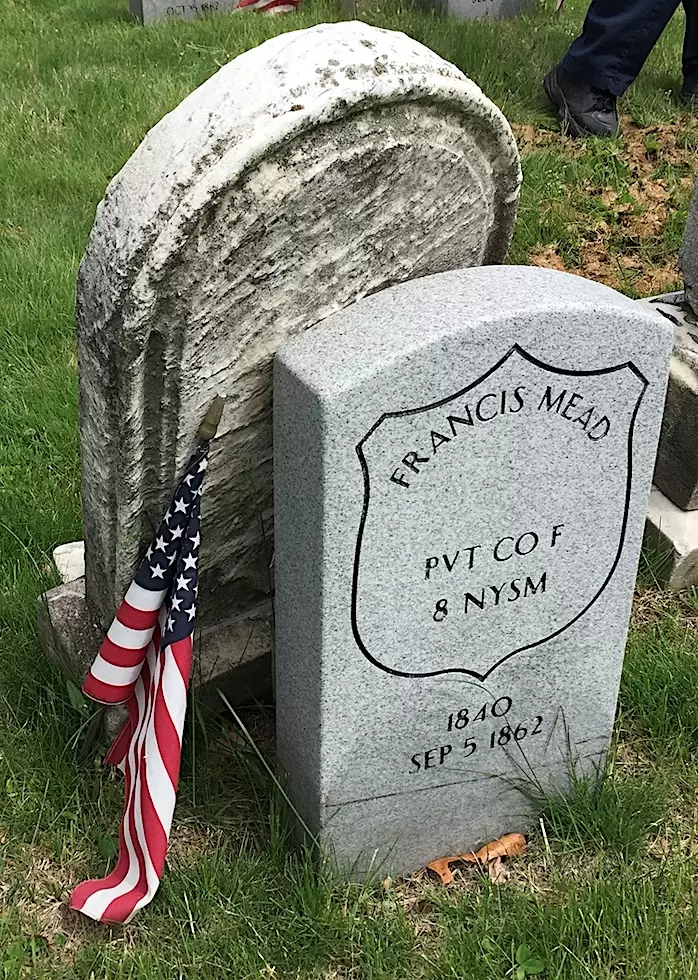
MEAD, GEORGE L. (1838-1872). Acting assistant paymaster, United States Navy. Born in New York, he was an acting assistant paymaster in the Navy beginning on September 11, 1862. At the time of the July 1863 Draft registration, he was listed as a paymaster in the United States Navy. Remaining in service after the War, he was promoted to assistant paymaster on July 23, 1866, and became a paymaster on January 25, 1870. Mead died from intermittent fever in San Francisco at the Mare Island Navy Yard on November 26, 1872, and was interred at Green-Wood on May 27, 1873.
As per Mead’s obituary in the New York Herald on May 25, 1873, officers of the Army and Navy, friends of his father, and Freemasons were invited to attend his funeral. A report on his funeral appeared in the New York Herald on May 28 which noted the presence of marines and Navy officers from the Flushing Avenue barracks and a contingent from his Masonic temple. That article concluded:
At the conclusion of the services the coffin was borne to the hearse, which later was draped with the Stars and Stripes. On the lid of the casket rested the uniform, hat, sword and belt of Mr. Mead. The cortege, headed by the band of the receiving ship Vermont, the marine guard, Free Masons and the hearse, moved off for Greenwood (sic). About twenty carriages, containing relatives and friends of the departed officer, followed the remains to the cemetery and witnessed the final interment.
Section 55, lot 19655.
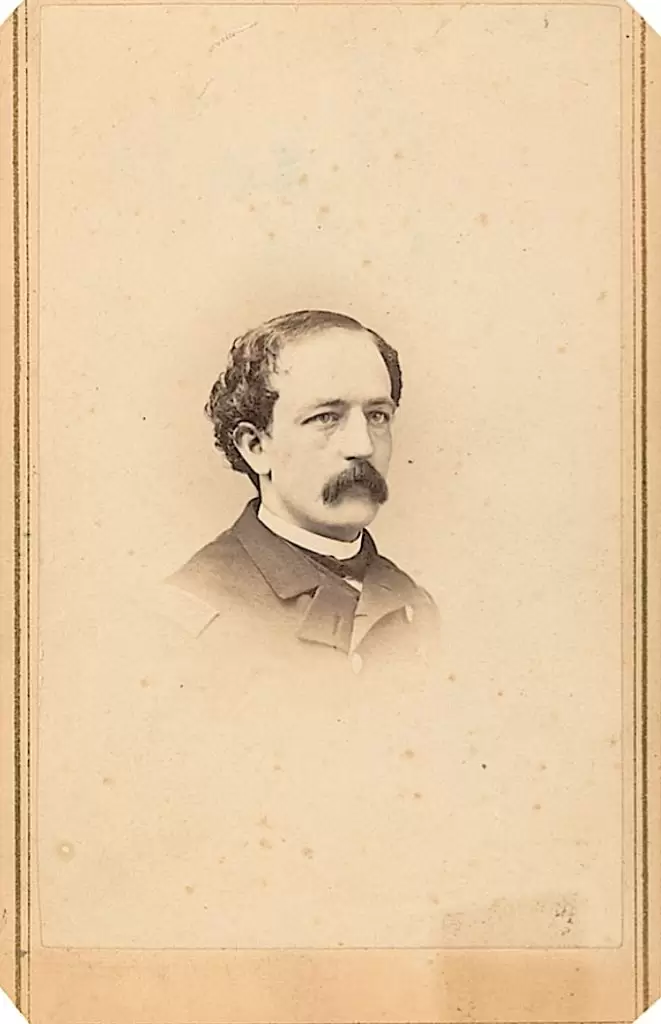
MEAD, JOHN (1829-1863). Captain, 102nd New York Infantry, Company K. After enlisting as a second lieutenant on February 1, 1862, at New York City, Mead was commissioned into the 102nd on April 5. As per his muster roll, he was a baker by trade who was 5′ 8½” tall with blue eyes, brown hair and a light complexion. He was promoted to first lieutenant on November 1, and rose to captain on March 27, 1863. On July 3, 1863, he was killed in action at Gettysburg, Pennsylvania, while, according to one report, he and another officer were “bravely cheering on their men.” His death certificate notes his cause of death as vulnus sclopeticum, Latin for “gunshot wound.” His last residence was 55 South 4th Street in Brooklyn. On July 30, 1863, Mary Mead applied for and received a widow’s pension, certificate 19,076. Section 104, lot 10922.
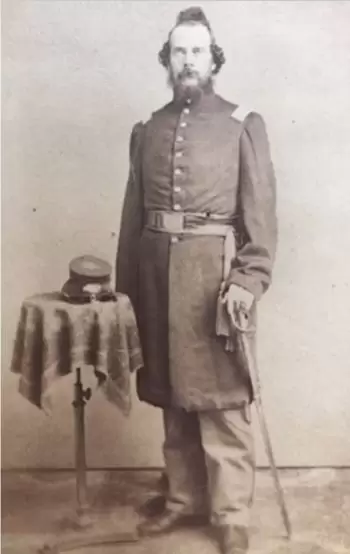
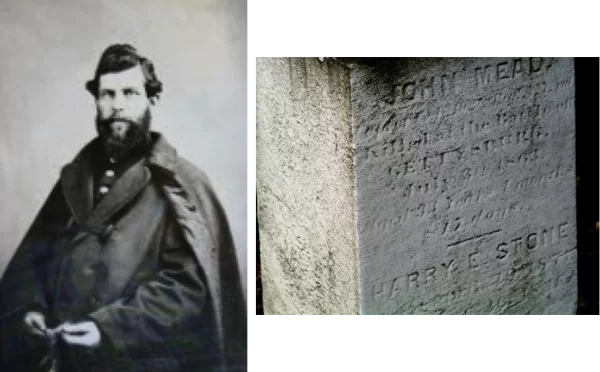
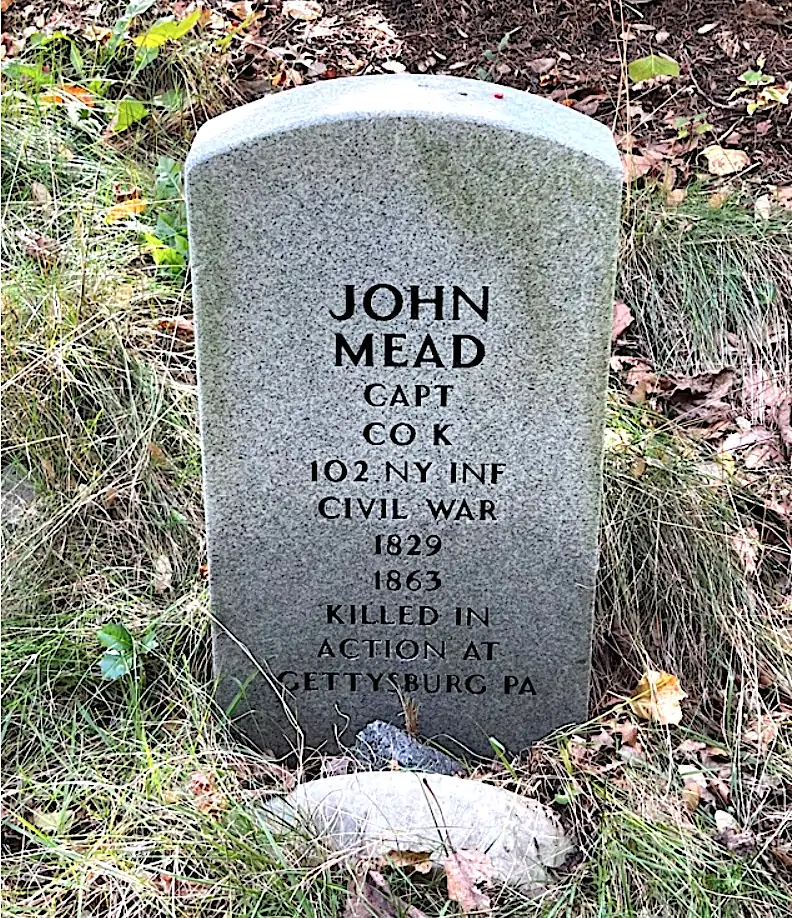
MEAD, SIDNEY M. (1843-1864). Private, 1st New York Mounted Rifles, Company B. Mead, a New York City native, enlisted as a private at New York City on October 19, 1861, and mustered into the 1st New York Mounted Rifles on November 11. As per his muster roll, he was a photographer who was 5′ 9″ tall with black eyes, black hair and a dark complexion. He re-enlisted on February 1, 1864. At the time of his death from bronchitis on October 20, 1864, at the base hospital in Point of Rocks, Virginia, the 1st Mounted Rifles was part of the Army of the James. (The hospital at Point of Rocks was established during the Bermuda Hundred Campaign in 1864; Mead’s soldier record incorrectly lists the location of his death as Point of Rocks, Maryland.) The Queens County Sentinel and the Brooklyn Daily Eagle reported the news of his death. Interment at Green-Wood took place on November 16, 1864. In 1880, Sarah E. Mead, his mother, applied for a survivor’s pension, application 265,460, but it was never certified. Section 101, lot 5022.
MEADE, JAMES E. (1842-1865). Private, 10th Connecticut Infantry, Company I. A New Yorker by birth, he resided in Greenwich, Connecticut, when he enlisted as a private on August 16, 1862, the same date that he mustered into Company I of the 10th Connecticut Infantry. He died from spinal meningitis on March 12, 1865, at Hampton Hospital in Fortress Monroe, Virginia. As per his obituary in the New York Herald, he was a Freemason; members of his lodge were invited to attend his funeral at the home of his father at 68 Lafayette Avenue in Brooklyn. Section 60, lot 1004.
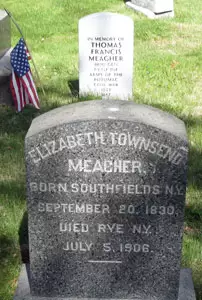
MEAGHER, ELIZABETH TOWNSEND (1840-1906). Elizabeth Townsend Meagher was a native of New York State, where her great-grandfather, owned 23,000 acres in Orange County and along the New Jersey border, and had established the Townsend Iron Works, one of the first iron industries on the continent. He forged the 100-ton chain that stretched across the Hudson River at West Point, New York, during the Revolutionary War, preventing British ships from getting any farther north. A Protestant, she traveled to Ireland before her 1855 marriage to General Thomas Meagher (see), visited Waterford, Meagher’s home town, imeeting his father and his son; Thomas, still a wanted man, was unable to accompany her. She converted to Catholicism in order to marry Meagher. Their wedding was performed by John Hughes, the archibishop of New York, at Hughes’s home. Their marriage was to be a partnership—as Thomas said, she was “never, never [to] hesitate to question me concerning anything which interests you, painfully or otherwise, in my regard.” Her father, a millionaire, removed her from his will for marrying Meagher and, though he allowed the Meaghers to live with him in his Fifth Avenue mansion, never provided any financial support to them.
Elizabeth and her husband were partners, travelling through the American South and South America together. When the Civil War began, Meagher chose to fight for the Union, and, in a series of eloquent speeches, urged other Irish immigrants to do so. She often accompanied Meagher to the front during the Civil War and was with him for a good deal of his military service. She helped nurse her husband back to health after the Battle of First Bull Run, Virginia, and was alongside other officers’ wives at the front helping the soldiers. A regiment in the Irish Brigade, known as “Mrs. Meagher’s Own,” the 88th New York Volunteer Infantry, was named for her. She marched at the head of parades, side-by-side with her husband, in support of the Union. She designed one of the Irish Brigade’s flags, to be carried into battle. She was there, next to him, watching as he drilled his recruits at Fort Schuyler in the Bronx or recruited at the brigade headquarters on Broadway in Manhattan. She sold the recruits on love of America; he sold them love of Ireland.
When Thomas Meagher was the acting governor of the Montana Territory, she joined him there in June of 1866. After learning of her husband’s disappearance into the Missouri River in the Montana Territory, on July 1, 1867, she spent 67 days in a futile search along the river for her husband’s body, as per her obituary in the New York Sun. Fort Elizabeth Meagher, near Bozeman, Montana, established in 1867, was named in her honor. Active in Catholic charities and the president of the Cancer Hospital, she last lived on Milton Road in Rye, New York, surviving on her husband’s service pension. She lamented, to her dying day, that her husband, Thomas, did not have a final resting place. Her death was caused by chronic valvular disease and emphysema. According to her obituary in The New York Times, six of the honorary pallbearers at her funeral were men who served under her husband in the Irish Brigade during the Civil War: John Dwyer, Colonel James Quinlan, Thomas Byrne, Colonel John Meagher, Colonel Denis McCarty, and Captain Michael McGuire. Section 206, lot 30910.
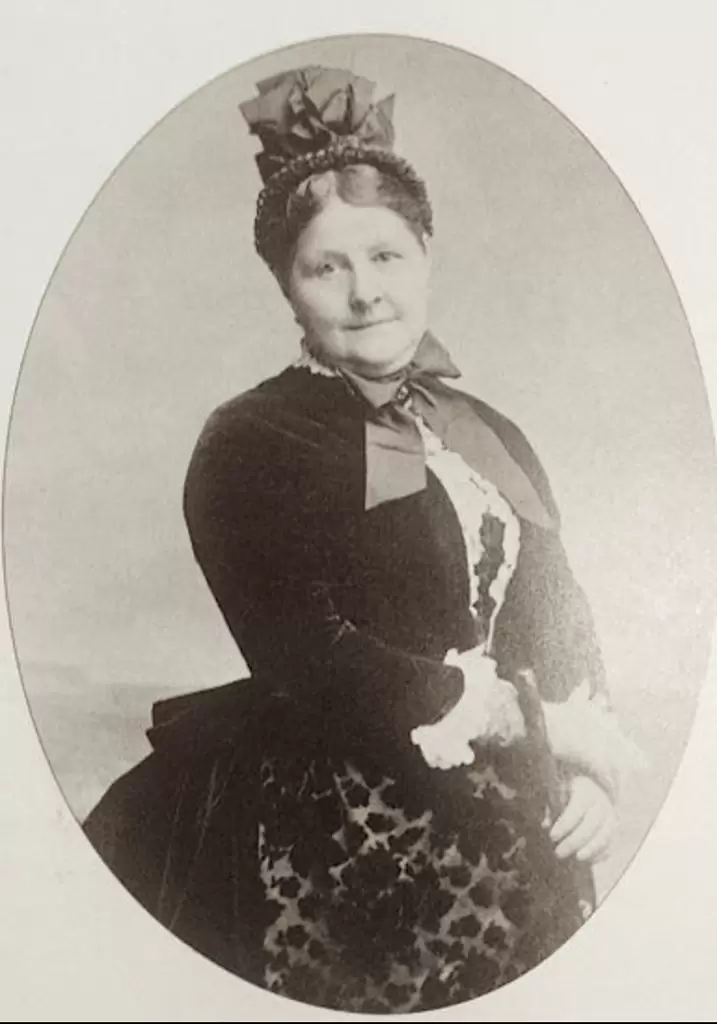
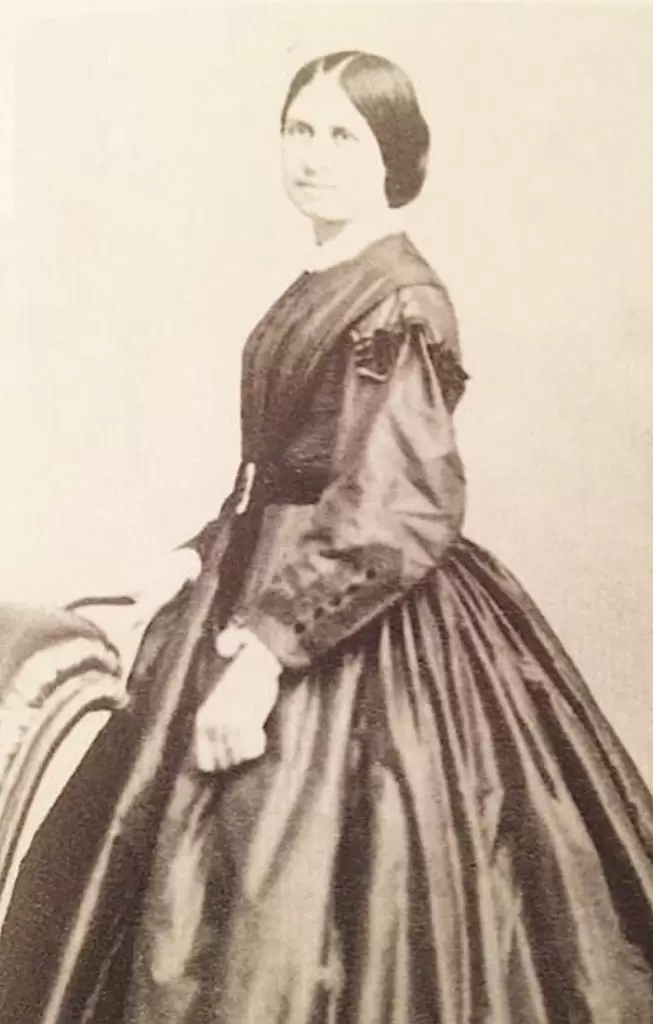
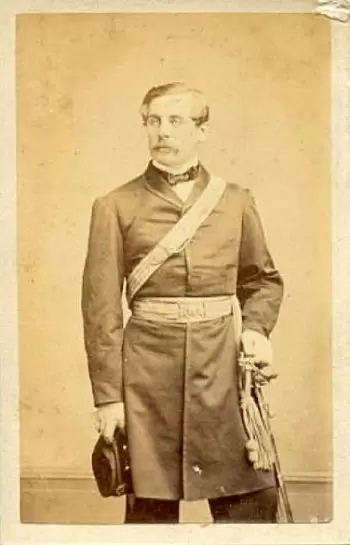
MEAGHER, THOMAS FRANCIS (1823-1867). Brigadier general, United States Volunteers; acting major, 69th New York State Militia. He was born in Waterford, Ireland, where his father was a wealthy merchant, mayor, and member of Parliament. Meagher (pronounced “Mar”) was educated at the Jesuit College in Clongowes, County Kildare, Ireland, and at Stonyhurst College in England where he remained until 1843. A fervent Irish nationalist, known as “Meagher of the Sword,” he was spurred on by the Great Hunger caused by English policies exporting food crops while millions of Irish starved, and attempted to lead a rebellion against British rule. In 1846, he became a leader of the revolutionary Young Ireland Party, led by poets and orators. Meagher became famous for his eloquent and rousing oratory. It was Meagher who, in 1848, introduced the Irish tricolor flag of green, white, and orange, saying as he unveiled it:
“. . . I trust that the old country will not refuse this symbol of a new life from one of her youngest children. I need not explain its meaning. The quick and passionate intellect of the generation now springing into arms will catch it at a glance. The white in the center signifies a lasting truce between the ‘orange’ and the ‘green’ and I trust that beneath its folds, the hands of the Irish Protestant and the Irish Catholic may be clasped in generous and heroic brotherhood . . .”
That flag became the official national flag of Ireland in 1937.
For his efforts at urging revolution and Irish independence, he was arrested for treason. After a trial and conviction, he was brought before the court, as a gallows was being built outside, and spoke, unbowed: “Judged by the law of England, I know this crime entails the penalty of death, but the history of Ireland explains this crime, and justifies it. Judged by that history, I am no criminal.” The court was not moved; it sentenced Meagher to death by hanging, then to be decapitated and his body to be cut into quarters. However, his sentence was commuted by Queen Victoria and he was ordered exiled to the British prison colony on Van Dieman’s Island (later to be known as Tasmania), on the other side of the world, off Australia, in 1849. Meagher, held as a prisoner on that island, married Catherine Bennett there, then escaped alone (she, as planned, was to head for Ireland, then they would reunite in New York) to the United States in 1852.
His fame had preceded him: immediately upon his arrival in New York City, he instantly was the most famous Irishman in America and was hailed as a leader of the Irish immigrant community. On the night after his arrival, 7,000 people gathered outside the home where he was having dinner, demanding that he address them. Flabbergasted, he obliged. For the next year he toured the country, giving wildly popular speeches on Irish and other matters, opposing the anti-immigrant Know Nothings as well as Catholic clerics. Meagher clubs sprang up across America. His wife, Catherine, died in 1854 in Waterford, while giving birth to their boy. Meagher practiced law in New York City—eloquently defending those accused of crimes before a jury was his specialty–and became a United States citizen. A Democrat, he believed slavery was an evil, but one that was a part of the Union: “It would be well if America could get rid of slavery. But we can’t, in our time, and should therefore confine our efforts to alleviating the evils that accompany it.” When the Civil War began, Meagher, ever-indebted to the country that allowed him to live free in it, chose to fight for the Union, and, in a series of eloquent speeches, urged Irish immigrants also to do so.
He recruited volunteers for the cause and joined the 69th New York State Militia, serving as a captain and acting major at the first big battle of the war, at Bull Run, Virginia. The 69th attacked Confederates on Henry Hill three times, but it was repulsed by artillery, with heavy losses. There Meagher’s horse was shot out from under him and he was knocked unconscious and almost captured. Soon thereafter, he mustered out with his company at New York City. In the winter of 1861-1862, he organized the Irish Brigade, intent on both fighting for the adopted country that had welcomed him and on training and giving battlefield experience to Irishmen who would, after this service, liberate Ireland.
On February 3, 1862, Meagher was commissioned brigadier general of United States Volunteers and given command of the Irish Brigade. Meagher led that brigade, almost 3,000 strong, many of whom had enlisted because of him, at numerous Virginia battles during the Peninsula Campaign of 1862, including Fair Oaks, Gaines’ Mill (where it was rushed to the front and covered the retreat of Major General Fitz John Porter’s Fifth Corps), Frazier’s Farm, and Malvern Hill (where his men engaged in hand-to-hand combat with the famed Louisiana Tigers—Irishmen also). After those battles, he went home on leave to recruit more Irishmen to replace the fallen; though the crowds still enthusiastically turned our by the thousands to hear him speak, Irish-immigrant opinion had changed, and, with mounting casualties and talk that the war had become an unpopular crusade to end slavery, recruiting was a hard go.
He returned to Virginia once again to lead the Irish Brigade. They fought at Second Bull Run in late August, 1862. At the Battle of Antietam, Maryland, on September 17, 1862, he led the attack at the Sunken Road, thereafter to be known as the Bloody Lane, and his horse was wounded and fell on him. Despite being concussed and carried off the field, he returned to action the next day. Reverend William Corby, chaplain of the Irish Brigade, was impressed with him: “General Meagher was more than an ordinary gentleman. He possessed high-toned sentiments and manners, and the bearing of a prince. He had a superior intellect, a liberal education, was a fine classical writer, and was a born orator. He was very witty.” On December 13, 1862, at Fredericksburg, Virginia, on orders from Major General Ambrose Burnside, commanding the Army of the Potomac, the Irish Brigade engaged in a suicidal attack on Confederates behind an elevated and fortified stone wall at Marye’s Heights. The men fought bravely but futilely: of the approximately 1,400 men of the Irish Brigade who went into action at Fredericksburg, 545 were either killed, wounded, or missing.
Meagher, suffering from a wounded leg, then took sick leave and returned again to New York City to recruit replacements. However, many Irish-Americans had turned against the war, seeing themselves as cannon fodder; Meagher was unable to recruit as he had done before. He returned to his men at the front on February 18, 1863. Just days after he led the Irish Brigade into battle at Chancellorsville, at the end of April and early in May, 1863, after yet more casualties, and now with a brigade of only 340 men present for duty, and feeling that he and his soldiers were not be adequately supported by higher-ups, he tendered his resignation as commander of the men he had so proudly led, “what was once known as the Irish Brigade.”
Though some criticized his performance in battle, alleging that he had gone into some battles drunk, he was reappointed a brigadier general in early 1864. He took charge of the district of Etowah, Georgia, was sent to the captured Confederate city, Savannah, Georgia, in January 1865, and mustered out there on May 15, 1865. During the election campaign of 1864, while still on duty, he gave speeches urging the re-election of President Abraham Lincoln—who had hosted him several times at the White House. By order of the Headquarters Department of the East, United States Army, dated April 23, 1865, he was named a member of the Guard of Honor detailed to stand near the body of the assassinated President Abraham Lincoln as it was put on view in the City Hall of New York City.
After the war, Meagher was appointed the secretary of the Montana Territory and served as its acting governor. Vigilantes there, who were executing a murderous campaign, declared him their enemy. On July 1, 1867, he mysteriously disappeared from a riverboat anchored on the Missouri River at Fort Benton, Montana, either falling (drunk or otherwise by accident) or being pushed by an assassin. His body was never recovered.
In 1905, a grand equestrian statue of Thomas Meagher was unveiled in front of the state capitol in Helena, Montana. A Department of Veterans Affairs gravestone was dedicated to his memory in April, 2008, in the Green-Wood lot where his wife, Elizabeth Townsend Meagher (see), is interred with other members of the Townsend family. On July 1, 2017, the 150th anniversary of his disappearance, a granite base and bronze bust of him, sculpted by Michael Keropian and paid for by donors solicited by The Green-Wood Historic Fund and the Country Waterford Association of New York, were unveiled in the Townsend lot. His cenotaph is located in section 206, lot 30910.
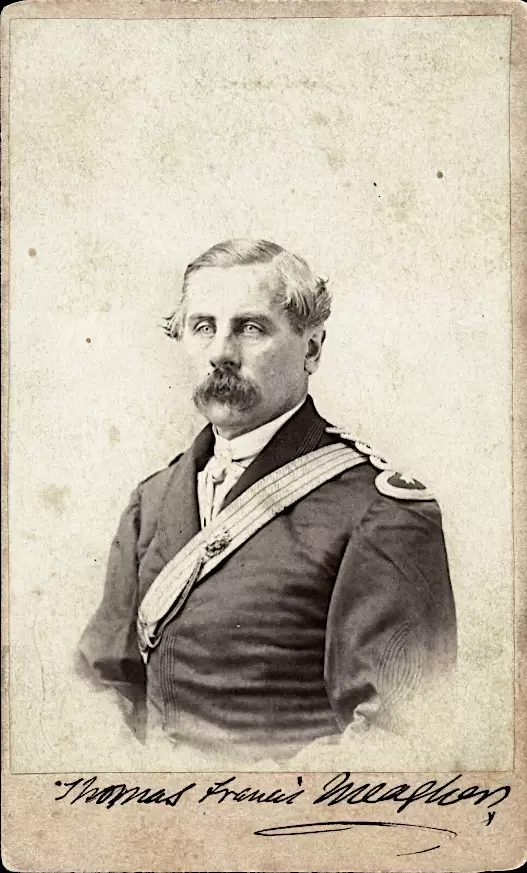
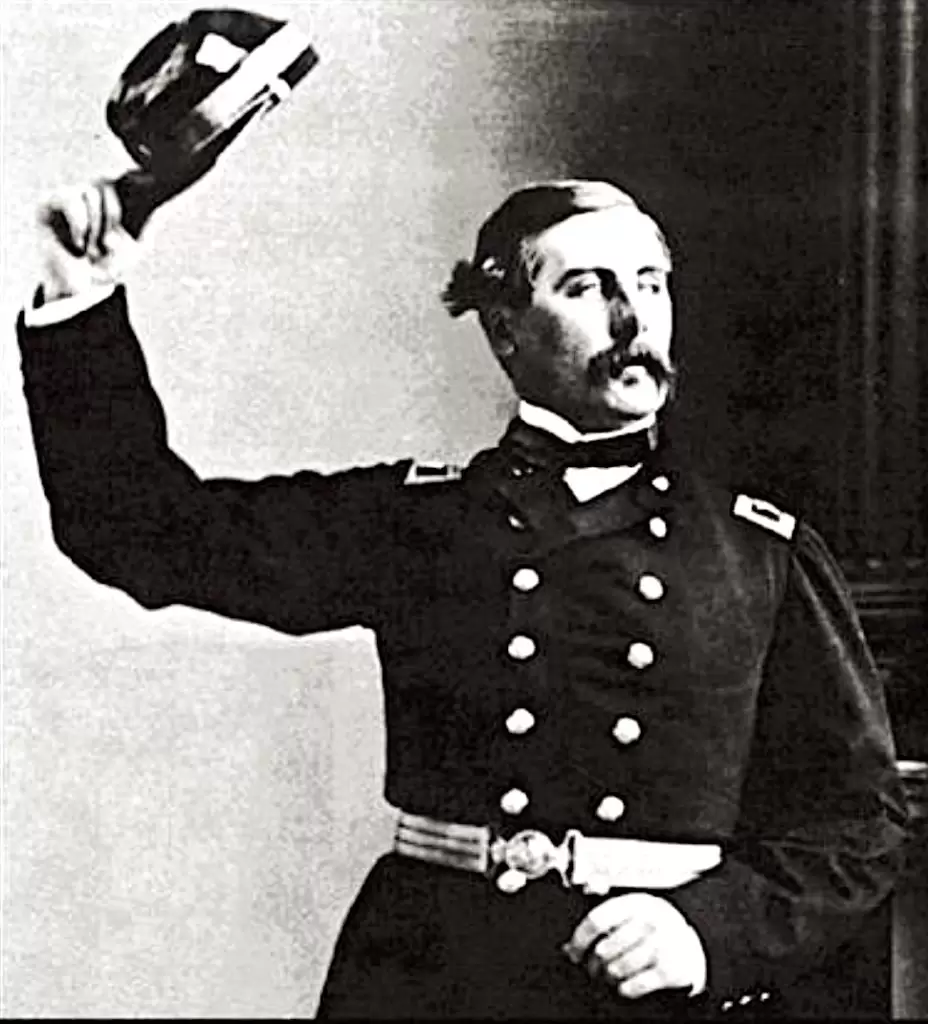
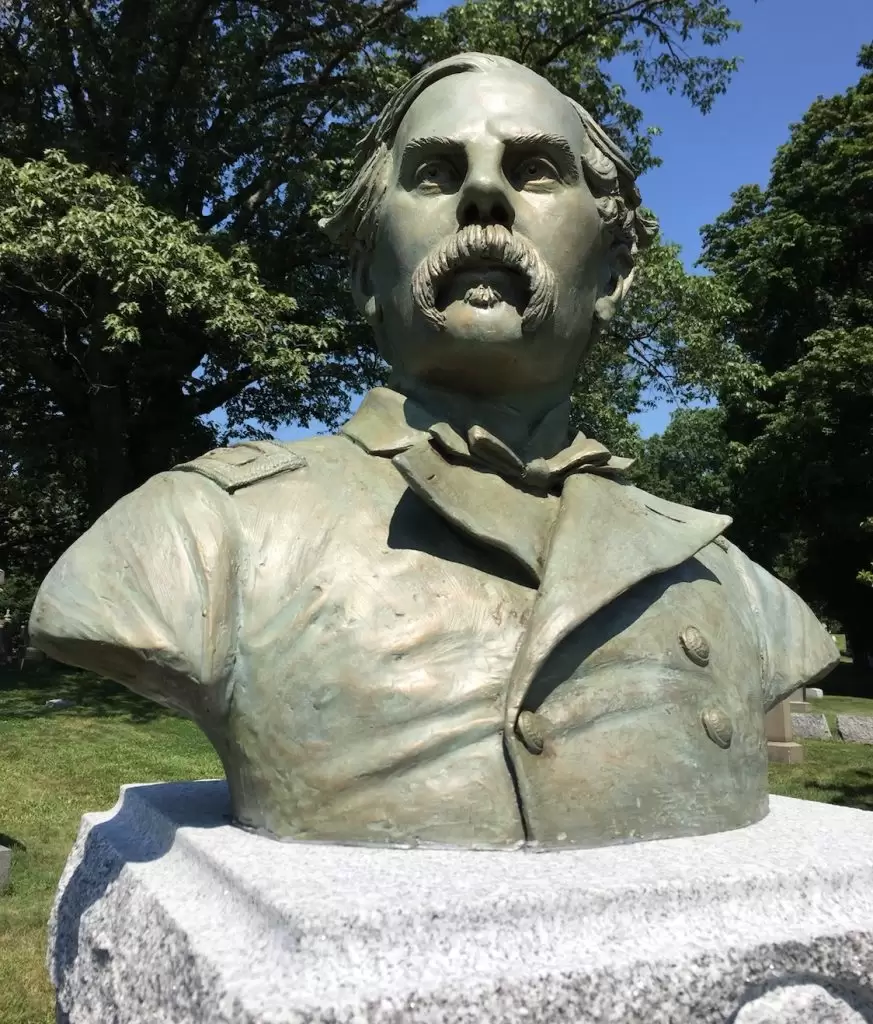
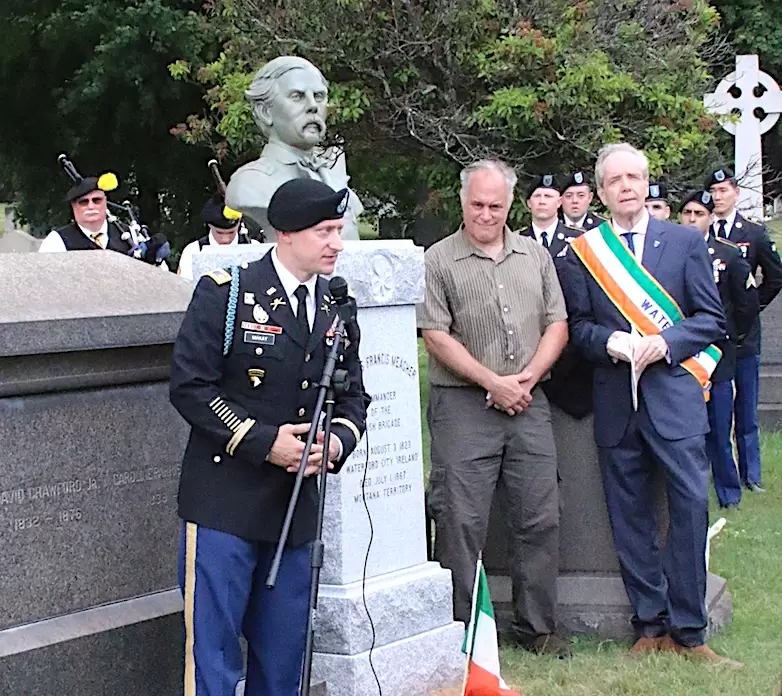
MEAKIM (or MEAKIN), ALEXANDER (1845-1904). Private, 37th Regiment, New York State National Guard, Company E. A native of New York City, Meakim served for three months with the 37th Regiment in 1862 and returned to the same company for 30 days in 1863. His obituary in the New York Sun, which confirms his Civil War service, notes his prominence in the business world and in Democratic Party politics. In 1884, Meakim organized the Business Men’s Democratic Club during Grover Cleveland’s first Presidential campaign. He was appointed an excise commissioner in 1889 by New York City Mayor Hugh Grant and served as as president of that board. However, his tenure was marked by controversy when he and two associates were indicted by the Reform Club officers alleging that the Excise Board was slow to act on a complaint about a violation of the Excise law on Election Day; the indictments were dismissed in 1898.
At the time of his death, he was the chief of the Bureau of Markets in the Comptroller’s Office, a position to which he was appointed in 1894. According to his obituary in the New York Herald, he was a member of the Lafayette Post #140 of the G.A.R., which he mustered into on October 4, 1889; his comrades were invited to attend his funeral. He last lived at 54 East 21st Street in Manhattan. Meakim died of paralysis at New York Hospital; he had previously suffered a stroke and cerebral hemorrhage. Section 96, lot 904, grave 10.
MEASE, JOHN LORIMER (1821-1870). Second lieutenant, 12th New York Infantry, Companies B and E; private, 37th Regiment, New York State National Guard, Company H. Mease, a native of New York, was a merchant according to the 1850 census. During the Civil War, he enlisted as a private at New York City on October 1, 1861, and mustered immediately into Company B of the 12th New York. He was promoted to sergeant major on October 14, 1862, and transferred that day into the Field and Staff. Mease was promoted to second lieutenant on December 14, 1862, effective upon his transfer to Company E on February 9, 1863. He was dismissed on November 20, 1863, as per Special Order #402. Subsequently, he served with the 37th Regiment for 30 days in 1864. He last lived with his brother-in-law in Fort Hamilton, Brooklyn. According to his obituary in the New York Herald, he died after a lingering illness, listed as phthisis. Section 43, lot 3318.
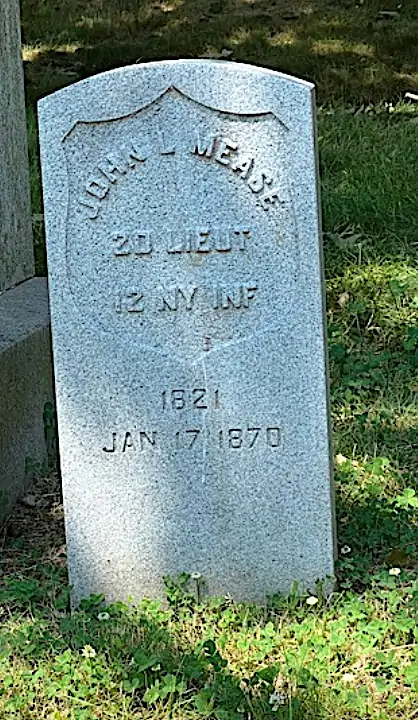
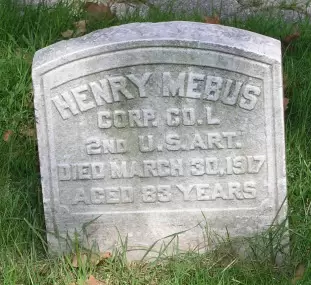
MEBUS, HENRY (1834-1917). Corporal, 2nd United States Light Artillery, Company L; private, 13th New York Heavy Artillery, Company M. A native of Werdenberg, Germany, and a gunsmith by trade, Mebus was 5’7″ tall with a fair complexion, brown hair and hazel hair. His first service began on February 9, 1854, when he enlisted and mustered into the 2nd United States Light Artillery. He re-enlisted on December 9, 1858, at Fort Riley, Kansas, and was discharged December 4, 1863, at Fort Monroe, Virginia.
During the Civil War, Mebus enlisted at Persia, New York, and immediately mustered into the 13th Heavy Artillery on September 8, 1864. On June 28, 1865, he mustered out at Norfolk, Virginia. According to his obituary in the Brooklyn Daily Eagle, he was a member of the George C. Strong Post #534 of the G.A.R. Henry Mebus died of arteriosclerosis. Section 135, lot 14964, grave 45.
MEEKER, CORNELIUS S. (or Z.) (1821-1905). Corporal, 2nd New York Heavy Artillery, Companies I and E. Meeker enlisted as a corporal on July 1, 1861, at New York City, and mustered into Company I of the 2nd New York Heavy Artillery on August 15. He re-enlisted on November 12, 1863, was wounded at Petersburg, Virginia, on June 17, 1864, transferred to Company E on June 27, 1865, and was discharged for disability from Ward Army Hospital at Newark, New Jersey, on August 19, 1865. He succumbed to acute lobar pneumonia. Section 48, lot 6228.
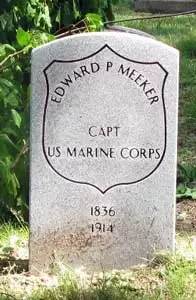
MEEKER, EDWARD PERCY (1836-1914). Captain by brevet; first lieutenant, United States Navy Marine Corps. Meeker, a native of New Jersey, first served in the United States Navy as a captain’s clerk in 1859. At the onset of the Civil War, he was the flag officer’s clerk on the USS Minnesota, a ship that was part of the North Atlantic Blockading Squadron. He was commissioned second lieutenant in the Marine Corps on June 14, 1862 (after enlisting that day as a first lieutenant), was assigned to headquarters at Washington, D.C., that year, and then was at the New York Marine Barracks in 1863-64. On June 14, 1863, while on blockade duty off the North Carolina coast, he was officially promoted to second lieutenant on board the USS Colorado, and became a first lieutenant on November 17, 1864.
Meeker was in command of a Marine Corps unit at the Battle of Fort Fisher, North Carolina, and, on January 14, 1865, was brevetted captain for “gallant and meritorious services at the attack upon Fort Fisher, 13, 14 and 15 January 1865.” He was in command of 150 United States Marines at the Battle of New Berne, North Carolina, when his unit was attacked by Confederate forces. He was ordered to hold his ground at all cost. When reinforcements arrived they found Meeker and two other marines alive. The remainder of his unit was decimated in this action and he was officially commended for bravery.
Remaining in the Marine Corps after the Civil War, he was in the European Squadron from 1866-67, the Marine Barracks at Brooklyn in 1868, and at the Naval Station at Norfolk, Virginia, in 1869. Meeker was promoted to captain on November 17, 1877. He commanded a rescue detachment in 1892 that landed at La Guayra, Venezuela, and recovered the United States Consular General’s Office personnel held by rebel bandits. During the aforementioned action, several of his men got drunk and were disorderly. He was reprimanded by a court-martial and ordered to lose one year’s pay. After a full review of this case, Secretary of the Navy Benjamin F. Tracy (see) set aside the court-martial. Meeker was then put in command of all receiving ships at the Brooklyn Navy Yard. He was a recruiting officer and his last command was on the USS Chicago of the North Atlantic Squadron from 1892 until 1893. He retired from the United States Marines Corps on March 15 of that year after 30 years of continuous military service. His last address was 178 Hancock Street, Brooklyn. His death was caused by a carcinoma. Section 83, lot 1615.
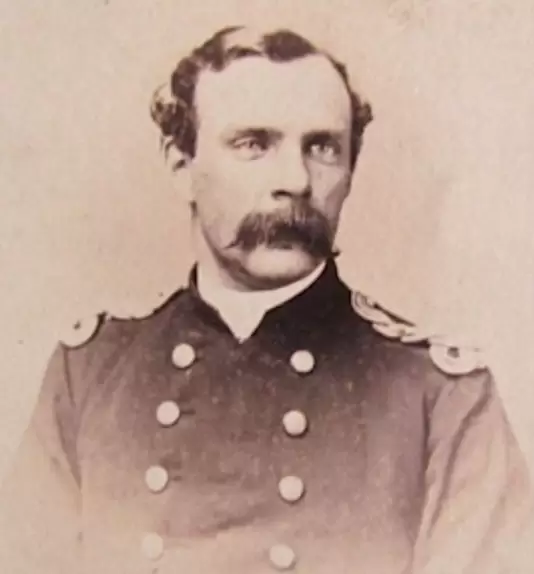
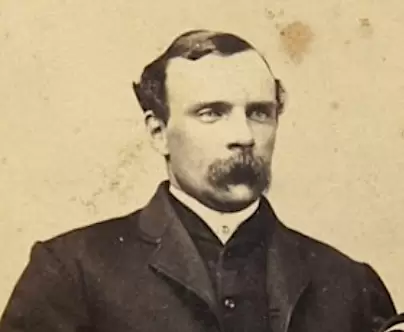
MEEKS, ALBERT VICTOR (1839-1889). Captain, 62nd New York Infantry, Company G; private, 7th Regiment, New York State Militia, Company H. A native New Yorker, Meeks was a son of Joseph W. Meeks, a master craftsman of furniture who had a store at 18 Vesey Street in Manhattan (see ad below). When Albert Meeks applied for a passport in 1859, he was 5′ 5½” tall with a high forehead, brown eyes, prominent nose, large mouth, auburn hair, thin face and florid complexion. In 1860, he graduated from the University of the City of New York’s Law School.
During the Civil War, Albert Meeks served in the first activation of the 7th Regiment from April 18 to June 3, 1861. He re-enlisted at New York City as a captain on June 4, and was commissioned into the 62nd New York on June 30. After resigning on December 2 of that year, his resignation was revoked the next day. He fought at the Battle of Williamsburg, Virginia, on May 5, 1862, and at Fair Oaks, Virginia, on May 31-June 1 (where he was wounded), before his resignation and discharge on August 11, 1862.
The 1889 New York City Directory states that was employed in real estate at 30 Vesey Street in Manhattan. He was a member of the Lafayette Post #140 of the G.A.R. As per his obituary in the New York Herald, he was a Freemason; members of his lodge were invited to attend his funeral at his Manhattan residence. Albert was the brother of Edwin Meeks (see). He last resided at 50 East 83rd Street in New York City but died of cardiac dropsy in Bayshore, Long Island. Section 99, lot 2592.
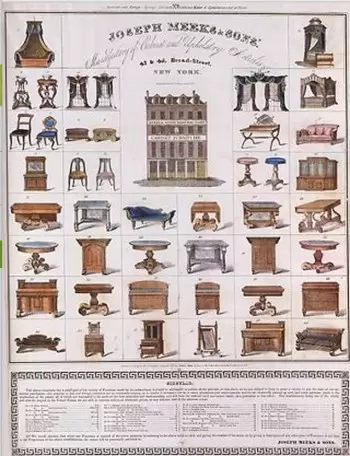
MEEKS, EDWIN BARTLETT (1841-1926). Quartermaster, 55th Regiment, New York State National Guard. Meeks was a son of Joseph W. Meeks, a master craftsman of furniture whose family history in New York City dates to colonial times. The family had a furniture store at 18 Vesey Street that was world renowned for its bureaus, armoires, writing tables, etc. Its hallmark was the Meeks name stenciled in black on the underside of the furniture.
During the Civil War, Edwin Meeks enlisted at New York City on June 24, 1863, was commissioned into the Field and Staff of the 55th Regiments as quartermaster the next day, and mustered out on July 27, 1863, at New York City. The 1879 New York City Directory and the 1880 census indicate he was an estate agent. When he mustered into the Lafayette Post #140 of the G.A.R. on February 15, 1889, he was living in Islip, Long Island, and listed his occupation as capitalist. On February 11, 1908, an article in the Brooklyn Daily Eagle reported on the family dispute over the unsettled estate of Joseph Meeks, his father and furniture magnate whose holdings were valued at $1,500,000. The father, a resident of Suffolk County, died in 1878 at age 97, and Edwin was the executor of the complicated estate. Although family members, including Edwin’s daughters, challenged Edwin’s handling of the estate, the court found no evidence of any impropriety. At the time the Eagle article was printed, Joseph Meeks had real estate holdings in Manhattan worth $800,000 that were not yet settled.
When Edwin Meeks applied for a passport in 1910, he identified his occupation as “gentleman.” He was 5′ 7½” tall with brownish-gray eyes, a full nose, broad forehead, dark and slightly gray hair, ruddy complexion and oval face. Edwin and Albert Meeks (see) were brothers. His last residence was on East 46th Street in Manhattan. He died of a pulmonary embolism. Section 99, lot 2592.
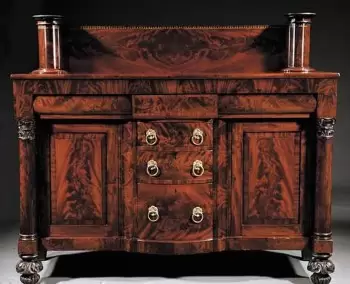
MEEKS, LEWIS (or LOUIS) C. (1830-1896). First sergeant, 11th New York Infantry, Company E. Meeks, a native New Yorker, was a fire warden in 1857. During the Civil War, he enlisted at New York City on April 21, 1861, as a first sergeant, and mustered into the 11th New York on May 7. The 11th New York was drawn from the ranks of New York’s volunteer firefighters and was also known as the Ellsworth Zouaves, First Fire Zouaves, First Regiment New York Zouaves, and the U.S. National Guards. The regiment was among the first to be in the thick of battle and suffered extensive casualties at First Bull Run, Virginia, on July 21, 1861, during the fighting on Henry House Hill and while serving as the rear guard for the retreating Union Army. Meeks was among the wounded there. He was reduced to the rank of sergeant on September 14, 1861, for physical disability, then to private on an unspecified date, and was discharged for disability on November 18, 1861.
In 1870, Meeks applied for and received an invalid pension, certificate 109,427. The 1870 census reports that he was a caulker. On October 18, 1874, the New York Herald printed an obituary noting the sudden death of his only son, John Reeves Meeks, who was four years and nine months old. He is listed as a caulker in the 1888 and 1892 New York City Directories. The Veterans Census of 1890 confirms his Civil War service and discharge for disability. Meeks last resided at 362 Front Street in Manhattan. His death was caused by an abscess of the heart. Jane Meeks, who is interred with him, applied for and received a widow’s pension in 1896, certificate 438,309. Section 70, lot 10119, grave 4.
MEEKS, WILLIAM (1822-1868). Corporal, 53rd New York Infantry, Company G. Meeks, who was born in New York City, enlisted there as a corporal on October 12, 1861. He mustered into the 53rd New York two days later, and was reduced in rank to private on December 31, 1861. He mustered out on March 21, 1862, at Washington, D.C. He died at Bellevue Hospital in Manhattan. Section 72, lot 5056.
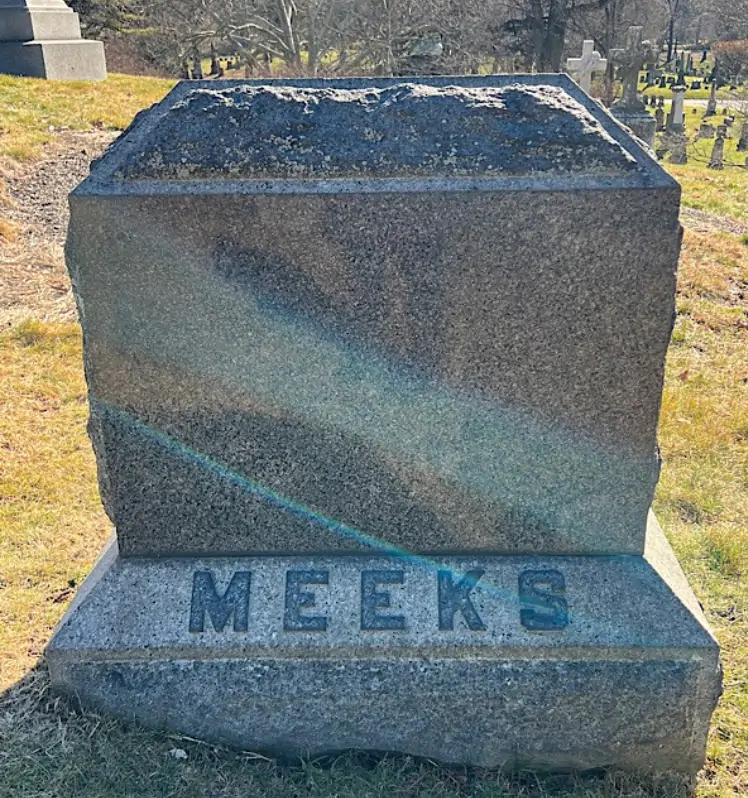
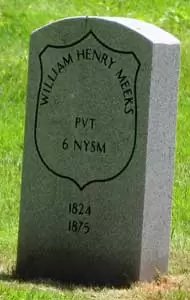
MEEKS, WILLIAM HENRY (1824-1875). First lieutenant, 6th Regiment, New York State Militia, Companies D and A. Meeks enlisted at New York City as a first sergeant on April 19, 1861. On May 15, 1861, he mustered into Company D of the 6th New York State Militia. He received a promotion to first lieutenant on June 9, 1861, was transferred on that day to Company A, and mustered out on July 31, 1861, at New York City. He last lived on East 9th Street in Manhattan. Meeks succumbed to Bright’s disease. Section 80, lot 3834.
MEEKS, WILLIAM L. (1840-1915). According to his obituary in the Red Bank Register, Meeks, who was born in New York, was a Civil War veteran. A member of the New York City Fire Department, he was made captain when the department made the transition from volunteer to paid public service. He also was superintendent of the National City Bank Building in New York City. After his retirement in 1893, Meeks moved to Ocean Grove, New Jersey. He last lived in Ocean Grove where he died from chronic nephritis. Section 92, lot 8389.
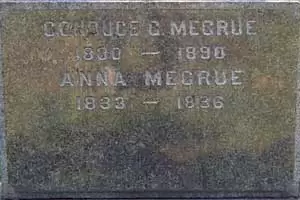
MEGRUE, CONDUCE (or CANDUCE) GATCH (1830-1890). Major, 4th Ohio Cavalry, Company B. After enlisting as a captain on August 25, 1861, Megrue was commissioned into Company B of the 4th Ohio Cavalry on September 24. The next year, he was promoted to major on September 16 and transferred that day to the Field and Staff. He resigned on March 2, 1863.
On December 18, 1868, President Andrew Johnson appointed Megrue assessor of internal revenue for the 2nd District of Ohio. An article on November 17, 1875, in the New York Herald noted Megrue’s involvement in the Whiskey Ring, a scandal that involved a conspiracy of government agents, politicians, whiskey distillers and distributors. The scandal embarrassed the administration of President Ulysses S. Grant by highlighting corruption in the Republican Party at that time. Megrue, who was indicted for bribery and netted $60,000 from the scheme, organized the plot from his base in Cincinnati working with others in St. Louis, Missouri. He called upon five distillery firms, assured them that the government could not harm them, and collected on average $9,000 weekly from each distillery which was then distributed among the conspirators. The scheme, which began in 1871, resulted in the siphoning off of millions of dollars in federal taxes on liquor.
An article in The New York Times on November 20, 1875, reported that Megrue had issued a statement that neither General Orville E. Babcock, the private secretary to President Grant, nor any other officials or citizens of Washington “have to my knowledge either directly or indirectly, been connected in any way with the Ring, with the exception of William O. Avery. I make this statement in simple justice to any of the parties named.” Megrue testified that Avery, the chief clerk of the Internal Revenue Bureau at Washington, was given $100 per week at first, then $300 per week. Megrue pleaded guilty to previous knowledge of the frauds and failure to report them; he was sentenced to jail for six months and a fine of $5,000.00.
Subsequently, Megrue moved to New York City where he became a successful businessman. According to his 1879 passport application, he was 5′ 9″ tall with dark eyes, dark hair, a dark complexion, oval face, high forehead, large mouth and chin and medium nose. The 1882 New York City Directory lists him as a broker. In late 1883, he ventured to London where he promoted American enterprises and was well known among American businessmen in London. As per his obituary in The Sun, which confirms his Civil War service, he died at the Cliftonville Hotel in Margate, England, while on holiday. His death was attributed to heart disease. However, an article on May 27, 1890, in the Daily Colonist, a newspaper from Victoria, British Columbia, calls his death a mystery and alleged that Megrue died “under peculiar circumstances” after checking into the hotel with a woman other than his wife. That article states that the medical attendant refused to write “heart disease” as the cause of death on the death certificate. His personal estate in London was valued at more than 879 pounds. Megrue’s last residence was at 256 West 57th Street in Manhattan. Anna Megrue applied for and received a widow’s pension in 1891, certificate 342,981. Section 146, lot 25458.
MEHL, ALBERT J. (1834-1888). Sergeant, 55th New York Infantry, Company H; private, 38th New York Infantry, Company H. Originally from Germany, Mehl enlisted as a private at Staten Island on August 1, 1861, and mustered into the 55th New York on August 28. He was promoted to sergeant on September 7, 1861, reduced to the rank of private on October 1, 1862, and was transferred into the 38th New York on December 21, 1862. He was discharged on an unknown date. He last lived at 203 West 30th Street in Manhattan. His death was attributed to cancer. Section 189, lot 19155.
MEHLER, JOSEPH (1845-1885). Sergeant, 61st New York Infantry, Company G; corporal, 57th New York Infantry, Company A. A native of New York City (although one record says Germany), Mehler enlisted as a private on September 18, 1861, at New York City, mustered into the 57th the next day, and was promoted to corporal on December 29, 1861. As per his muster roll, he was a painter who was 5′ 5″ tall with brown eyes, light hair and a light complexion. He was transferred to the 61st New York on December 20, 1864. He entered the 61st as a private, rose to the rank of sergeant on or about May 30, 1865, and mustered out on July 14, 1865, at Washington, D.C. On January 17, 1882, he mustered into the John Sedgwick Post #186 of the G.A.R. He noted that he was a cigar packer in his biographical sketch. The 1884 New York City Directory lists Mehler as a cigarmaker (segarmaker). A resident of 118 Essex Street in Manhattan, he died after an accidental fall. Section 115, lot 11193, grave 355.
MEHRER, CHARLES W. (1839-1914). Corporal, 8th Regiment, New York State Militia, Company E. Mehrer was born in Brooklyn. In his first tour of duty, he enlisted as a private on April 21, 1861, and took part in the Battles of Harpers Ferry, Virginia (now West Virginia); Relay House, Maryland; and Bull Run, Virginia. When his unit was reactivated a year later as part of the 8th National Guard, he re-enlisted and mustered in as a corporal in the same company on May 29, 1862, and mustered out after three months on September 10. Subsequently, he fought under General George McClellan and then, in June 1863, he joined the United States Pioneer and Construction Corps and served under Generals Joseph Hooker and William T. Sherman. He participated in the battles of Sherman’s March to the Sea, receiving recognition from Sherman for his bravery at the Battle of Snake Creek Gap, Georgia. Mehrer was discharged in November 1864 and appointed in December 1864 to a clerkship at the United States Customs House where he worked for forty years.
His obituary in the Brooklyn Standard Union, which confirms his Civil War service, notes that he was one of the oldest employees in the Appraiser’s Department of the New York Custom House. He was also a hotel-keeper in Newburgh, New York. Active in political life, his obituary states that he managed the campaign of Chester A. Arthur for vice-president in 1880 and also that of Levi P. Morton (Benjamin Harrison’s vice-president) in 1888. An article in the New York Herald on October 7, 1883, describes a controversial incident in Mehrer’s work life. Apparently, Mehrer was being paid $2,000 as an examiner in the Appraiser’s Office but was only doing clerical work. His new boss thought that salary was excessive for the work Mehrer was doing and reduced it to $1,400. Mehrer became enraged, used profane language and acted in an abusive manner when he learned of the demotion. He then was dismissed for “gross and violent insubordination.” Mehrer appealed the dismissal to the Secretary of the Treasury and the Civil Service Commission and was apparently reinstated.
In 1889, he applied for and was granted an invalid pension, certificate 568,020. The 1890 Veterans Census confirms his Civil War service. According to his obituary in the Brooklyn Daily Eagle, he was a member of the Phil Kearny Post #8 of the G.A.R. He was a member of the Eighth Regiment Veteran Association, the Veteran Firemen’s Association of New York, the “Amen Corner” of the Fifth Avenue Hotel, the Freemasons, and the Elks. He last lived at 8223 13th Avenue in Brooklyn where he died from “a complication of diseases.” Section 102, lot 22554.
MEIER (or MAIER), GEORGE (1843-1906). Private, 54th Regiment, New York State National Guard, Company B. Originally from Germany, he immigrated to the United States in 1857. During the Civil War, Meier served as a private with the 54th Regiment, a unit organized in Rochester, New York, for 100 days as of July 24, 1864. As per his obituary in the Brooklyn Daily Eagle, he had been the New York agent for the American Mills Company. The 1890 Veterans Schedule confirms his Civil War service. The 1900 census reports that he was a selling agent; he was listed as an agent in the 1904 Brooklyn Directory.
Meier was a member of the Ulysses S. Grant Post #327 of the G.A.R., an organization for Civil War veterans; members of his G.A.R. Post were invited to his funeral. In addition, he belonged to the Royal Arcanum, was active in the Stuyvesant Heights Republican Club, and belonged to the Knickerbocker Club of Flatbush. He last lived in Brooklyn at 21 Rugby Road. He died in Atlantic City, New Jersey, where he had gone in hopes of restoring his health after a bout with rheumatism. In 1910, Mary Meir, who is interred with him, applied for and received a widow’s pension, certificate 719,385. Section 194. lot 32210, graves 1 & 2.
MEIGS, CHARLES H. (1843-1891). Second lieutenant, 23rd Regiment, New York State National Guard, Company G. Meigs was born in New York City into a well-known family. During the Civil War, he was commissioned into the 23rd on June 18, 1863, and mustered out after 30 days on July 22 at Brooklyn. His regiment served in Harrisburg, Pennsylvania, under the command of Colonel William Everdell Jr. (see) as part of the Department of the Susquehanna. The 23rd participated in the engagements at Oyster Point, Pennsylvania, on June 28, 1863, and at Carlisle, Pennsylvania, on July 1, 1863.
As per his obituary in the New York Herald, Meigs became a member of the Stock Exchange on March 26, 1863, and was a prominent figure on Wall Street where he was head of C. H. Meigs & Co. He followed his family in the financial industry; his father, Charles A. Meigs, was a banker who gave money to the widows of Civil War soldiers and his uncle was a former president of the Stock Exchange. (In 1867, Charles A. Meigs and Charles H. Meigs declared bankruptcy and the elder Meigs lost a considerable amount of his fortune. Charles A. Meigs then became the national bank examiner for New York.) At the time Charles H. Meigs applied for a passport in 1885, he was 5′ 9¾” tall with brown eyes, brown hair, an aquiline nose, medium forehead, medium nose, dark complexion, and oval face. He moved to Ridgefield, Connecticut, in about 1888 after suffering a stroke and retiring from business. He died in Santa Barbara, California, where he had hoped to restore his health. Most likely, Charles was in Santa Barbara visiting his brother Peveril who settled there as a farmer in 1887 and later became an olive oil manufacturer and community leader. Meigs Road, a main thoroughfare in Santa Barbara, is named for Peveril Meigs. Section 148, lot 21051.
MEINCKE, CHARLES (1847-1917). First class boy, United States Navy. A native of New York, Meincke enlisted as a first class boy at the Naval Rendezvous at New York City on June 24, 1864. His records indicate that he was 5′ 2½” tall with gray eyes, dark brown hair, a dark complexion; no occupation was listed for him. Meincke had scars on his left eyebrow, under his chin, and on his right wrist and hand. In addition, the tattoo “C.M.” was inscribed on his left forearm and his right forearm had a tattoo of a star. On August 6, 1864, he was assigned to the Potomac Flotilla where he served aboard the USS Sophronia and the USS John Adams. He was discharged on September 13, 1865.
Meincke was unmarried as per the 1870 census and working as an assistant bookkeeper; he was living with his wife, whom he married in 1878, and working as a doorkeeper as per the census of 1900. According to his obituary in the Brooklyn Daily Eagle, which confirms his Civil War service, he was the adjutant of the Rankin Post #10 of the G.A.R. That obituary states that he had been employed as a bridge tender by the New York City Department of Bridges. He last lived at 464 51st Street in Brooklyn. He died at the Norwegian Hospital in Brooklyn according to Green-Wood records but his obituary in the Brooklyn Daily Eagle notes that he died at his home after a short illness. The officers of the Rankin Post conducted ritual services for their late comrade at his home. At the time of his death, his property totaled $1,200 in value. Section 200, lot 24559.
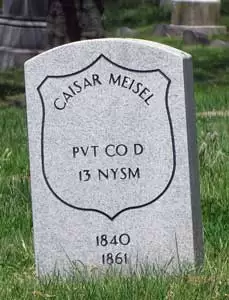
MEISEL, CAISAR (or CEASAR, CAEZER) (1840-1861). Private, 13th Regiment, New York State Militia, Company D. Of German birth, Meisel enlisted as a private at Brooklyn on April 23, 1861, for a period of three months, and mustered into Company D of the 13th Regiment’s State Militia the same day. He was accidentally shot and killed on June 10, 1861, at St. Michaels, Maryland. At the time of his death, he was still due pay from his enrollment. He was interred at Green-Wood on June 12, 1861. Section 81, lot 13176.
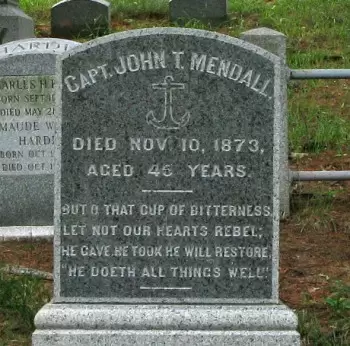
MENDALL, JOHN THORNTON (1828-1873). Acting ensign, United States Navy. Originally from Dartmouth, Massachusetts, he was appointed acting ensign in the United States Navy on September 10, 1862. By the end of the year, he had been assigned to the USS Dale, a sloop of war serving as an ordnance ship out of Key West, Florida, in the Eastern Gulf Blockading Squadron. On January 29, 1863, he was temporarily detached to take command of the USS Beauregard and the prize steamer Pearl. On October 7, 1863, his appointment was revoked after he took ill with typhoid fever and was hospitalized at Key West.
According to his death certificate, Mendall had been employed as a sewing machine operator and his death was caused by heart disease. His last residence was 612 Fulton Street, Brooklyn. His tombstone, decorated with an anchor, is inscribed, “Captain John T. Mendall,” but he does not appear to have reached that rank in the Navy; his wife’s obituary states he was a sea captain. In 1890, Sarah Mendall applied for and received a widow’s pension, certificate 6,931. Section 66, lot 3078.
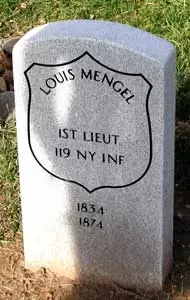
MENGEL, LOUIS (1834-1874). First lieutenant, 119th New York Infantry, Companies B, E, and C. Of German birth, he enlisted at New York City as a sergeant major on August 4, 1862, and mustered into Company B of the 119th New York on November 4 of that year. As per his muster roll, he was a clerk who was 5′ 9″ tall with brown eyes, brown hair and a fair complexion. He was promoted on two occasions, the first to second lieutenant on December 2, 1862, effective upon his transfer to Company E on February 7, 1863. Subsequently, he rose to first lieutenant on June 6, 1863, effective upon his transfer to Company C on August 28. On July 20, 1864, he was wounded at Peach Tree Creek, Georgia, and was dismissed at the end of the year on December 13. His pension index card indicates that he also served in Company B of the 1st United States Army Volunteers, but there is no additional information about that enlistment. Although he applied for a pension in 1871, application 163,206, it was never certified. Mengel last lived on Long Island. His cause of death was phthisis (tuberculosis.) A government-issued stone marks his site. Section 115, lot 13536 (Soldiers’ Lot), grave 117.
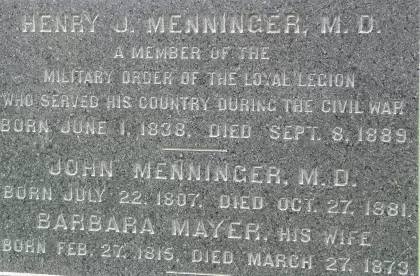
MENNINGER, HENRY J. (1838-1889). Surgeon, 2nd North Carolina Infantry (Union); assistant surgeon, 1st North Carolina Infantry (Union); captain, 27th Pennsylvania Infantry, Company K. A native of Metz on the Rhine, Germany, Menninger immigrated to the United States when he was twelve. His father, Dr. John Menninger, was a member of the Radical wing of the first German Parliament which convened in 1849. After that Parliament dissolved, John Menninger was wanted by the German government and, in a daring exploit, escaped and was hidden by friends across the Rhine. John Menninger reached Antwerp, Belgium, in 1850, secured a passport and came to New York, following other political refugees, including Carl Shurz and General Franz Siegel; his family joined him in 1851. A wealthy man whose estates were confiscated by the German government, John Menninger practiced medicine in the United States and invented tin money; his property in Germany was later returned to him.
Henry Menninger was educated in New York, attending public school there and becoming a naturalized citizen on June 26, 1859. As per the census of June 11, 1860, he was a druggist living in Philadelphia, Pennsylvania; the August 2, 1860 census indicates that he was a doctor living in New York City. Pursuing a medical career, he graduated from University Medical College in 1863, although some records say 1861. As per his obituary in the Brooklyn Daily Eagle, which confirms his Civil War service, Menninger was also connected with several New York newspapers during his years in medical school and for a short time after his graduation. The obituary notes that he was a correspondent for the New York Tribune during the Civil War.
According to his soldier record, Menninger enlisted as a first lieutenant at Philadelphia on June 4, 1861, and was simultaneously commissioned into Company K of the 27th Pennsylvania. He was promoted to captain on June 17, 1861, and resigned on July 29, 1861. The 17th Pennsylvania took part in the advance on Manassas, Virginia, on July 16-21, 1861, and fought at the Battle of First Bull Run on July 21. The Brooklyn Daily Eagle reports that Menninger enlisted as a private, soon rose to lieutenant, and commanded a company at the Battle of First Bull Run, Virginia. He was severely wounded in the neck at the Battle of Roach’s Mills and never fully recovered from his injuries. After he was released from the hospital, he was transferred to the medical department and ordered to New Berne, North Carolina, as post surgeon. Serving the Union, he was commissioned into the Field and Staff of the 1st North Carolina Infantry as an assistant surgeon on June 27, 1862. He was discharged on February 6, 1864, and commissioned into the 2nd North Carolina Infantry as a surgeon where he served until his discharge on February 17, 1865. From 1865 until 1868, he was the surgeon-in-chief of the Marine Hospital in New Berne, North Carolina and was editor and publisher of the New Berne Republican, the first Republican newspaper published in the Southern Atlantic states.
Active in politics, he was elected North Carolina’s secretary of state as a Republican in 1865. As per his passport application in 1871, he was 5′ 9″ tall with dark brown eyes, black hair, a high forehead, straight nose, medium chin, thin face and clear and pale complexion. While he served as secretary of state, he noted in a newspaper article in the Plain Dealer (Cleveland) on August 14, 1872, that there were frauds perpetrated by his party during the recent election. Menninger, who was described as honest, admitted that he did not know how certain precincts in Brunswick reported more votes than registered voters and that in Wilmington, men registered after Sunday and on the day of the election.
Menninger relocated to Brooklyn in about 1874 after his term expired in North Carolina. Remaining active in the Republican Party, he represented Brooklyn’s Fourth Ward on the Board of Alderman for three terms and was elected coroner of Brooklyn’s Western District in 1883 for one term; he was defeated when he ran for re-election in 1886. His obituary notes that he exposed a scandal involving the Board of Supervisors 1885 that involved three supervisors who wanted a plumber to raise his bill by $100 and share the profits with the supervisors; ultimately, the supervisors were acquitted when the plumber’s story could not be corroborated. According to his obituary in the New York Herald, he was a vice president of the Alumni Association of the College of Pharmacy of the City of New York; members of that organization were invited to his funeral. In addition, he was a founder of the Kings County Pharmaceutical Society. In 1881, he was elected to the business council of the American Pharmaceutical Association and presided at the 1886 annual dinner of the New York College of Pharmacy at Delmonico’s, an event attended by nearly two hundred guests.
The Veterans Schedule of 1890 confirms his Civil War service and indicates that he had been wounded in the neck. The obituary in the Brooklyn Daily Eagle states that he was a member of the Grand Army of the Republic and surgeon of the Mallory Post #84. In addition, he was a member of the Army of the Potomac Association, the Brooklyn Saengerbund (choral society), the German Apothecaries’ Society, and a trustee of the Germania Bank. At the time of his death, he was the proprietor of a drug store on Sands and Jay Streets in Brooklyn; the store, a neighborhood landmark, closed on the day of Menninger’s death to honor his memory. (His obituary in the Plain Dealer (Cleveland) stated that his death was attributed to a recurrence of his wartime injuries.) His obituary noted that although active in the Republican Party, he had many friends who were Democrats and was widely admired for his genial manner and kindness: he was generous to those who had less than him and gave cheerfully to many charitable institutions. The Brooklyn Daily Eagle reported that Menninger looked frail after returning from a trip to Canada. Menninger replied that his Canadian friend “kept me on a fish diet, believing that that was the best for me, but I got too much of it. I can feel the bones sticking out all over me.”.
An article about his funeral at the Grace Episcopal Chapel appeared in the New York Herald. That article noted that Menninger was buried in an Army surgeon’s uniform. Flags at Brooklyn’s City Hall and the Kings County Court House were lowered to half-staff in his honor. City and county officials, representatives from veterans’ associations and a delegation from the German Druggists’ and the Pharmaceutical societies were present at his funeral. The New York Tribune also reported on Menninger’s funeral. In that article, it was reported that Menninger was buried in his G.A.R. uniform with badges from the G.A.R., Society of the Army of the Potomac, and the Military Order of the Loyal Legion on his breast. Members of the associations to which Menninger belonged were represented at the funeral. His tombstone notes his membership in the Military Order of the Loyal Legion, an association of Civil War officers formed after President Lincoln’s assassination to thwart threats to the national government. His last residence was at 20 Smith Street in Brooklyn. He died from Bright’s disease. Catharine Menninger, who is interred with him, applied for and received a widow’s pension in 1889, certificate 314,645. Section 115, lot 20955.
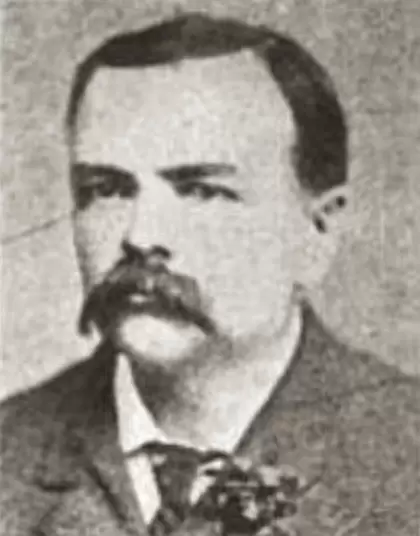
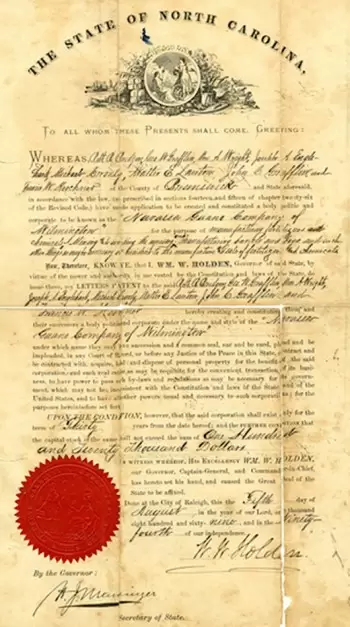
MENYHART, JOHN G. (1829-1906). Captain, 45th New York Infantry, Company K. Menyhart, who was born in Hungary (although some documents say Austria), became a naturalized citizen on December 2, 1868. During the Civil War, he enlisted at New York City on September 6, 1861, and mustered into the 45th New York, also known as the 5th German Rifles, three days later. He was commissioned as captain of Company K on November 4 with rank from September 6. The regiment was encamped at Jones’ Wood for one month, then left for Washington, D.C., on October 9 and was encamped at Hunter’s Chapel that winter. In April 1862, the 45th was transferred to the Mountain Department under General John C. Fremont and participated at the Battle of Cross Keys. Subsequently, many of the men were on the sick list because they endured harsh marches with insufficient food. Menyhart was discharged on June 15, 1862. The 1870 and 1880 censuses and the 1872, 1879 and 1889 New York City Directories indicate that he was a silver-plater. In 1892, he applied for and received an invalid pension, certificate 855,818. At the time of his death, he lived at 2407 Seventh Avenue in Manhattan. Section 127, lot 3611, grave 148.
MENZIES, ALEXANDER (1833-1865). Captain, 17th Infantry, United States Army; corporal, 10th Infantry, United States Army, Company E. Born in the parish of Halifax, county of York, England, he enlisted in the United States Army as a private at Chicago, Illinois, and served in Company E of the 10th Infantry from 1857 to July 1862. At the time of his enlistment, he was a clerk who was 5′ 6½” tall with blue eyes, brown hair and a fair complexion. On July 1, 1862, he was promoted to sergeant major of the 17th U.S. Army, and on October 13, 1862, to second lieutenant. He was promoted to first lieutenant on November 25, 1862, served as regimental adjutant from January 1, 1864, to August 18, 1865, and was promoted to captain on the latter date. He died of congestion of the brain (brain swelling) on October 25, 1865, at Hart’s Island in New York Harbor. He was a brother of Archibald Menzies (see). His Civil War revolver is in a collection in England. Section 189, lot 16431.
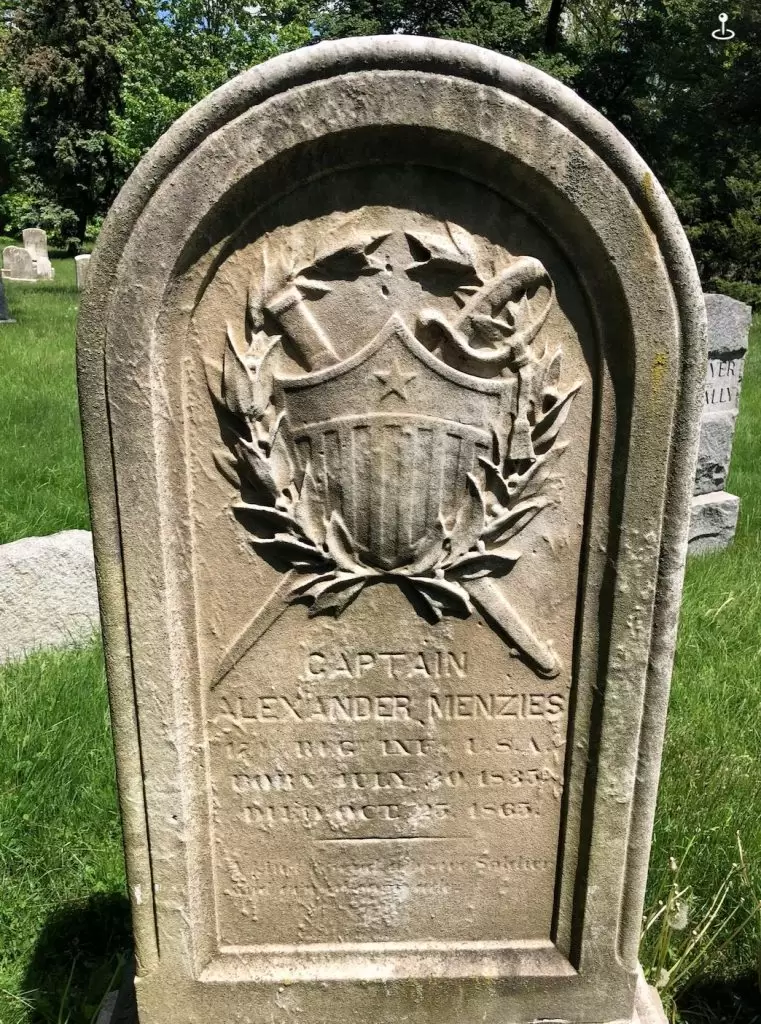
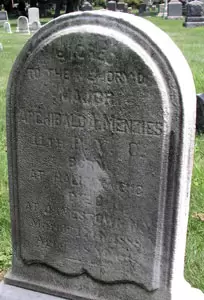
MENZIES, ARCHIBALD A. (1836-1888). Adjutant, 11th Pennsylvania Cavalry, Company H. A native of Yorkshire, England, he enlisted at Philadelphia, Pennsylvania, on August 28, 1861, as a corporal, mustered into Company H on that date, and was promoted to sergeant major on May 1, 1862 (although one soldier record says major), at which time he was transferred into the Field and Staff. Menzies was subsequently promoted to second lieutenant on October 14, 1862, and then to adjutant on October 25, 1862. He was discharged at Philadelphia on May 25, 1864. He was a brother of Alexander Menzies (see). His last residence was in Brooklyn. He succumbed to Bright’s disease. Section 189, lot 16431.
MERCEIN, ANDREW (1827-1882). Corporal, 13th Regiment, New York State National Guard, Company C. A New York City native, he was a clerk at the time of the 1855 New York State census. After Mercein enlisted as a corporal at Brooklyn on May 28, 1862, he immediately mustered into the 13th Regiment, and mustered out three months later at Brooklyn on September 12. In 1865, he was a clerk living with his sister and brother-in-law. His funeral was held at the residence of his brother-in-law at 480 Grand Avenue in Brooklyn. His death was caused by Bright’s disease, a kidney condition. Section 105, lot 1634.
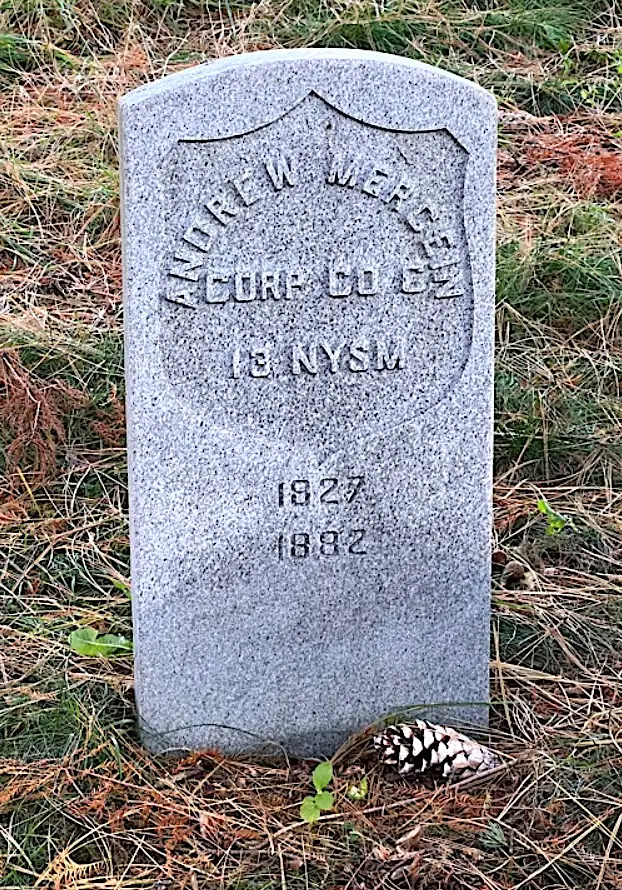
MERCER, ANDREW (1836-1917). Private, 83rd Infantry, Company A; 13th Infantry Veteran Reserve Corps, Company F. Born in Selkirk, Scotland, he enlisted at New York City and mustered into the 83rd New York (originally the 9th Militia) on May 27, 1861. As per his muster roll, he was absent and sick in April of 1863, and, on account of illness, he was transferred into the Veteran Reserve Corps on June 1, 1863, from which he was discharged on June 11, 1864.
As per his obituaries in the New York Herald, The New York Times and the Brooklyn Daily Eagle, which confirm his Civil War service, he was the vice president of the H. B. Smith Company of Westfield, Massachusetts, manufacturers of heating apparatus, an enterprise he was affiliated with for thirty-eight years at its Manhattan office. Remaining active in military affairs, he was a trustee of the Ulysses S. Grant Post #327 of the G.A.R. In 1905, he applied for and received an invalid pension, certificate 1,114,565. In civic life, he belonged to the Brooklyn Union League and the Invincible Club. He last resided at 649 St. Marks Avenue in Brooklyn. His death was attributed to heart disease. A medallion from the Grant Post of the G.A.R. is at his gravestone. Section 165, lot 26281.
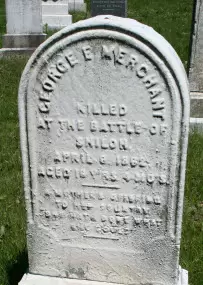
MERCHANT, GEORGE ELWOOD (1846-1862). Private, 3rd Iowa Infantry, Company F. Born in Schoharie County in New York State, his parents divorced in 1857 with both parents filing separately and each claiming custody of their only son. George E. Merchant moved with his father to Osage, Iowa, in 1857. He was a resident of New Oregon, Iowa, when he enlisted on May 20, 1861, and mustered into the 3rd Iowa on June 8. He was killed on April 6, 1862, at the Battle of Shiloh, Tennessee, when he was just 16 years old. His mother’s voluminous pension application indicates that he gave a friend and comrade in his company her address with his wish that his back pay, bounty and pension be forwarded to her if he should die. Merchant was interred at Green-Wood on July 3, 1862, and his remains were moved to their present location on August 13.
Sarah Merchant, his mother, applied for and received a pension on March 6, 1863, certificate 88,066. Her pension of $8 per month was retroactive to the date of George Merchant’s death; the pension was increased to $12 per month in 1886. Although George Fuller Merchant, his father, applied for a survivor’s pension in Illinois, application 477,079, in 1890, it was not granted because his first wife was still living and was receiving a pension. Section 115, lot 13536 (Soldiers’ Lot), grave 37.
MERIAN, HENRY WALTON (1839-1863). Third assistant engineer, United States Navy; corporal, 12th Regiment, New York State Militia, Engineers Company. Merian, who was born in Brooklyn, was the son of John J. Merian, a wealthy wholesale liquor dealer who lived at 22 Pierrepont Street in Brooklyn Heights. (By 1865, J. J. Merian had an income of $21,969, and owned a gold watch valued at $100, a piano worth $200, and silver plate valued at $1,495.) Henry Merian was a graduate of Rensselaer Polytechnic Institute in Troy, New York, class of 1858, with a degree in civil engineering. In 1860 through 1861, he worked as an assistant engineer at the Brooklyn Water Works.
During 1861, he served for three months as a corporal in the Engineers Company of the 12th New York State Militia, then moved to New Jersey where he worked as a draftsman at the Trenton Locomotive and Steam Works. Merian, a third assistant engineer in the U.S. Navy as of August 25, 1862, drowned when the USS Weehawken was lost at sea on December 6, 1863. The vessel, an iron-clad monitor, was commissioned at Jersey City, New Jersey, in mid-January 1863. Originally at Fort Sumter, South Carolina, on April 7, 1863, the Weehawken was struck by over 50 enemy cannon balls. After repairs, she was in the waters off Georgia and on June 17, 1863, captured the CSS Atlanta as well as two Confederate officers who would one day be interred at Green-Wood: Major Reid Sanders (see) and Second Assistant Engineer Leslie King (see). Returning to Charleston, South Carolina, the Weehawken assisted in the bombardments of Forts Wagner and Sumter. After being grounded on September 7, she was repaired and became part of the blockade off Charleston that October. The Weehawken, whose officers and crew were mostly from Brooklyn, suddenly sunk in a gale while at anchor off Charleston on December 6. Four engineers who couldn’t escape the flood and 27 other crewmen perished. The Brooklyn Daily Eagle reported on this tragedy on December 12:
…That poor Monitor fleet, which went forth with colors flying, carrying the hopes of the nation with it, has met disaster at every turn, encountered obstacles and sustained repulse, been battered and bruised, and finally settled down at anchorage not far from Morris Island. Even here it has been pursued, and the winds of Heaven with the waves of the ocean have destroyed and pushed down from sight, one of its best and strongest, and most vaunted components.
There was much speculation as to the cause of the Weehawken’s sinking. One admiral attributed it to damage suffered while aground under fire of the Sullivan Island batteries that strained the rivets on its bottom plates. John Ericcson, who pioneered ironclad construction, attributed the sinking to water entering the anchor hoister hatch after it had been accidentally left open by a crew member. Ultimately, the inquiry concluded that a heavy load of ammunition, open hatches and a failure to level the ship after it had taken on water caused the sinking.
Although crews attempted to bring up the Weehawken as early as December 1863, it took eight years before the ship and her crew members who perished there were brought back up. The remains of the men were then recovered and given proper burial. The funeral ceremony was detailed in an article in The New York Times on September 27, 1871. As per that account, the pageant began at the Brooklyn Navy Yard when a small box, containing the bones of the four deceased men, was deposited into a beautiful rosewood casket decorated with silver. A large silver plate which was placed upon the casket read, “This coffin contains the remains of four officers of the United States Navy, attached to the Weehawken, which foundered off Charleston, S.C., Dec. 6, 1863: H. W. MERIDEN (sic), Third Assistant Engineer; AUGUSTUS MITCHELL, Third Assistant Engineer; GEORGE W. MCGOWAN, Acting Third Assistant Engineer; and CHARLES SPONBERG, Acting Third Assistant Engineer.” The funeral procession began at noon with a detachment from the Vermont playing Auld Lang Syne. The cortege was led by the Band, followed by a detachment of Marines, sailors from the Man-of-War, the casket flanked by pall-bearers, a delegation from the Freemasons, and friends and relatives. The detachment of marines fired the customary funeral volleys at the gravesite. The Times noted that rain fell during the cortege and graveside ceremony adding a note of solemnity to the occasion.
Merian, Augustus Mitchell (see), George N. McGowan (see), and Charles Sponberg (see) are remembered in a monument at Green-Wood erected in 1871 and dedicated to their valiant efforts. The monument has a carving on its front that states it was erected by Frances Mitchell, who purchased the lot and is likely the mother of Augustus Mitchell and J. J. Merian, likely the father of Henry Merian. On one side the inscription reads: “SACRED TO THE MEMORY OF FOUR OFFICERS OF THE U.S. NAVY WHO LOST THEIR LIVES BY BEING DROWNED ON THE U.S. MONITOR WEEHAWKEN TO WHICH THEY WERE ATTACHED WHEN SHE FOUNDERED OFF CHARLESTON, S. C. DECEMBER 6, 1863.” The opposite side of the monument is inscribed: “THE REMAINS WERE EXHUMED FROM THE ENGINE ROOM OF THE WRECKED MONITOR WHERE THEY NOBLY FELL AT THEIR POST OF DUTY. SEPTEMBER 26, 1871.” Section 82, lot 20207.
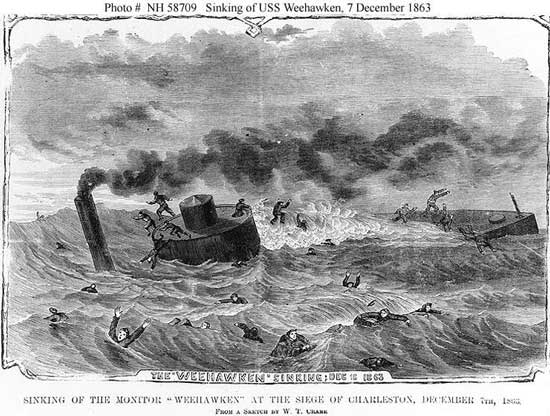
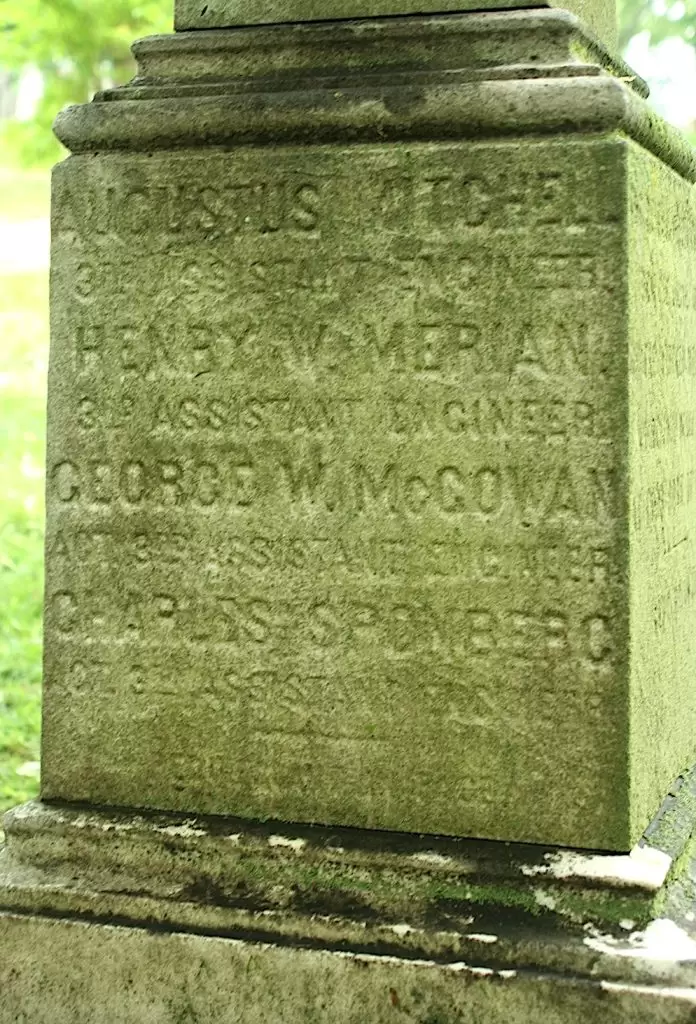

Monitor carved into the memorial.
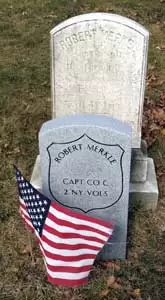
MERKLE, ROBERT (1830-1862). Captain, 20th New York Infantry, Companies H and C. A native of Germany, he enlisted at New York City as a second lieutenant on May 3, 1861, and was commissioned into Company H of the 20th New York three days later. Merkle was promoted to first lieutenant on August 27, 1861, and to captain effective upon his simultaneous transfer to Company C on July 11, 1862. Wounded in action at Antietam, Maryland, on September 17, 1862, he succumbed nine days later at Sharpsburg, Maryland. Section 115, lot 13536 (Soldiers’ Lot), grave 7.
MERRICK, JAMES (1834-1892). Private, 145th New York Infantry, Company A; 150th New York Infantry, Company K. An Irish native, the 1860 census and the 1863 Draft Registration note that he was a boot maker living in Brooklyn. After enlisting at New York City as a private on August 28, 1862, Merrick mustered into the 145th New York on September 11, and was transferred into the 150th New York on December 9, 1863. He mustered out on June 8, 1865, at Washington, D.C.
According to the 1870 census, Merrick was a boot maker with a personal estate of $300; the 1880 and the 1892 censuses and the 1887 and 1891 Brooklyn Directories list him as a shoemaker. His last residence was on Carroll Street in Brooklyn. He succumbed to pneumonia. Section 121, lot 11189.
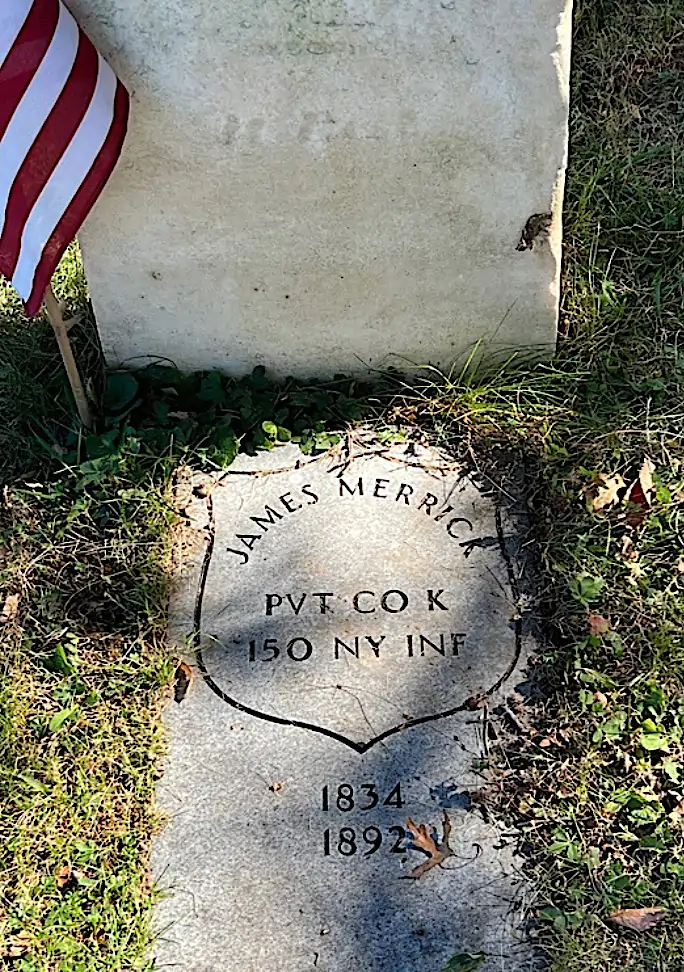
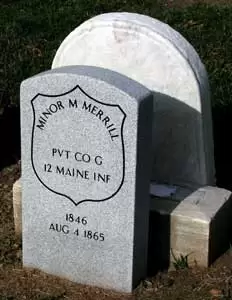
MERRILL, MINOR M. (1846-1865). Private, 12th Maine Infantry, Company G. Born in Maine and a resident of Harmony there, he enlisted as a private on March 1, 1865, and mustered into the 12th Maine. He died of chronic diarrhea on August 4, 1865, at David’s Island, New York Harbor. Merrill was interred at Green-Wood the next month on September 27. A marble Veterans Administration stone was ordered for him early in the 20th century. Section 115, lot 13536 (Soldiers’ Lot), grave 94.
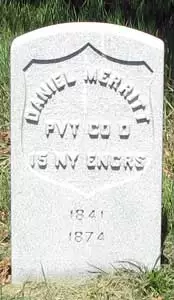
MERRITT, DANIEL (1841-1874). Private, 15th New York Engineers, Company D. A native of Philadelphia, Pennsylvania, Merritt enlisted as a private on May 24, 1864, the same date that he mustered into Company D of the 15th New York Engineers. As per his muster roll, he was a carpenter who was 5′ 8¼” tall with blue eyes, brown hair and a fair complexion. He mustered out on July 2, 1865, at Washington, D.C.
As per his obituary in the New York Herald, he was a member of the Order of United American Mechanics, an anti-Catholic Nativist group founded in Philadelphia in the 1840s, which provided social benefits to its members and was against “cheap” foreign labor. The organization, despite its name, had nothing to do with union activity. Members of the organization were invited to attend Merritt’s funeral and were asked to wear a funeral badge and dark clothes. His last address was 6 Eldridge Street in Manhattan. His death was attributed to rheumatism. Section 126, lot 5047, grave 894.
MERRITT, GEORGE W. (or J. W.) (1837-1912). Captain, 51st New York Infantry, Company E; private, 71st Regiment, New York State Militia, Company E. Born in New York City, Merritt served for three months in the 71st Regiment in 1861. Subsequently, he re-enlisted at New York City as a private on September 13, 1861, was promoted to captain the next day, and mustered into the 51st New York four days later. He was discharged on September 9, 1862. In 1904, he applied for and was granted a pension, certificate 1,098,384. The 1905 New York State census reports that he was a salesman; the 1910 census states he was a liquor salesman. As per his obituary in the New York Herald, which confirms his Civil War service, he was a member of the Freemasons and John A. Dix Post #135 of the G.A.R. The obituary indicates that he died from a complication of ailments. He last lived at 246 West 129th Street in Manhattan. Mary Merritt, who is interred with him, applied for and received a widow’s pension in 1912, certificate 753,699. Section L, lot 20921, grave 2.
MERRITT (or MARRITT), JEROME W. (1834-1909). Sergeant, 8th Connecticut Infantry, Company B. A native of Massachusetts, he was a resident of Suffield, Connecticut, when he enlisted as a sergeant on August 28, 1861. He mustered into the 8th Connecticut on September 27, was reduced in rank to private due to sickness, and was discharged for disability on September 12, 1862. On March 3, 1865, he applied for an invalid pension, application 62,581, but there is no evidence that it was certified. As per the 1870 census, he was a bookkeeper; he is listed as a clerk on the 1880 census and as a bookkeeper on the 1892 New York State and 1900 censuses. His last residence was in Suffern, New York and his death was caused by apoplexy. Section 196, lot 30079.
MERRITT (or MERRIT), JOHN B. (1843-1865). Private, 106th New York Infantry, Company E. After enlisting as a private at New York City on October 13, 1864, Merritt, a New York City native, mustered immediately into the 106th New York Infantry. As per his muster roll, which spells his name as “Merrit,” he was a clerk who was 5′ 5½” tall with hazel eyes, black hair and a dark complexion. Having suffered a gunshot wound to the knee received in battle (most likely at the Battle of Petersburg, Virginia), he died at Judiciary Square Hospital in Washington, D.C., on April 29, 1865. Merritt was taken home and was interred at Green-Wood on May 4, 1865. Section B, lot 8575, grave 482.
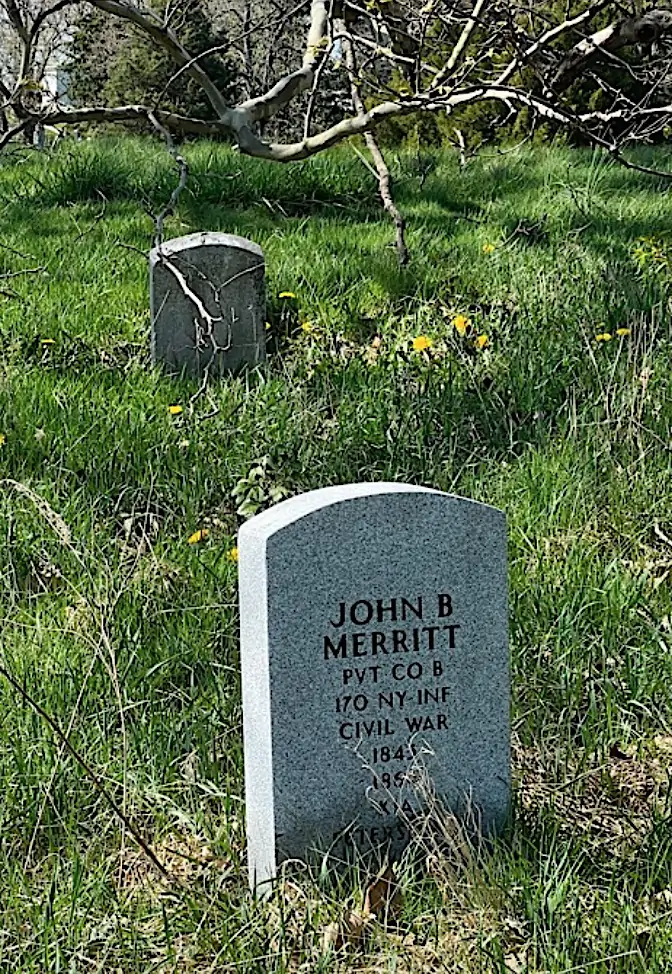
MESCH (or MASCH, MOESCH), LOUIS (1835-1886). First lieutenant, 119th New York, Company B; second lieutenant, 3rd New Jersey Cavalry, Company K; corporal, 68th New York Infantry, Companies I and D. Originally from Saxony, Germany, Mesch’s service to his adopted country is recorded under the names Mesch, Moesch, and Masch. He enlisted as a private at New York City on August 16, 1861, mustered into Company I of the 68th New York on that day, transferred intra-regimentally to Company D that same month, was promoted to corporal at some point, and was discharged for disability on April 7, 1862, at Hunter’s Chapel, Virginia. After re-enlisting at New York City as a first sergeant on July 9, 1862, he mustered into the 119th two months later on September 4. As per his muster roll, he was a clerk who was 5′ 6″ tall with grey eyes, brown hair and a fair complexion. He was promoted to second lieutenant on December 6, 1862, to first lieutenant on May 10, 1863, and was discharged on August 18, 1863. Returning to service on November 30, 1863, Mesch enlisted as a sergeant and mustered into the 3rd New Jersey Cavalry on March 24, 1864. He was promoted to first sergeant on May 18, 1865, and to second lieutenant on August 4, 1865, but did not muster in at that rank. On August 1, 1865, he mustered out at Washington, D.C.
The 1870 census reports that Mesch was a manufacturing clerk. In 1872, he applied for and was granted an invalid pension, certificate 122,333. According to the 1880 census, he was a salesman; the 1884 New York City Directory lists him as a clerk. A resident of Manhattan, he lived at 340 East 6th Street at the time of his death from heart disease. His widow, Agnes Mesch, applied for and received a pension in 1886, certificate 258,078. Section 17, lot 17245, grave 983.
MESEROLE, ISAAC (1818-1904). Private, 133rd New York Infantry, Company F; 3rd Infantry, Veteran Reserve Corps, Company G. Born in New York City, his ancestors settled in Greenpoint, Brooklyn, in the early 18th century. Meserole was listed as a house painter on the 1850 census. He was also in the house decorating business. During the Civil War, he enlisted as a private at Brooklyn on August 21, 1862, and mustered into the 133rd New York on September 24. As per his muster roll, he was 5′ 7″ tall with blue eyes, brown hair and a dark complexion. On April 3, 1864, he was transferred into the 3rd Infantry, Veteran Reserve Corps, from which he was discharged on July 10, 1865, at Burlington, Vermont.
An article in The New York Times on September 22, 1865, notes that Meserole and another man were seriously hurt when they were painting a gable on a house on 3rd Street. The scaffolding gave way, throwing both men to the sidewalk; Meserole suffered severe internal injuries. He is listed as a painter in the 1874 and 1884 Brooklyn Directories and as a watchman in the 1881 Brooklyn Directory and 1892 census. On January 27, 1887, The New York Times reported that Meserole, while on duty as a watchman for the dry goods store of Conkling & Chivvis on 23rd Street and Sixth Avenue, smelled smoke around 9:00 p.m., realized that the calico cloths were on fire and then ran from the building to alert a policeman to sound the fire alarms.
After he retired from the house decorating business, Meserole remained active in Democratic Party politics and was a charter member of the Mansfield Post #35 of the G.A.R. In 1890, his application for an invalid pension was granted, certificate 715,757. His obituary in the Brooklyn Daily Eagle, which confirms his Civil War service, reports that he was buried with the flag that he had carried in many battles as color bearer of the 133rd and which he had always treasured and talked about. That obituary notes that he kept that flag and held it against his chest when he said his final goodbyes to his wife before he died. Many veterans attended his funeral services. He last lived at 70 Williams Avenue in East New York, Brooklyn. Upon his death in 1904 from arteriosclerosis, Caroline Meserole, who is interred with him, applied for and received a widow’s pension, certificate 551,566. Section 194, lot 29716, grave 8.
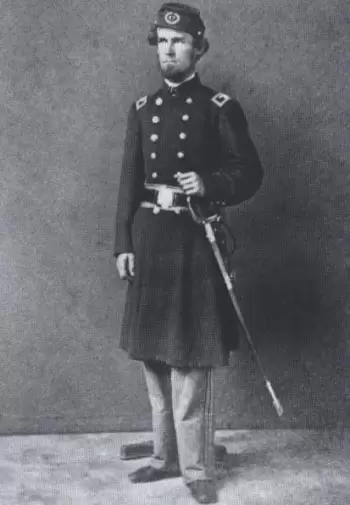
MESEROLE, JEREMIAH VANDERBILT (1833-1908). Brigadier General, 47th Regiment, New York State National Guard; sergeant, 7th Regiment, New York State Militia, Company D. Jeremiah Meserole descended from a French Huguenot family that settled in Williamsburg, Brooklyn, in 1669. Prominent in the Williamsburg and Greenpoint sections of Brooklyn, his surveying firm, Van Alst & Meserole, laid out many of the streets, parks and piers in the Eastern District of Brooklyn. As per his obituary in The New York Times, he was also a baseball player in his youth for the Putnam Club.
He enlisted in the 7th New York State Militia in 1855, and at the outbreak of the Civil War was a sergeant of Company D. His obituary notes that he served with the 7th Regiment when it was activated in 1861. Subsequently, he organized the 47th New York National Guard in 1862 in Williamsburg, was elected its colonel, and was commissioned on May 27, 1862. He mustered out after three months on September 1 at Brooklyn, was commissioned colonel of the 47th when it was reactivated on June 17, 1863, and mustered out at Brooklyn after 30 days on July 23. Meserole remained in command of the unit until 1868 when he became brigadier general of the Eleventh Brigade where he served for eight years.
Returning to his work as a surveyor, Meserole later became president of the Williamsburg Savings Bank in 1891, a position he held for eighteen years, taking a leave of absence shortly before his death. In addition, he was a brigade commander in the New York National Guard. He applied for and was granted an invalid pension in 1908, certificate 1,147,737. His obituary lists his membership in many organizations including the Freemasons, Sons of Temperance, the Union League and the Accomac Hunting Club of Virginia. A resident of Washington Avenue in Brooklyn, he died at his summer home in Far Rockaway, New York. His death was attributed to arteriosclerosis. Section 140, lot 27020.
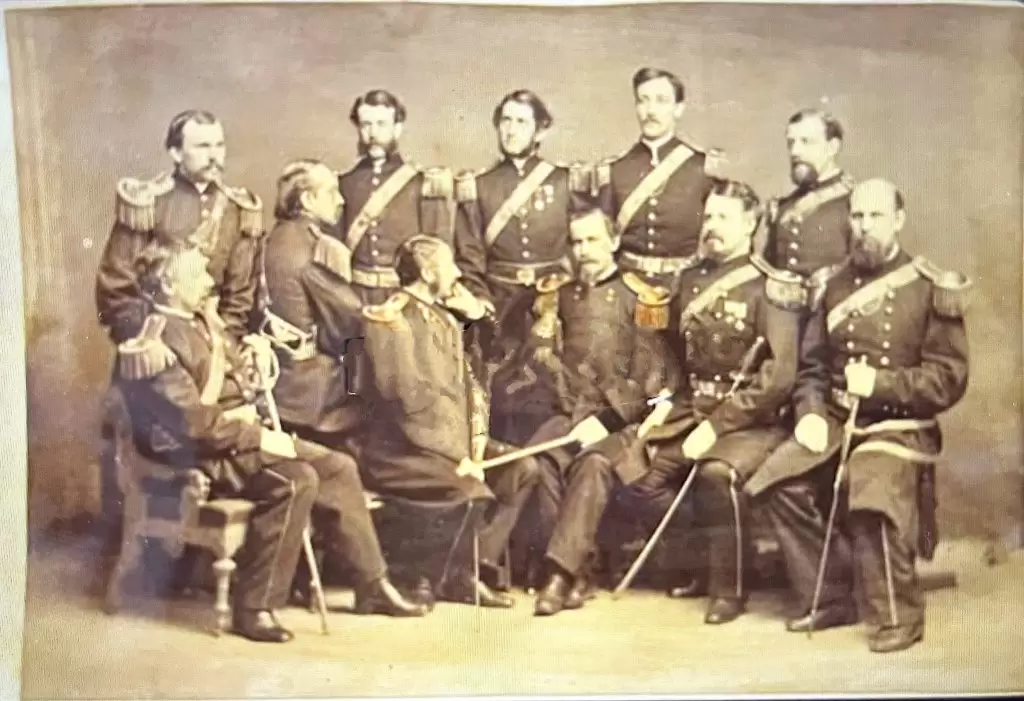
MESSICK, OTIS M. (1837-1885). Colonel, 11th Texas Cavalry, Confederate States of America. Born in Owingsville, Kentucky, he was living there at the time of the census of 1850. Messick first enlisted in the United States Army in 1855 and rose to the rank of sergeant. He re-enlisted on July 5, 1858, at Lexington, Kentucky, and was assigned to the 1st Cavalry, Company C. At that time, he was a plasterer who was 5′ 5½” tall with hazel eyes, brown hair and a fair complexion. The 1860 census indicates that he was living in Grayson, Texas, where he relocated after his military service and where he practiced medicine.
His Civil War service is detailed by Bruce S. Allardice in Confederate Colonels: A Biographical Register (University of Missouri Press, 2008). Messick first served as regimental adjutant for the 11th Regiment, Texas Cavalry, also known as Young’s Regiment, 3rd Cavalry, with the rank of lieutenant. According to Allardice, it is unclear whether his position was considered military-on the Confederate rolls-or civilian. Messick was dropped from the rolls early in 1862 but reappeared as a major on April 11 with an official promotion date of May 8, 1862. Although there were irregularities in the election of officers in the 11th Cavalry and Messick’s promotion was rejected by the Confederate Senate, Confederate General Joseph Wheeler, head of the Cavalry Corps of the Army of Tennessee, appointed Messick to his staff as corps provost marshal. Subsequently, Messick was promoted to lieutenant colonel in December 1864 and to colonel on April 25, 1865, when the unit surrendered. He was paroled on July 11, 1865, at Rowan County, North Carolina. Like many other Confederates, Messick fled to Mexico after the War and became a merchant in Tuxpan; he served as United States consul for that city in 1883. He died from diarrhea at Brooklyn Hospital. Section ?, lot 5499, grave 1443.
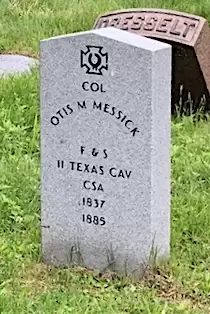
METTLER, ISAAC S. (or T.) (1831-1905). Lieutenant colonel, 21st New Jersey Infantry. Born in New Brunswick, New Jersey, Mettler’s parents were well-known in Hunterdon County and traced their roots to colonial times. Mettler served in the 12th Regiment, New York State National Guard before the Civil War. During the Civil War, he enlisted on September 6, 1862, and was commissioned into the 21st New Jersey as lieutenant colonel on September 15. He mustered out on June 19, 1863, at Trenton, New Jersey. His obituaries in the Jersey Journal [Jersey City, New Jersey], and the Brooklyn Standard Union, which confirm his Civil War service, both report that he mustered out as a colonel. However, that does not appear to be the case; it appears that his highest rank was lieutenant colonel.
The Trenton State Gazette reported on August 17, 1874, that Col. Isaac T. Mettler donated the colors of the 21st New Jersey Volunteers to be placed with other trophies of the Civil War for preservation. That article notes that the 21st was formed on August 4, 1862, when President Abraham Lincoln called for a draft of three hundred thousand militia. The regiment was composed of eight companies from Hudson County. At the Battle of Fredericksburg, Virginia, in May 1863, the regiment was under heavy fire and its colonel, Gilliam Van Houten, fell mortally wounded, was taken prisoner, and died the next day. His body was recovered and returned home. Mettler then took command of the regiment. General Neil, the brigade commander said of that battle, “I have been through the Mexican and Indian War, and in all the battles of the Army of the Potomac up to the present time, but I never before experienced so heavy an infantry fire as that directed against the 21st New Jersey Regiment during the assault of rebels upon by lines.” According to the 1863 Draft registration, he was a clerk.
The 1880 census notes that Mettler was a fire insurance agent and the 1884 New York City Directory lists him as being employed in insurance. He was secretary of the Merchants’ Fire Insurance Company in Manhattan until its dissolution in about 1893. The Veterans Schedule of 1890 confirms his Civil War service but indicates his rank as lieutenant colonel. He made his home in Clinton, New Jersey, and moved to Brooklyn shortly before his death. In 1903, his application for an invalid pension was granted, certificate 1,110,456. As per his obituary in the Jersey Journal, he was a member of the Veterans’ Association of the 12th Regiment, New York State National Guard and a past commander of Van Houten Post#3 of Jersey City’s G.A.R. The Brooklyn Standard Union reports that he also belonged to the American Legion of Honor and the Royal Arcanum Shore Club. He owned a naphtha launch (a small boat powered by naphtha fuel) and enjoyed spending time on the water. He last lived at 441 3rd Street in Brooklyn. He died from gastritis after being ill for a year. A widower, he was survived by three of his four children. Section K, lot 13688.
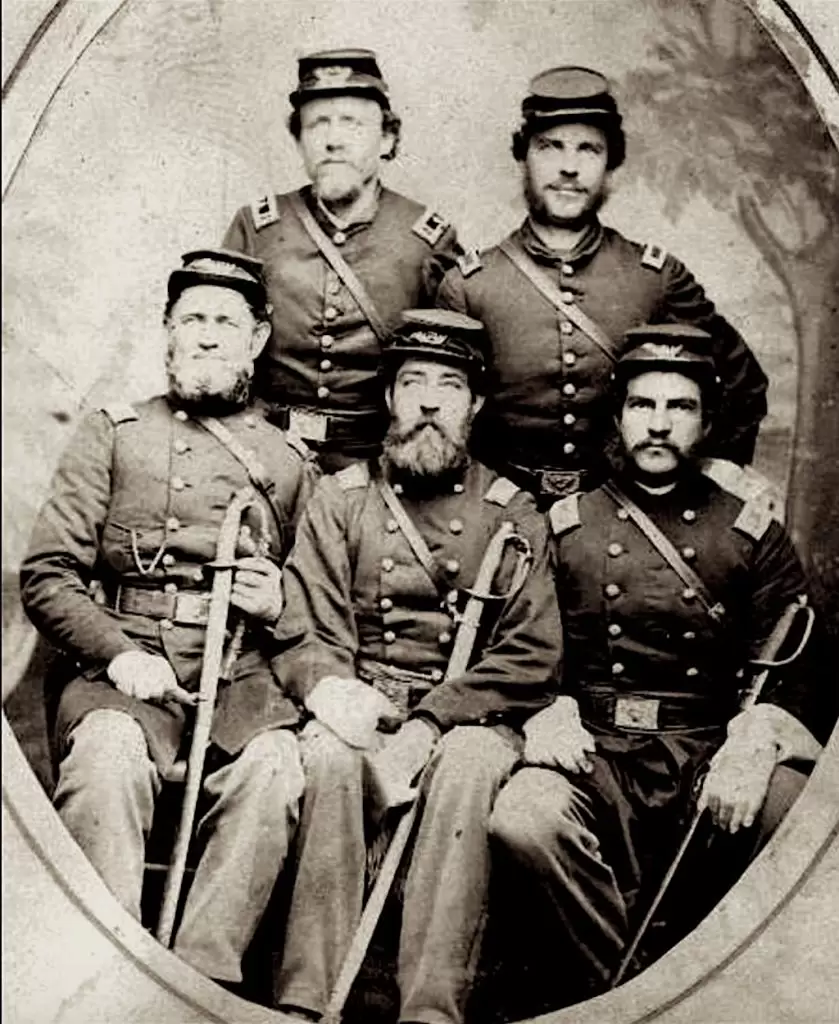
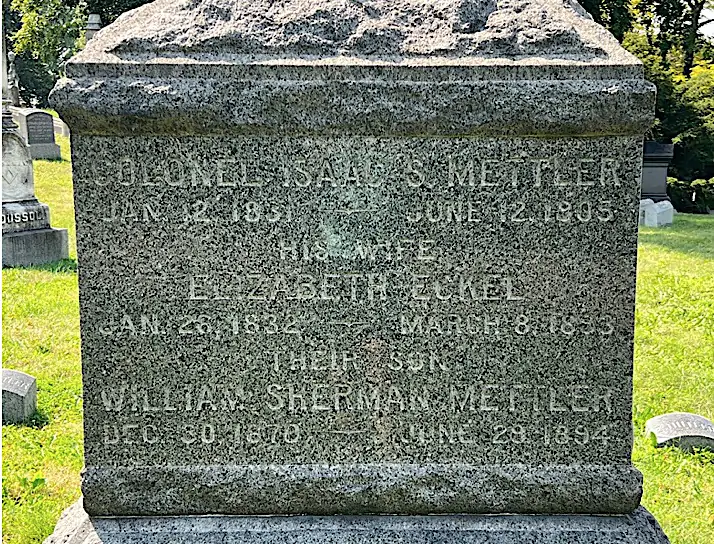
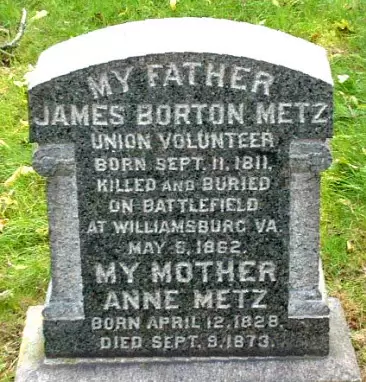
METZ, JAMES BORTON (1811-1862). Private, 72nd New York Infantry, Companies C and G. Metz is not buried at Green-Wood; the monument is a cenotaph on the family’s plot that honors his memory. The New York State census of 1855 reports that Metz was married with two young children, lived in New York City and worked as a burnisher (polisher). After enlisting on April 28, 1861, at New York City, he mustered into the 72nd New York on July 21 of that year, and was killed in action on May 5, 1862, at Williamsburg, Virginia. Soldier records indicate that he served in Companies C and G of the 72nd New York; the date of the intra-regimental transfer is unknown. The marker on the grave at Green-Wood indicates that he is buried at Williamsburg.
Anne Metz applied for a pension before the deputy clerk of the Supreme Court of New York on February 10, 1863, and testified that her husband, whom she married in June 1848, was killed in battle and that she was now a widow with five children. On September 1, 1863, Anne Metz officially received a widow’s pension, certificate 723. Her pension was approved for $8.00 per month. Section 44, lot 4683.
METZGAR (or METZGER), JOHN V. B. (1839-1885). Private, 7th New York Infantry, Company G. Born in New York City, he enlisted and mustered into the 7th New York Infantry on April 23, 1861, and mustered out after serving two years on May 8, 1863. As per the 1880 census, he was a bank clerk. His last residence was at 4 St. George’s Place in Astoria, Queens. He died of valvular heart disease. Section 150, lot 8588.
METZGER, JACOB (1841-1872). Private, 29th New York Light Artillery; 32nd New York Light Artillery. German-born, Metzger enlisted at New York City as a private on July 24, 1861, and mustered into an unknown battery of the 29th Light Artillery on August 12. As per his muster roll, Metzger was a tailor who was 5′ 4″ tall with blue eyes, light hair and a healthy complexion. He re-enlisted on January 1, 1864, and was promoted to corporal on July 25, 1864. On August 15, 1864, he transferred into an unknown battery of the 32nd Light Artillery, was reduced to private on February 19, 1865, and mustered out at New York City on July 12, 1865. The 1870 Brooklyn Directory lists Metzger as a tailor. His last residence was 855 Atlantic Avenue in Brooklyn. His death was caused by phthisis. Section 59, lot 4070, grave 80.
MEYENBORG, HENRY A. (1837-1897). Marine, United States Navy. Born in Hanover, Germany, he immigrated to the United States in 1853. On December 18, 1860, Meyenborg enlisted at Norfolk, Virginia, and entered the United States Marine Corps. He was a clerk who was 5′ 6″ tall with blue eyes, light hair and a fair complexion. On April 5, 1861, he was transferred to the USS Pocahontas, United States Navy. Medical records from the Pocahontas note that he was admitted to the ship’s hospital with catarrh on December 24, 1861, and discharged to duty five days later. He subsequently transferred to the Philadelphia, Pennsylvania, Barracks on September 9, 1862. He was hospitalized there for two days as of April 11, 1863, with dizziness and vomiting and again on August 10, 1863, with dysentery and general malaise. He was discharged at Philadelphia on September 16, 1863, by order of the Secretary of the Navy, upon settlement of accounts.
Meyenborg then studied law, was admitted to the Bar in 1865, and became a noted criminal lawyer. His obituary in the New York Herald reports that he was involved in the Democratic Party in Brooklyn and the Bar Associations in New York City and Brooklyn. At one time, he was counsel to the Brooklyn Board of Supervisors. He was a staff member in the office of General Thomas S. Dakin of the Fifth Brigade (see) and was active in the Cushing Post #231 of the G.A.R. In addition, he was active in the Church of the Atonement in his Park Slope neighborhood. His obituary in the Brooklyn Daily Eagle, which confirms his service in the Navy during the Civil War, reports that he was the attorney general of the National Provident Union and a lodge member of numerous organizations including the Odd Fellows, the Freemasons, and the Order of Mutual Protection.
During the blizzard of March 1888, he was found unconscious in the street, and was revived at a local post office where medical aid was summoned. The lingering effects of this episode contributed to his death. The Brooklyn Daily Eagle’s obituary, in recounting the events after the blizzard, stated that he suffered thereafter from a weakened constitution and that his death was attributed to a “general breaking up” of his system combined with dropsy. He last resided at 263 10th Street in Brooklyn. Augusta Meyenborg, who is interred with him, applied for and received a widow’s pension from the Navy in 1905, certificate 17,459. Section 204, lot 29837, grave 2.
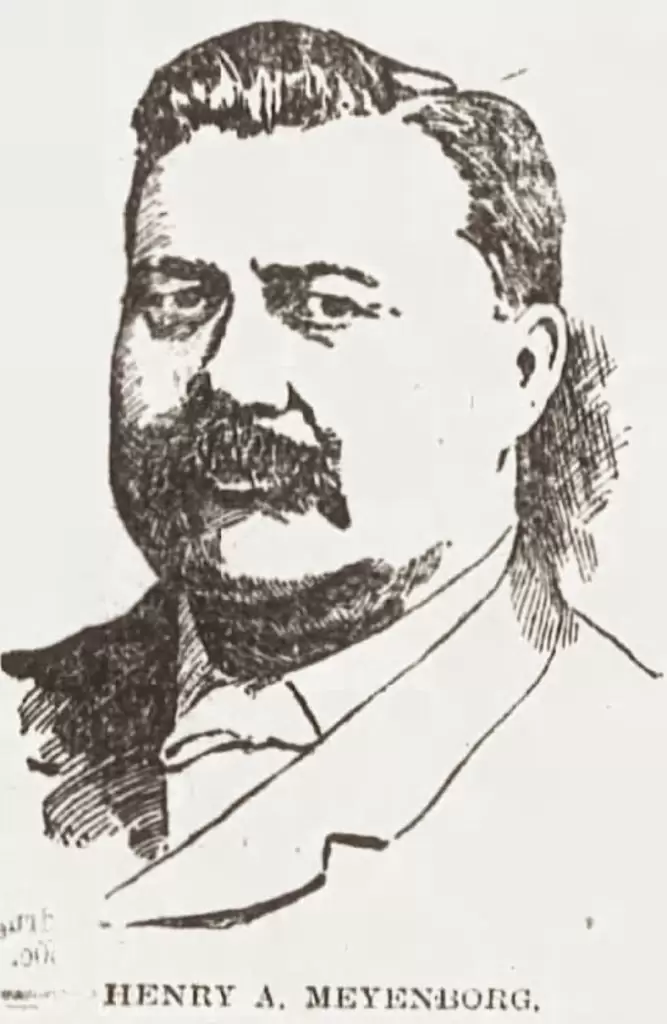
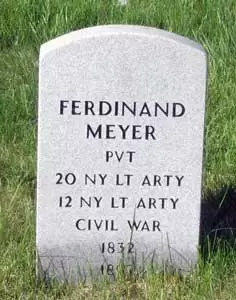
MEYER (or MAIER, MAICE), FERDINAND (1832-1899). Private, 20th Light Artillery; 12th New York Light Artillery. Of German birth, he enlisted at Brooklyn on September 14, 1864, and mustered into the 20th Light Artillery that same day. His muster roll, which carries him as Ferdinand Maier, indicates that he was also borne as Ferdinand Maice. According to that muster roll, he was a mason who was 5′ 11½” tall with grey eyes, brown hair and a ruddy complexion. On February 15, 1865, he transferred into the 12th New York Light Artillery from which he mustered out on June 14, 1865, at Albany, New York.
The censuses of 1870 and 1880 and the 1885 Brooklyn Directory note that Meyer was a paper-hanger. The 1894 Brooklyn Directory lists Meyer in the stationery business. He last lived at 1774 Fulton Street in Brooklyn. His death was caused by pneumonia. Section 17, lot 17245, grave 8.
MEYER, JOHANNES (or JOHANN) (1841-1881). Private, 103rd New York Infantry, Company A. Born in Germany, Meyer enlisted as a private on December 26, 1862, at New York City, and mustered into the 103rd New York that day but was not assigned to a company. Subsequently, he was transferred into Company A of the same regiment on March 14, 1865, and mustered out on December 7, 1865, at City Point, Virginia. He last lived at 152 Willoughby Street in Brooklyn where he died of a carcinoma. Section F, lot 20016.

MEYERS (or MYERS), HIRAM (1837-1906). Sergeant, 170th New York Infantry, Company F. Employed in the saw-mill business, Meyers, who was born in New York City, was 5′ 11″tall with a fair complexion, hazel eyes and brown hair. He enlisted at New York City as a private on August 20, 1862, and mustered into the 170th New York on October 7, 1862. He was detailed as left general regimental guide through December 1862, and was promoted to sergeant on April 1, 1863. His regiment was assigned to the Army of the Potomac and saw action in Virginia at the Battles of the Wilderness, Spotsylvania, Bloody Angle, North Anna, Bethesda Church, and Cold Harbor.
Meyers was shot twice at Petersburg, Virginia, on June 16, 1864, first in the left shoulder and then in the left wrist, an injury that nearly severed his hand. He was removed from the battlefield under fire and taken to the division field hospital at City Point, Virginia. On June 24, he was taken on the steam-ship State of Maine to New York City, arriving on June 27, and entered the hospital at David’s Island in New York Harbor where he remained for six months. He was discharged for wounds on December 15, 1864, having lost the function of his hand and arm.
Meyers returned to his business, the Pollion Mills, on Bond Street in downtown Brooklyn. He applied for and was granted a pension in 1879, certificate 52,995. Active in the G.A.R., where he was one of the original members in New York State, he belonged to the Sedgwick Post #186, then was a charter member of the Abraham Lincoln Post #13, and joined the Ulysses S. Grant Post #327 in 1883. He served as an honor guard when General Ulysses S. Grant’s body was at City Hall and was one of thirteen veterans photographed on this detail. After the Civil War, he lived at 91 3rd Street, Brooklyn, and then relocated to Bangor, Pennsylvania, in 1894. His last residence was in Bangor. After his death from apoplexy in 1906, Ellen Meyers applied for and received a widow’s pension. Section 199-200, lot 23519, grave 3.
MICHAELIS, JOHN AUGUSTUS (1825-1865). Captain, 45th New York Infantry, Company I; ordnance sergeant, 5th Regiment, New York State Militia. As per the 1855 New York State census, Michaelis was a tailor who was born in Germany. In June 1856, he joined the Engineers Company of the 5th New York State National Guard, and was transferred to the non-commissioned staff as sergeant in 1859. During the Civil War, he first served as ordnance sergeant of the 5th Regiment, New York State Militia, when it was called to duty of 100 days in April 1861. Michaelis re-enlisted as a first lieutenant at New York City on September 9, 1861, and was commissioned into the Field and Staff of the 45th New York as a first lieutenant and adjutant on October 8. He was promoted to the rank of captain on November 22, 1862, and transferred to Company I. After he was wounded at Chancellorsville, Virginia, he was taken as a prisoner of war on May 2, 1863. He was exchanged and released on May 16 (although the soldier record says August 15), convalesced at Camp Parole, returned to the rolls in September and was honorably discharged for disability on September 29 by order of the War Department.
An article about his experience at Chancellorsville, “Passed From His Sight: An Incident in the Military Career of Captain Augustus Michaelis,” by Scott Valentine appeared in Military Images (July/August 2011, Vol. 31, p. 26). Apparently, on May 2, 1863, he was standing near a campfire with his men when he heard a deer snorting at the same time as he heard muskets off to the west. The campsite suddenly was overrun by a menagerie of deer and small game birds. In a surreal setting, the men of the 45th were attacked by Brigadier General Robert Rodes’s Alabama Brigade, taking part in Confederate General Stonewall Jackson’s flank attack. Michaelis felt a sharp pain in his shoulder, became short of breath, and sank to the ground in a bewildered state. Meanwhile, the men around him were grabbing muskets and cartridge boxes and forming lines of fire. Michaelis tried to hold onto the flag of the color bearer but lacked the strength to leave his spot. Before Michaelis lost consciousness, his new boots were taken by an unkempt Alabama rebel. When he awoke, he was in Rodes’s field hospital, and then transported in a rickety wagon to Guinea Station, Virginia, a torturous ride along with 6,000 other Union prisoners. At Guinea Station, he shared a fly tent with three other Union officers; enlisted prisoners slept on the bare floor. Five days later, after his exchange, he was moved to the Union camp at Point Lookout, Maryland, to regain his health.
Although he applied for an invalid pension on November 23, 1863, application 36,451, it was never certified. In his pension records it was reported in a letter dated November 21, 1863, that during Michaelis’s brief imprisonment “his constitution suffered from the inclemency of the weather having been exposed to a drenching rain for thirty hours at Guinea Station on the 5th and the 6th of May, from forced marches and lack of food to such a degree that he was put under medical treatment in the Parole Camp immediately on his arriving at Annapolis.” Days later, on May 24, he was sent to the U.S. Hospital #2 and on June 16, 1863, was bedridden with a severe attack of inflammatory rheumatism complicated by bowel problems. That letter went on to add that Michaelis was unable to join the Invalid Corps because he remained in feeble health and was still troubled by a bowel discharge. The pension was rejected on June 8, 1864. Apparently, the rejection was due to miscommunication when Michaelis thought he said that he was sick 19 years ago and was never sick since that time; the Sanitary Commission statement indicated that Michaelis said that he suffered for the last 19 years. Sadly, Michaelis received this explanation five days before his death and swore that he never made such a statement contrary to the truth.
Another testimonial to Michaelis by Louis Burger (see), colonel of the 5th Regiment, on February 7, 1865, praised him as a patriot and brave man who displayed “great energy and capability in performing his duties.” He last lived at 27 Bayard Street in Manhattan. His gravestone’s inscription that he served in the 49th New York is incorrect. His gravestone also has an error as to the date of death; as per his death certificate, he died on March 28, 1865, from heart disease. Caroline Michaelis applied for and received a widow’s pension in July 1865, certificate 103,972. It is unclear what John Michaelis’s relationship is to Mary, whose name is inscribed under his on the tombstone. Section 206, lot 21347, grave 380.
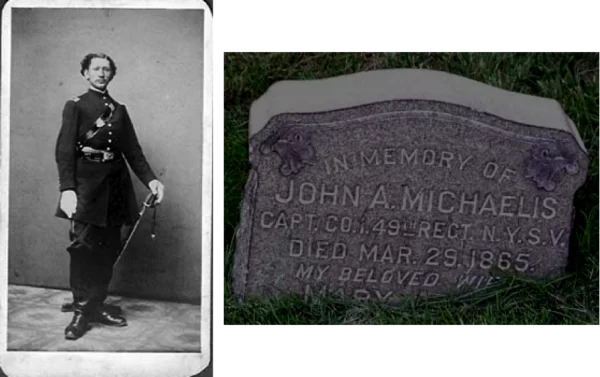
MICHAELS, AUGUSTUS C. (1845-1875). Private, 13th Regiment, New York State National Guard, Company F. Originally from France, Michaels enlisted at Brooklyn as a private on May 26,1862, the same date that he mustered into the 13th Regiment. He was discharged on September 12, 1862, at Brooklyn, at the expiration of his enlistment. His last address was in New York City. Section 15, lot 17263, grave 426.
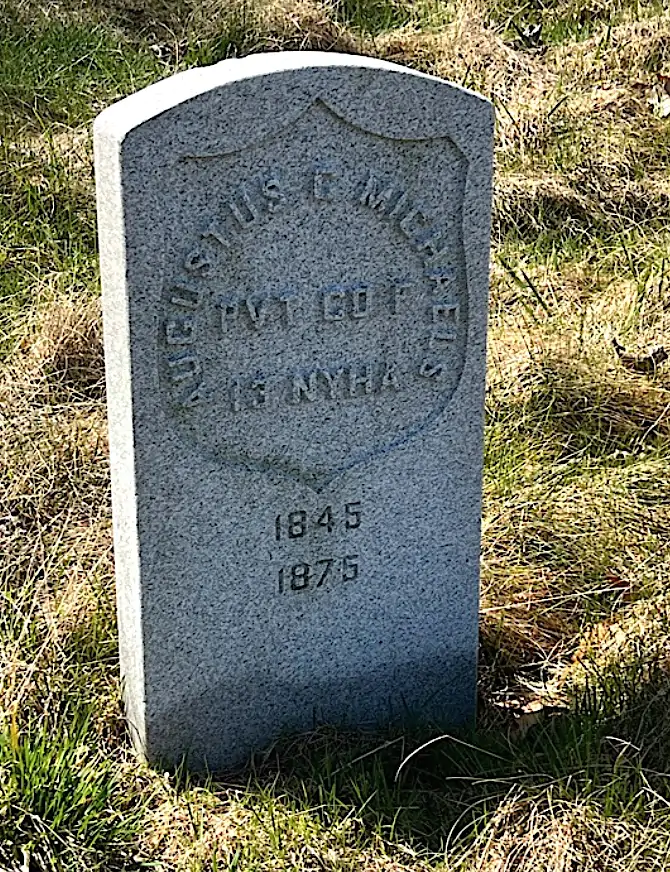
MICHELL (or MICHEL, MITCHELL), HARRY W. (1837-1908). First lieutenant, 84th New York (14th Brooklyn) Infantry, Company C. Michell, who was born in Manhattan, was educated in the public schools and then at Schoharie Academy and the Hamilton Collegiate Academy. He then studied law in the office of Judge Henry A. Moore in Brooklyn.
During the Civil War, he enlisted at Brooklyn as a private on April 18, 1861, and mustered into the 14th on May 23. Michell was incorrectly listed in the regimental history as “Mitchell.” He was promoted to corporal on August 1, 1861, and to sergeant on November 1. His obituary in the Brooklyn Daily Eagle notes that he was slightly wounded at the Battle of South Mountain, Maryland, on September 14, 1862. After being promoted to first sergeant on November 1, 1862, he rose to second lieutenant on February 1, 1863, and to first lieutenant on April 5, 1863. He was twice wounded at Gettysburg, Pennsylvania, likely on July 1, 1863, then taken prisoner at the Wilderness, Virginia, on May 5, 1864At the time of his capture, he was the acting adjutant general on the staff of Brigadier General James C. Rice. His obituary notes that during his imprisonment, he was one of the Union officers moved to Charleston, under the fire of the federal batteries on Morris Island, South Carolina, to prevent their shelling of that city. Michell was paroled on March 10, 1865, and mustered out two days later.
Retaining his interest in military affairs, Michell remained with the 14th National Guard; his service with that regiment totaled thirty-six years. He posed for the 14th’s Monument at the Railroad Cut at Gettysburg and from 1885 to 1898, was the 14th’s colonel. In addition, he was active in Ulysses S. Grant Post #327 of the G.A.R. He was also active politically and believed in “organization politics,” following worthy leaders and having no faith in “bosses.” He ran successfully as Kings County registrar, county clerk and supervisor at large. In 1907, he applied for and received an invalid pension, certificate 1,145,092.
As per his obituary in the Brooklyn Daily Eagle, Michell worked for twenty years in the Department of Taxes in the old City of Brooklyn. Holding the position as the special deputy excise commissioner for Brooklyn, he was known as an excellent administrator; his department was a model for the state. His department was responsible for issuing liquor and tobacco tax certificates in the 1890s into the 1900s. When his office was audited, it was determined that his records were error-free, collections were promptly handled and all transactions were handled efficiently; he was very proud that this was done without hiring the number of staff that was officially allowed. His obituary noted that he hired honest and efficient workers who honestly handled millions of dollars in business dealings.
In addition to his work and military interests, Michell was a member of the Stuyvesant Heights Club in his Brooklyn neighborhood. He last lived at 379 Macon Street but he died at his summer home in Bayport, Long Island. His obituary notes that he had been at work at the Eagle Building the day before his death and that his friends and office subordinates, who were shocked by his sudden death, had remarked on his fine appearance and apparent good health that day. His death was attributed to apoplexy. After his death, the state had to appoint a specially licensed deputy to sign off on the licenses that Mitchell was responsible for. Officers from the 14th Regiment offered condolences to the family and planned to hold ceremonies honoring his military contributions; the officers offered to parade at his burial if the family so desired. He was survived by his wife and two daughters. After his death in 1908, his widow, Phoebe Michell, who is interred with him, received a pension, certificate 667,666. A document signed by Michell as colonel of the 14th Regiment, dated January 31, 894, that was a receipt for the 14th Regiment appropriations for the military account in the amount of $150 was offered for sale on eBay in 2020. Section 185, lot 18546.
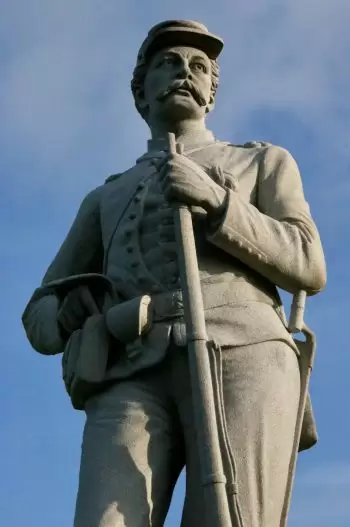
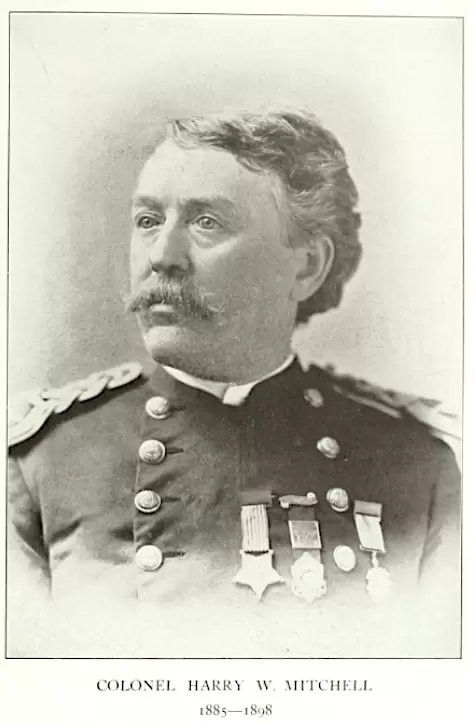
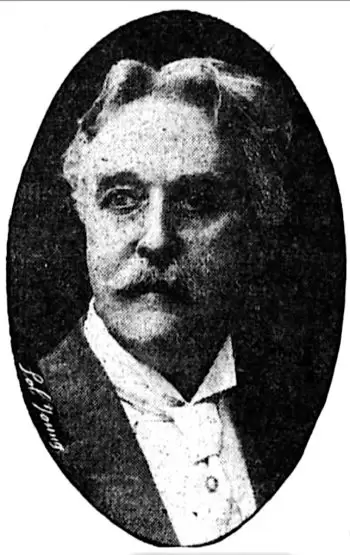
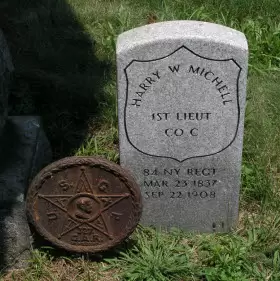
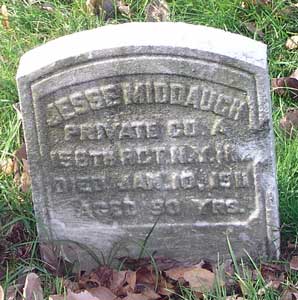
MIDDAUGH, JESSE (1821-1911). Corporal, 156th New York Infantry, Company F. A native of Woodstock, New York, Middaugh first served his country in the Mexican War. He enlisted at Kingston, New York, on March 22, 1847, and mustered out at the expiration of service on August 22, 1848, at Fort Hamilton, Brooklyn. He received a pension for his service in that conflict, certificate 4,139. He subsequently served in the Civil War. After enlisting as a corporal on August 29, 1862, at Kingston, New York, he mustered into the 156th New York on November 17. As per his muster roll, he was a shoemaker who was 5′ 8½’ tall with blue eyes, brown hair and a light complexion. He was reduced in rank to private on November 17, 1864, and mustered out on October 23, 1865, at Augusta, Georgia.
The 1870 and 1880 censuses indicate that he was a cobbler (shoemaker) who lived in Saugerties, New York. Middaugh is listed as a “re-enlisted veteran” on the 1890 Veterans Schedule. He was working as a repairer of boots and shoes and living in Saugerties on the 1900 census; at the time of the 1910 census, he was living with his daughter in Brooklyn. His last residence was 4717 3rd Avenue in Brooklyn. The cause of his death was cancer. His government-issued gravestone confirms his service in the 156th. Section 127, lot 16311, grave 28.
MIDDLETON, BENJAMIN F. (1842-1864). First lieutenant, 139th New York Infantry, Companies C and G; sergeant, 84th New York (14th Brooklyn) Infantry, Company E. Middleton was born in New York and was living with his family in Raritan, New Jersey, at the time of the 1860 census. He was a brother of Stiles Middleton (see). After enlisting as a corporal at Brooklyn on April 18, 1861, he mustered into the 14th on May 23, 1861. Wounded on July 21, 1861, at First Bull Run, Virginia, he was listed as a deserter on February 4, 1862, at Upton’s Hill, Virginia. However, that is inaccurate; another soldier record indicates that he was discharged at Upton’s Hill on that date. On September 9, 1862, he re-enlisted at Brooklyn as a second lieutenant and was commissioned into Company C of the 139th New York. Promoted to first lieutenant on October 18, 1863, and transferred to Company G on that date, he was later wounded at Cold Harbor, Virginia, on June 2, 1864. Killed in action by a gunshot wound through the heart on September 29, 1864, at Chaffin’s (Chapin’s) Farm, Virginia, he was interred at Green-Wood on October 14; the Green-Wood database indicates a burial date in 1865, but that is an apparent error as evidenced by obituaries in local newspapers.
As per Middleton’s obituary in the New York Tribune, which confirms that he was killed in battle, he was a Freemason. Members of the 14th and 139th New York Regiments were invited to attend his funeral at the M. E. Church on Fleet Street in Brooklyn. The Brooklyn Daily Eagle reported on his funeral on October 15, 1864, noting that the observance was attended by his mourning parents, a large circle of relatives, hundreds of friends and fellow citizens including fellow Masons and officers and men of several military organizations. His rosewood coffin, which bore a plaque inscribed with his name and place of death, contained his cap and sword. The clergyman, who officiated at the funeral, noted that there was consolation in that Middleton fell while battling for his country.
In the aforementioned obituary, the Brooklyn Daily Eagle printed the contents of a letter written by Lieutenant Colonel Mulcahy of the 139th to his son, describing the engagement at the capture of Fort Harrison in which Middleton was killed:
During the fight the 139th being on the left, kept up a continuous rattle of musketry, and shattered the enemy’s ranks terribly. Gen. Stannard who commanded the first division, and who lost an arm in the action, stated that the 139th did the most execution and captured the most prisoners. We captured this fort on the 29th under a murderous fire of artillery and infantry. Our skirmishers drove in those of the enemy early in the morning, our heavy column following in an open rolling field without faltering….The column moved over their prostrate comrades. At length the double-quick is ordered. Soon the column halts within two hundred yards of the fort. Here we are allowed breathing time, and mass our troops more closely, being partly protected from the guns of the battery by an elevated piece of ground in front. The command is again given “double-quick march,” “charge bayonets,” huzza, huzza, and the fort is taken; the works are scaled, the victory won, and the old flag planted on the ramparts, where it flutters in the breeze as I write. Our regiment lost up to this time forty-two killed and wounded. Among the killed I am sorry to record poor Lieut. Middleton. He was shot dead by my side with a Minnie ball. He was a brave and patriotic officer, and is much regretted.
In 1884, G.A.R. Post #500 was named in Middleton’s honor. An article in the Brooklyn Daily Eagle on April 7, 1891, featuring the 25th anniversary of the founding of the G.A.R., noted that the Middleton Post was appropriately decorated with tropical plants and the American colors. According to G.A.R. regulations, the 500 guests convened the ceremonies at precisely 8:30 p.m., and listened to the history of the post by the then-commander. It was reported that the post consisted of 130 members, 13 members had passed away in the seven years of the post’s existence, and $1,023.25 had been distributed for the relief of widows and orphans of veterans. In 1895, Angeline Middleton, his mother, applied for and received a survivor’s pension, certificate 421,972. Section 11, lot 4623.
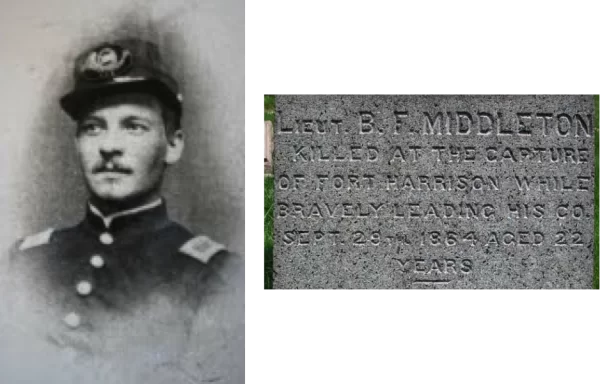
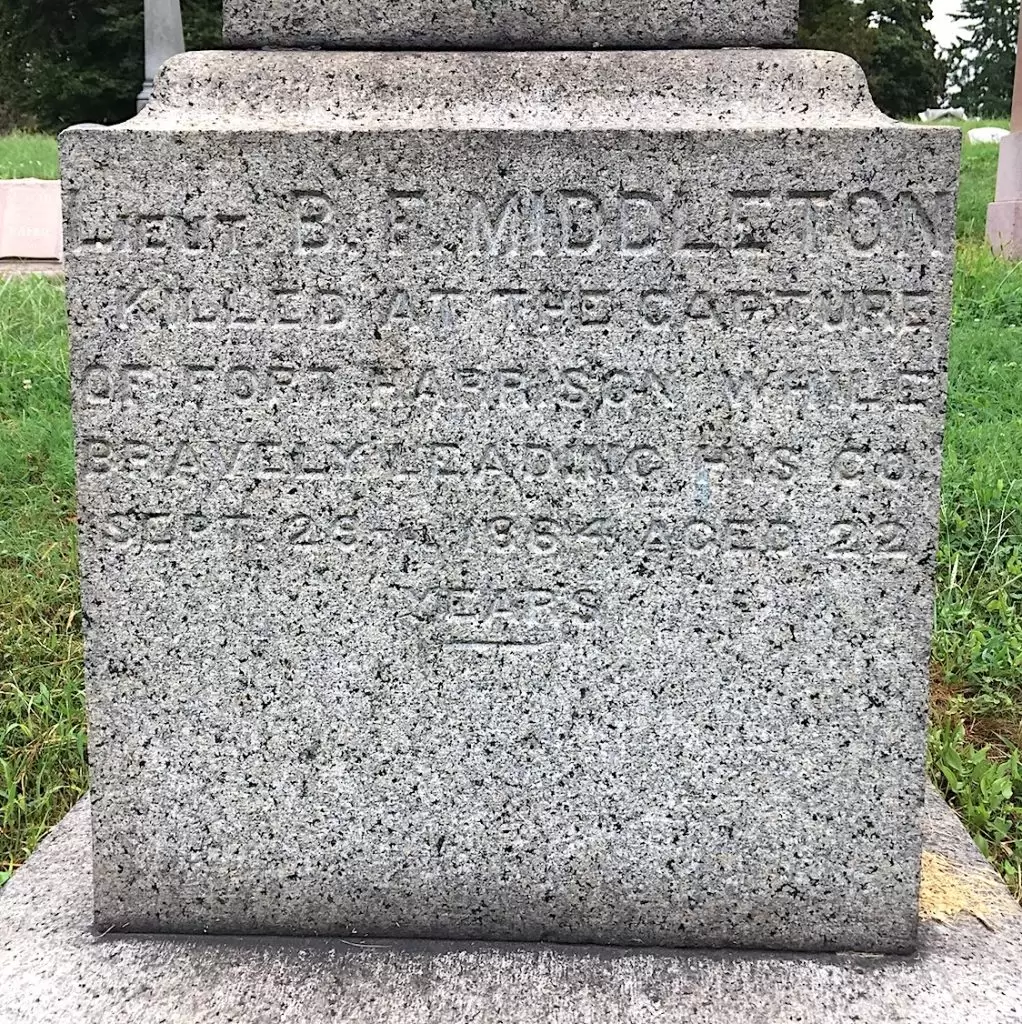
MIDDLETON, EDWARD (1810-1883). Captain, United States Navy. Middleton was born in Charleston, South Carolina, the son of Henry Middleton, a governor of South Carolina and minister to Russia. His lineage can be traced to his grandfather, Arthur Middleton, one of the signers of the Declaration of Independence. Educated in England and France, Edward Middleton entered the United States Navy as a midshipman on July 1, 1828, and served aboard the frigate Java in the Mediterranean Squadron for three years until his transfer to the sloop Vidalia in the West Indies Squadron from 1831 to 1833. He was then stationed on a receiving ship in Brooklyn. Middleton rose to passed midshipman on June 14, 1834, and was assigned to the frigate Constitution in the Mediterranean from 1835 through 1838. He then was aboard the sloop Marion in the Brazil Squadron until 1842; during that time, he was promoted to lieutenant on February 25, 1841. After serving on many ships during the 1840s and early 1850s, he joined the USS Decatur in 1854 and participated in the campaign against the Indian tribes in the Pacific Northwest in Oregon and Washington, was promoted to commander of September 14, 1855, and fought in the attack on Seattle on January 26, 1856.
Upon his promotion to captain on April 24, 1863, he was appointed to special duty in Washington, D.C., then was assigned for two years to the Mare Island Navy Yard in California and later commanded the steam sloop Pensacola. After the Civil War, he was promoted to commodore on November 26, 1868, and assigned to command the steam sloop Lackawanna in the Pacific fleet. In 1870, he was commandant of the Pensacola Navy Yard in Florida. Placed on the retired list December 11, 1872, he was commissioned rear admiral on August 15, 1876. He died in Washington, D.C. An archive of over 500 items related to his life and career is housed at the Louis Round Wilson Special Collections Library in South Carolina. One of his presentation swords from 1852 was offered for sale in 2017 by the Horse Soldier, an enterprise in Gettysburg, Pennsylvania, that specializes in military memorabilia. Section 80, lot 3779.
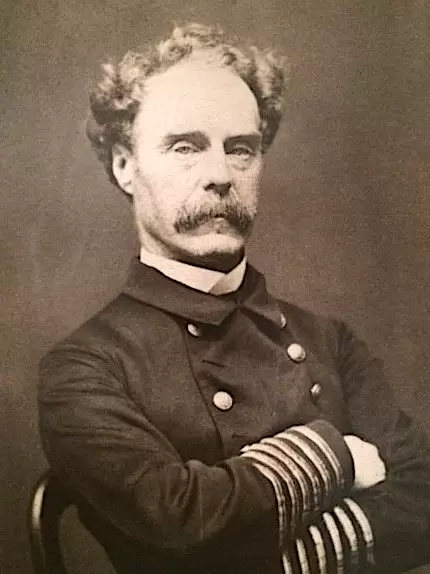
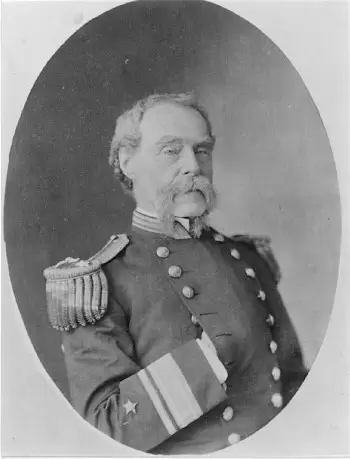
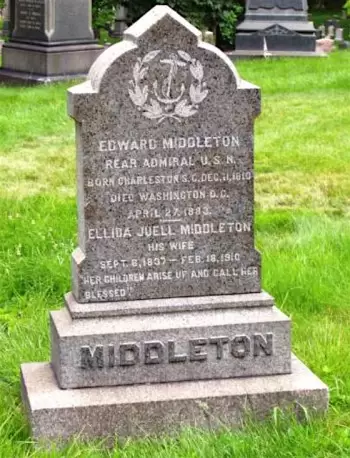
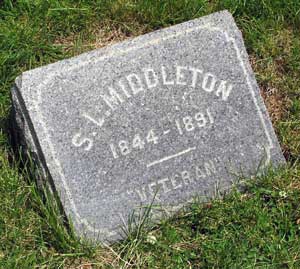
MIDDLETON, STILES (or S. L.) (1844-1891). Corporal, 5th New York Heavy Artillery, Company D; private, 84th New York (14th Brooklyn) Infantry, Company E. A New York native, Middleton was living with his family in Raritan, New Jersey, at the time of the 1860 census. Middleton enlisted at Brooklyn on July 1, 1861, and immediately mustered into the 14th Brooklyn. On July 21, 1861, he was taken prisoner at the Battle of First Bull Run in Virginia, and confined two days later at Richmond, Virginia. A list of injured prisoners noted that Middleton was shot in the thigh and was in good condition when surgeons examined him at Richmond. He subsequently was released and discharged from service on April 15, 1862, at Washington, D.C. After he re-enlisted at Brooklyn as a private on January 25, 1864, he mustered into the 5th New York Heavy Artillery the same day. Taken as a prisoner on June 20, 1864, at New Market, Virginia, he was paroled five months later on November 20 at an unstated place. He was promoted to corporal on March 20, 1865, and mustered out on June 13 at Harpers Ferry, West Virginia.
The 1870 census notes that he was living in Brooklyn where he was a “special” deputy sheriff to his father, Benjamin, who was the deputy sheriff. On February 9, 1875, the Wheeling Register (West Virginia) reprinted a story that had previously appeared in The New York Times on January 30 of that year. Headlined “An Asylum Tragedy,” Middleton was identified as a long-term inmate of the Lunatic Asylum at Flatbush in Kings County. Apparently, Middleton found a hatchet that a plasterer had left at the end of the workday and persuaded the nurse, who had deemed Middleton “harmless,” to let him take the hatchet to his room to place a tack in the wall. He then returned and told the nurse that he had some trouble with a fellow patient, Noble S. Bennett. Mr. Bennett was found by the nurse lying in a pool of blood after sustaining a gash to the head, apparently inflicted by Middleton with the ax. The house surgeon could not help the dying man who succumbed within the hour. According to the 1880 census, Middleton remained an inmate at the Kings County Lunatic Asylum. In 1887, he applied for and was granted an invalid pension, certificate 246,881. He was the brother of Benjamin Middleton (see). His last legal residence was at 75 55th Street in Brooklyn but he was living at the Kings County Insane Asylum at the time of his death. Section 11, lot 4623.
MIDDLETON, WILLIAM H. (1828-1899). First lieutenant, 84th New York (14th Brooklyn) Infantry, Company E. A Brooklynite by birth, Middleton, as a young man, became a clerk for William M. Rogers & Co., fish dealers in the Fulton Market. In 1852, he founded his own fish firm of Middleton, Carman & Co. During the Civil War, he enlisted at Brooklyn as a first lieutenant on April 18, 1861, was commissioned into the 14th Brooklyn on May 23, and discharged on July 29, 1861.
The 1863 Draft Registration indicates that he was employed as a fishmonger. The 1890 Veterans Census confirms his service in the Civil War. As per his obituary in the New York Tribune, he was a member of the Lincoln Club, the Society of Old Brooklynites and the Hoboken Turtle Club. Remaining in the fish business for 50 years, his firm at 70 Fulton Market was incorporated two years before his death. His last residence was at 76 Washington Avenue in Brooklyn where he died from pneumonia. Section 43, lot 558, grave 6411.
MILBANK, ROBERT (1838-1904). First lieutenant, 12th Regiment, New York State National Guard. Born in New York City, Milbank enlisted as a first lieutenant at New York City on May 31, 1862, and was commissioned into the 12th Regiment’s Field and Staff. After being surrendered on September 14, 1862, at Harpers Ferry, now in West Virginia, he was paroled the next day, and mustered out with his company on October 8, 1862, at New York City.
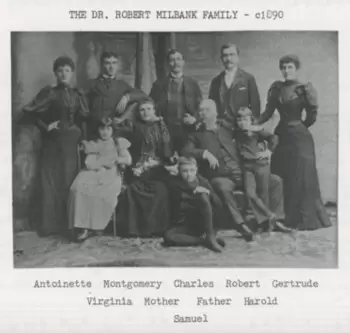
As per his obituary in the Globe and Commercial Adviser (New York), he was a well-known practicing physician. He graduated from the University of the City of New York’s Medical Department in 1878. Dr. Milbank belonged to many medical societies including the County Medical Society, the Academy of Medicine, the Society of the Alumni of Bellevue Hospital, the Medico-Legal Society, and the Northwestern Medical and Surgical Society. At the time of his death, he was a visiting physician to the New York Infant Asylum. The obituary notes that Dr. Milbank last lived at 154 West 48th Street in Manhattan but died suddenly of apoplexy at the home of his cousin in Byram Shore, New York, where he was tending to his cousin’s medical needs. Section 93, lot 2391.
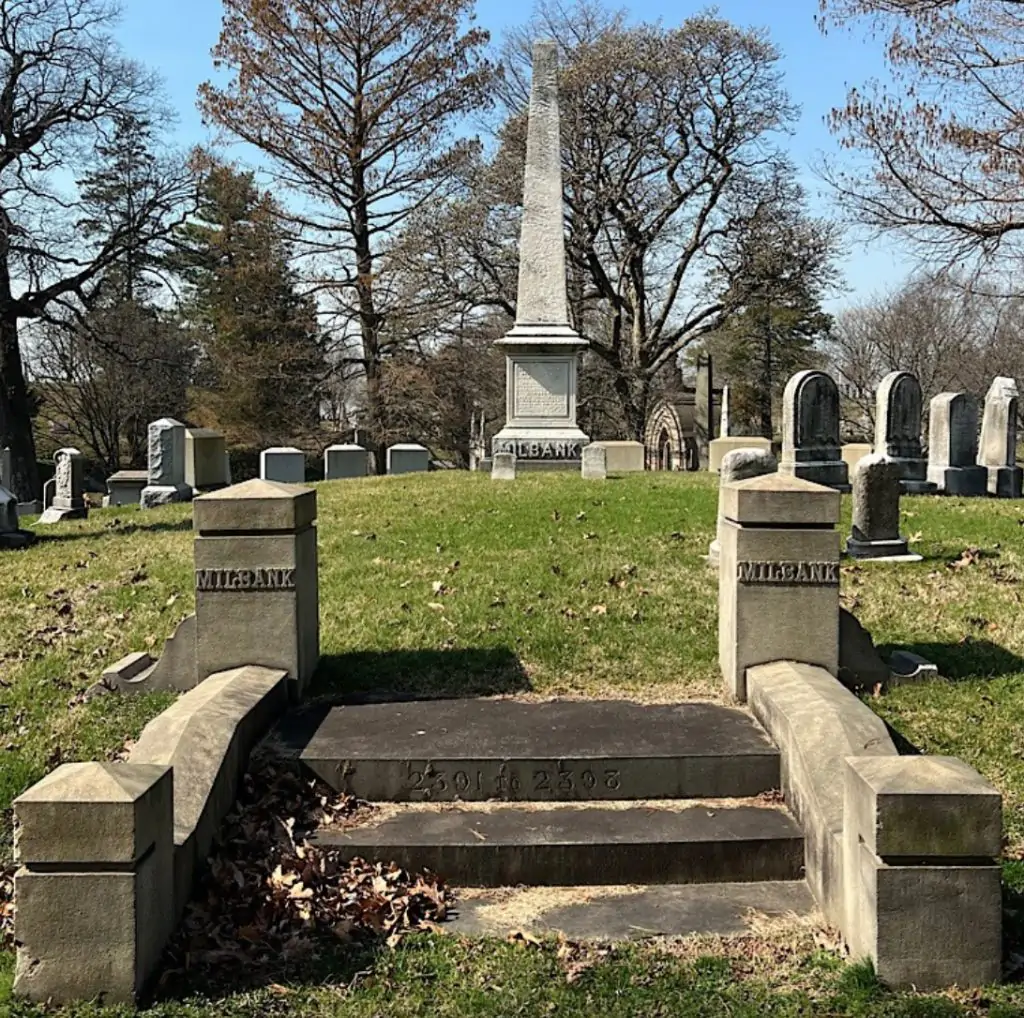
MILDEBERGER, MINARD M. (1827-1880). Private, 12th Regiment, New York State Militia, Company A. Born in New York State, Mildeberger enlisted in 1861 and served for three months as a private when the 12th Regiment was activated that year. After the War, he worked as a real estate agent. His last residence was 143 West 11th Street in Manhattan. The 1880 Mortality Schedule attributes his cause of death to alcoholism. Section 179, lot 13952.
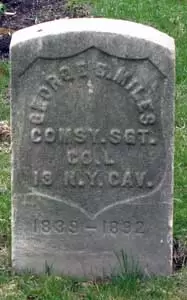
MILES, GEORGE S. (1839-1892). Commissary sergeant, 13th New York Cavalry, Company L; private, 47th Regiment, New York State National Guard, Company B. Originally from Albany, New York, Miles enlisted as a private at Brooklyn on May 27, 1862, mustered into the 47th Regiment on that date, and mustered out after three months on September 1 at Brooklyn. On September 13, 1864, he re-enlisted as a private at Tarrytown, New York, and mustered into the 13th New York Cavalry. Miles was promoted to sergeant of his company on December 31, 1864, and also served as commissary sergeant. He mustered out on June 30, 1865, at Fairfax Court House, Virginia.
The 1880 census states that Miles was a printer. In March 1888, he mustered into the Horace Greeley Post #577 of the G.A.R.; he listed his occupation then as printer. In 1891, he applied for and received an invalid pension, certificate 739,856. His last residence was 151 Gates Avenue in Brooklyn. Emma Miles, who is interred with him, applied for and was granted a widow’s pension in 1892, certificate 361,058. In May 1936, a headstone was ordered from the War Department and was sent to Green-Wood for installation. Section 161, lot 9838, grave 5.
MILES, PHILIP (1828-1867). First lieutenant, 70th New York Infantry, Company B. Miles was born in Ireland. After enlisting at New York City as a second lieutenant on April 25, 1861, he was commissioned into the 70th New York on June 20. On November 1 of that year, he was promoted to first lieutenant. He was discharged on December 9, 1862. As per his obituary in the New York Herald, he was a member of the Mozart Hall General Committee and the Knickerbocker Association; members of both organizations were invited to attend his funeral. He last lived at 88 Ludlow Street in Manhattan. Section 114, lot 8999, grave 705.
MILLER, ASA FINCH (1825-1898). Major, 53rd New York Infantry; captain, 71st Regiment, New York State Militia, Company H. A native New Yorker, Miller was in the hotel business with his father and brother according to the 1850 census. A February 25, 1852, article in The New York Times lists Miller’s name first in a petition against the “Moral Movement of Temperance.” Miller is listed as a hotel keeper in the 1855 New York State census and a saloon keeper in the 1857 New York City Directory. As per his obituary in the New York Herald, Miller commanded Company H of the 71st Regiment during Dead Rabbits Riot of 1857 (a gang fight in lower Manhattan that escalated into civil disturbance on July 4-5) and the Quarantine War at Staten Island in September 1858 (the arson of the Marine Hospital, known as the Quarantine, which housed immigrants who had smallpox, cholera and other infectious diseases; all 60 patients were moved before the fire). Miller’s occupation on the 1860 census is noted as “public house.”
During the Civil War, he enlisted at New York City as a captain on April 19, 1861, was commissioned into the 71st Regiment’s State Militia on May 3, and mustered out on July 31 at New York City. He re-enlisted on an unknown date, was commissioned as major into the 53rd Infantry, and was discharged on September 13, 1862. (He did not muster into the 53rd and was discharged by reason of consolidation with the 132nd Infantry.)
The New York City Directory of 1867 lists Miller as being in the liquor business; the 1870 census indicates that Miller was the produce commissioner whose real estate was worth $20,000 and whose personal estate was valued at $1,500. Frank Leslie’s Illustrated Newspaper noted that Miller was presented with an elegant and costly medal at the State Arsenal in recognition of his contributions to the 71st Regiment; the medal, which cost $150, was designed by Sergeant E. D. Wilson and manufactured by Charles S. Fordham at 169 Broadway in New York City. He is listed as a salesman living in Brooklyn in the 1889 Brooklyn Directory. In 1891, his application for an invalid pension was approved, certificate 826,386. The New York City Directory for 1894 lists Miller as an inspector.
His obituary in the New York Herald notes that many veterans of the 71st Regiment, who served under Colonel Abram Vosburgh (see) and who are referred to as Vosburgh’s Veterans, attended his funeral “in force.” The Vosburgh Veterans met after Miller’s death to offer a series of resolutions commemorating his service. The New York Press reported that Miller was one of the organizers and trustees of Vosburgh’s Veterans. The association draped the colors and badge of the organization in mourning for 30 days and presented an engraved copy of the commemorative resolutions to Miller’s family. He last resided at 560 East 139th Street, New York City. The New York Tribune reported on June 6, 1898, that the Vosburgh Veterans decorated the graves of their late colonel and other deceased members of the 71st including Asa F. Miller. Section 13, lot 9062, grave 10.
MILLER, BALSER (or BALDSEL, BODSEL) (1842-1917). Private, 173rd New York Infantry, Company C. Although his obituary in the Brooklyn Standard Union and the 1910 federal and 1915 New York State census list Miller’s birthplace as Brooklyn, his muster roll and earlier census data note that he was born in Germany. As per the 1900 census, he immigrated to the United States in 1850. During the Civil War, he enlisted as a private at Brooklyn on September 22, 1862, and mustered into the 173rd New York on October 30. As per his muster roll, he was a baker of German birth who was 5′ 8″ tall with gray eyes, brown hair and a light complexion. After being taken as a prisoner of war on April 9, 1864, at Pleasant Hill, Louisiana, he was imprisoned at Camp Fort Tyler in Texas, the largest Confederate-run prison west of the Mississippi; 166 men of the 173rd New York were imprisoned there after that battle. By July 1864, the prison at Fort Tyler held 5,000 men before exchanges began. He was paroled on May 27, 1865, in the last group of 1,761 prisoners. Miller was discharged on July 10, 1865, at New York City.
The 1879 and 1880 Brooklyn Directories list Miller as a cutter who lived at 545 Court Street. The 1885 Brooklyn Directory lists him as a cap-cutter who lived at 342 Hamilton Avenue. In 1891, his application for an invalid pension was approved, certificate 845,472. As per the 1892 Brooklyn Directory, he worked in trimmings (decorations to enhance a garment) at 100 South Fifth Avenue whose home address was at 340 Hamilton Avenue.
On April 28, 1898, the Brooklyn Daily Eagle reported that Miller was among the members of the 173rd New York who attended a reunion and annual dinner of the survivors of the 173rd New York at the Hotel Argyle on Pierrepont Street. For the first time, wives and daughters of the veterans were among the 75 attendees. The article noted that respects were paid to the 155 deceased men of the regiment. One guest speaker was John U. Shorter, a former colonel of the 110th Alabama Regiment, who noted that in 1898, men from the North and South joined the call to unite as one nation in the Spanish-American War. Shorter also stated that both Grant and Lee were revered by their troops and neither vilified the other. Judge Jesse Johnson then read an original poem honoring the men who fought at the Battle of Gettysburg which was inspired by his visit to that battlefield after a statue to General John Buford was unveiled there.
The 1900 census indicates that Miller lived in Brooklyn with his wife and children and worked as a hat-maker; the Millers had 10 children, but sadly only eight were alive in 1900. The 1906 Brooklyn Directory lists him in the furniture business with a home address of 336 55th Street. By the time of the 1910 census, which indicates that he was born in New York, he lived with his wife and daughter on 55th Street in Brooklyn and was a hat and cap trimmer at the Navy Yard. The 1915 New York State census, which also records that he was born in the United States, notes that he lived in Brooklyn and was a laborer at the Navy Yard.
According to his obituary in the Brooklyn Standard Union, which confirms his Civil War service, Miller worked for many years at the Brooklyn Navy Yard. He belonged to the Independent Order of Odd Fellows, a fraternal organization, and was survived by one daughter and two sons; his wife, Caroline Hoffman Miller, died in January of 1917. He last lived at 754 54th Street. His death was attributed to pneumonia. When his son filed an affidavit in Probate Court, it was noted his late father’s $3,000 in personal property was to be split among his three surviving children. Section 128, lot 34663, grave 2.
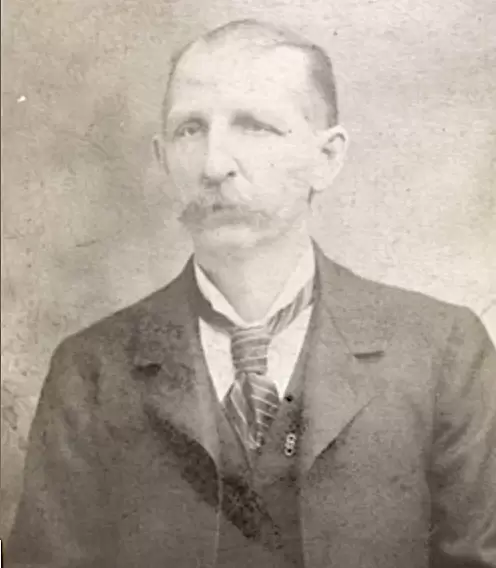
MILLER, CHARLES CHRISTIAN (1840-1915). Private, 5th New York Infantry, Company H. Originally from Württemberg, Germany, Miller, a carver by trade, was 5′ 3½” with blue eyes and brown hair. He enlisted at New York City on April 25, 1861, and mustered into the 5th New York on May 9. After being wounded in the right hand on June 27, 1862, at Gaines’ Mills, Virginia, he was hospitalized until October 13, 1862 (although his muster roll originally listed October 1862 as a desertion date), returned to his regiment on February 22, 1863, and mustered out with his company on May 14.
In 1878, he applied for and received an invalid pension, certificate 157,920. The Veterans Schedule of 1890 confirms his Civil War service and injury. In 1910, he was admitted to the National Home for Disabled Soldiers in Johnson City, Tennessee. At the time of his admission, he was suffering from visual and hearing impairments, and an inguinal hernia among other ailments. A carver, Miller was 5′ 4½” tall with blue eyes, gray hair, a fair complexion and was able to read and write. He last lived at 545 57th Street in Brooklyn. Section 131, lot 33209.
MILLER, FRANK (1848-1903). Medal of Honor recipient; private, 2nd New York Cavalry, Company M. A New Yorker by birth, Miller enlisted at Brooklyn on September 9, 1864, and mustered into the 2nd New York Cavalry that day. As per his muster roll, he was a clerk who was 5′ 9½” tall with gray eyes, brown hair and a fair complexion. He was awarded the Medal of Honor on April 24, 1865, for his action on April 6, 1865, at Sailor’s Creek, Virginia, when he captured the flag of the 25th Battalion, Virginia Infantry. At that time, he was taken prisoner but successfully retained the flag until his release. Of the 57 Medals of Honor awarded for action that day, 47 were awarded to those who captured Confederate flags.
Miller’s name appeared in a footnote of William Marvel’s book, Lee’s Last Retreat: The Fight to Appomattox (2002). Marvel concludes that Miller, and many of the other men from General George Armstrong Custer’s cavalry division who were awarded the Medal of Honor for their capture of Confederate flags that day, were “nowhere within the range of [the] combat operations [of those Confederate units],” and concludes that Miller and another cavalryman who also was awarded a Medal of Honor “obviously barged in after the fighting was over and snatched [the flags] from their dazed owners.” However, a correspondent’s account of the skirmish that appeared in The New York Times on April 14, 1865, Details of the Pursuit: Battles of the Cavalry (Capehart’s Attack…), described that day as “a grand Union triumph” with many generals captured and “the enemy throwing down their arms much faster than they could be reached.” Miller mustered out on June 5, 1865, at Alexandria, Virginia.
In 1890, he applied for and received an invalid pension, certificate 664,630. Although it was long believed that his remains had stayed in San Francisco, California, where he was a clerk and was found dead of natural causes in his apartment on September 12, 1903, after a night of reveling following a G.A.R. celebration, that information is incorrect. (His soldier record also misidentifies his burial site as San Francisco.) On September 15, an article in the San Francisco Call reported that Miller’s remains were at the mortuary chapel of the Golden Gate Undertaking Company and that he had a brother, J. A. Miller, who lived in New York. A subsequent article in the San Francisco Call on September 17 indicated that his cremated remains were shipped to Brooklyn for interment at Green-Wood. Cemetery records confirm that the Frank Miller who died in San Francisco on September 12, 1903, was interred at Green-Wood on September 20, 1903. Section 58, lot 1947.
MILLER, GEORGE V. (or B.) (1836-1873). Private, 11th New York Infantry, Company H. A native of New York City and a mason according to the 1860 census, Miller enlisted there as a private on April 20, 1861. On May 7, 1861, he mustered into the 11th New York, and deserted on August 1 of that year. His muster roll notes that he was also borne on the rolls as George B. Miller and that he was paid $6.12 by New York State for his service from April 20 through May 7, 1861. As per his obituary in the New York Herald, he died in Chicago; his funeral was held at the residence of Thomas Miller, his brother, at 348 West 17th Street in Manhattan. Section 86, lot 18066, grave 52.
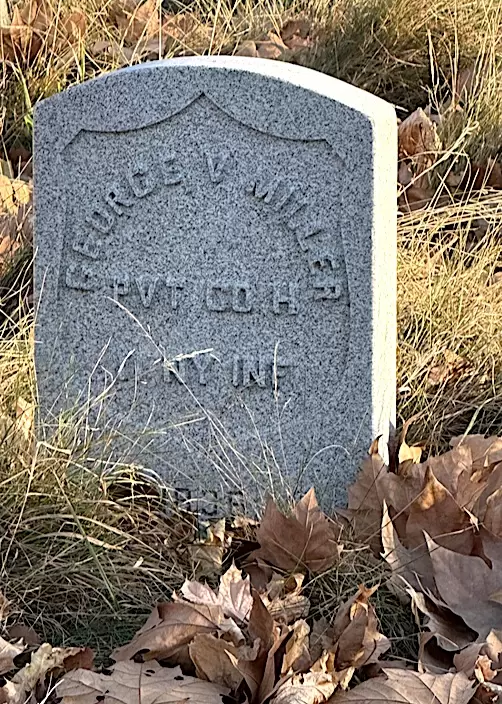
MILLER, HENRY (1839-1901). Sergeant major, 8th Regiment, New York State National Guard. Miller, who was born in Ireland, enlisted at New York City as a sergeant major on May 29, 1862, mustered into Field and Staff of the 8th Regiment the same day, and mustered out at New York City after three months on September 10. After the War, he was a captain in the 9th Regiment, New York National Guard. For over 40 years, he was a bookseller on Barclay Street, opposite the Astor House in Manhattan. He was a member of the Lafayette Post #140 of the G.A.R. and a Freemason. As per his obituary in The New York Times, which confirms his Civil War service, he died from paralysis. He last lived at 371a Greene Avenue in Brooklyn. Catharine Miller, who is interred with him, applied for and received a widow’s pension in 1911, certificate 728,824. Section 195, lot 30897, grave 2.
MILLER, HENRY (1837-1878). Private, 72nd New York Infantry, Companies C and I; 120th New York Infantry, Company A. Originally from Germany, Miller was a butcher as per the census of 1850. During the Civil War, he enlisted at New York City as a private on August 7, 1862, and mustered into the 72nd New York the same day. He joined the same regiment and company of his brother, Michael Miller (see). On June 20, 1864, he transferred into Company A of the 120th New York. On November 26, 1864, Miller was severely wounded in action at Petersburg, Virginia; his muster roll indicates that he was treated and confined at the General Hospital after the injury. He was discharged from military service on April 28, 1865. On June 19, 1865, Miller’s application for an invalid pension was approved, application 76,681. His last residence was 282 2nd Street in New York City. Miller died of phthisis (tuberculosis). Section 195, lot 26064.
MILLER, JAMES (1831-1897). First lieutenant, 5th New York Infantry, Company H. According to his obituary in The New York Times, Miller entered the 7th Regiment in 1850 and won its bronze medal for long and faithful service. At the onset of the Civil War, he enlisted as a second lieutenant at New York City on April 25, 1861, joining the 5th New York, known familiarly as Duryée’s Zouaves. He was commissioned as a second lieutenant on May 9, 1861, serving under General B. F. Butler at and around Fort Monroe, Virginia. He was later detailed as a drill master of the Union Coast Guard, consisting of 1,000 men, and familiarized them with their responsibilities before he returned to the 5th at Baltimore, Maryland. General Butler praised Miller for his work, “I desire to bear testimony to his efficient and faithful service on duty, for which I hope he may have full consideration.” Although he was promoted to first lieutenant on July 4, 1861, Miller did not muster in at that rank. He resigned on September 6, 1861, due to a disease that he contracted while serving. Miller had three brothers, one of whom was killed in the War.
The 1870 census reports that he worked as a secretary. In 1877, he applied for and received an invalid pension, certificate 393,951. Miller was listed as a store clerk in the 1880 census. He was a member of the Seventh Regiment Veterans’ League. Miller’s funeral took place at the home of his son, Chauncey Miller, a newspaper editor and reporter, at 684 President Street in Brooklyn. According to his obituary in the New York Sun, which confirms his Civil War service, he died from paralysis. Elizabeth Miller, who is interred with him, applied for and received a widow’s pension in 1897, certificate 551,529. Section 57, lot 2298, grave 2.
MILLER, JAMES PLATT (1826-1895). Unknown soldier history. Originally from Ireland, the details of his service are unknown. The 1860 census states that he was a carpenter whose real estate was worth $1,000, and who had a personal estate with a value of $500; the Brooklyn Directory for 1862 listed him as a carpenter. Although his soldier history is unknown, Miller was a member of the G.A.R., an organization of veterans of the Civil War. His occupation was indicated as carpenter on the 1870 and 1880 Federal censuses, the 1875 New York State census, and the Brooklyn Directories for 1870, 1873, 1880, 1885, and 1890. An article in the Brooklyn Daily Eagle states that he dissolved his partnership with James Williamson as carpenters and builders by mutual consent on May 1, 1890. His obituaries in the Press (New York) and the New York Sun note that he was a prominent builder in Brooklyn; the Press indicates that he was active in the Republican Party. He last resided at 299 Sumner Avenue in Brooklyn. Section 142, lot 25590, grave 5.
MILLER, JAMES WEEKS (1841-1926). Private, 7th Regiment, New York State Militia, Company B. Born in New York City, Miller enlisted in 1861 for 30 days and mustered into Company B of the 7th Regiment as a private. He mustered out with his comrades at the end of their service on June 3. As per the 1900 Federal census and the 1905 New York State census, Miller was a ticket broker whose office was at 104 Broadway; at the time of the 1910 census, he was a ticket broker living in Nutley, New Jersey. He applied for and was granted a pension in 1917, certificate 1,133,948. He was living in New Jersey when the 1920 census was recorded but he was not employed at that time. His last residence was 226 Vreeland Avenue, Nutley, New Jersey. His death was caused by apoplexy. Section 157, lot 15906.
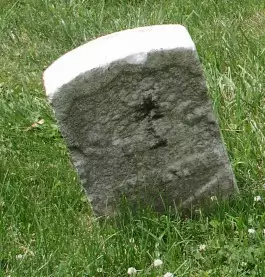
MILLER (or MÜLLER), JOHN (1833-1889). Private, 29th New York Infantry, Company E; 178th New York Infantry, Companies F and A. A native of Germany, he appeared on the rolls as John Müller. He enlisted as a private at New York City on May 15, 1861, mustered into the 29th New York on June 4, and mustered out with his company on June 20, 1863, at New York City. He re-enlisted as a private at New York City on July 17, 1863, mustered into Company G of the 178th New York, and transferred into Company A while on duty at the Quartermaster’s Department on February 1, 1865. As per his muster roll, he was a farmer who was 5′ 7″ tall with blue eyes, brown hair and a fair complexion. He mustered out with his company on April 20, 1866, at Montgomery, Alabama. In 1888, his application for an invalid pension was approved, certificate 505,268. There is an early government-issued stone marking his grave. Louise Miller (spelled Mueller on the pension index record), who is interred with him, applied for and received a widow’s pension, certificate 277,193. Section 6, lot 20118, grave 476.
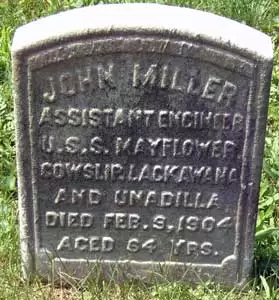
MILLER, JOHN (1839-1904). Assistant engineer, United States Navy. Miller was a native of Scotland. According to the Mortuary Table in the G.A.R. Annual of 1905, he was an assistant engineer in the United States Navy. However, there were four John Millers who served as assistant engineers during the Civil War. He was a member of the Grand Army of the Republic’s Ulysses S. Grant Post #327 which he joined on June 30, 1881. He last lived in Manhattan at 77 Cedar Street. He died of apoplexy. Section 72, lot 5015.
MILLER, JOHN H. (1841-1911). Private, 13th Regiment, New York State National Guard (Heavy Artillery), Company D. A native New Yorker, he enlisted at Brooklyn on May 28, 1862, to serve three months. That same day, he mustered into the 13th National Guard’s Heavy Artillery and mustered out on September 12 at Brooklyn. In 1897, his application for an invalid pension was granted under certificate 969,117. His last residence was at 236 Greene Avenue in Brooklyn. Miller died from heart disease. Louisa J. Miller, his widow, who is interred with him, applied for and received a pension in 1911, certificate 721,572. Section 51, lot 12102.
MILLER, JOHN J. (1842-1920). Corporal, 9th New York Veteran Infantry, Company D; private, 17th New York Veteran Infantry, Company H. A native of New York City, Miller enlisted there as a corporal on July 22, 1863, and mustered into Company D of the 9th Veteran Infantry on August 29. After being transferred to the 17th New York Veteran Infantry on October 14, 1863, he was reduced in rank to private. He mustered out with his company on July 13, 1865, at Alexandria, Virginia. In 1891, his application for an invalid pension was granted under certificate 1,091,092. His last residence was 440 72nd Street in Brooklyn. Miller died from apoplexy. Mary J. Miller applied for and received a widow’s pension shortly after his death, certificate 895,444. Section B, lot 9895, grave 812.
MILLER, MICHAEL (1841-1924). Private, 72nd New York Infantry, Companies K, C and I. A German by birth, Miller immigrated to the United States in the mid 1840s and became a naturalized citizen in 1861. His birthplace is listed as Alsace-Lorraine on the 1920 census with his mother tongue listed as French. There is some confusion about the companies in which Miller served in the 72nd New York Infantry. As per one record, Michael Miller enlisted at New York City on April 13, 1861, mustered into Company K of the 72nd on June 21, 1861, and was discharged for disability on December 23, 1862, at Providence, Rhode Island. His entry on the Find A Grave website notes that he enlisted as a private at Staten Island on August 7, 1861, and mustered into Company C of the 72nd Infantry the next day.
According to his pension record, he enlisted on August 10, 1862, and served in Companies C and I. His brother, Henry Miller (see), was in the same regiment and company. He was wounded in action at the Battle of Gettysburg, Pennsylvania, on July 2, 1863 in the Peach Orchard, and was discharged for wounds at the Union Army Hospital in New York City on May 12, 1864. As per his obituary in the Brooklyn Daily Eagle, which noted his service with Company I of the 72nd, he conducted himself “with distinction at the Battles of Chancellorsville, Fredericksburg, and Gettysburg, where he was wounded.” In 1873, his application for an invalid pension was approved, certificate 128,153.
The 1880 and 1900 censuses report that he was a butcher. An article in the Brooklyn Daily Eagle on October 21, 1920, noted that Miller and his wife celebrated their 60th wedding anniversary by taking an automobile trip to Gettysburg with their daughter, son-in-law and grand-daughter. That article noted his service with Company K of the 72nd New York (that may be an error) and his membership in the Order of the Eastern Star, a fraternal organization open to men and women. His last residence was 100 New York Avenue in Jamaica, New York.
His death, after a six-week illness, was attributed to heart disease. His obituary notes that he lived most of his life in Brooklyn and had moved to Queens in about 1913. His funeral was held at the Ulysses S. Grant Post #327 of the G.A.R., of which he was a member. Shortly after his death in 1924, Amanda née Rowland Miller, his wife of 63 years, applied for and received a widow’s pension, certificate 952,274. He was also survived by three sons, George, William and Frederic, a daughter, Eleanor, eight grandchildren and six-great-grandchildren. Section 195, lot26064.
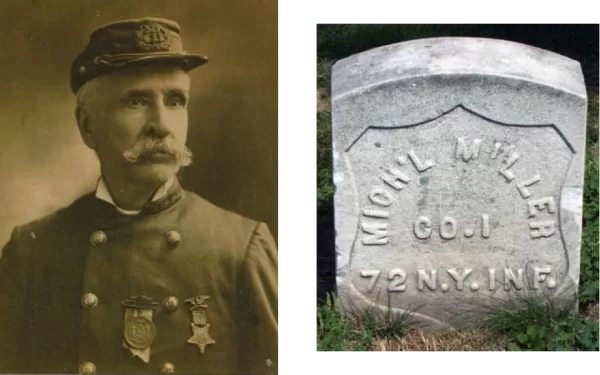
MILLER, MUTER (1818-1866). Private, 1st Regiment, Texas State Infantry, Company B, Confederate States of America. Miller was born in Vurkourdbright, Scotland. On December 29, 1853, he married Mary Jane Longley in Harris, Texas. As per North American Family History online, she married a Scotchman, Muter Miller, who was a cotton broker.
On December 1, 1863, he enlisted as a private at Harris, Texas, and mustered into Company B of the 1st Regiment, Texas State Infantry, Confederate States of America. His muster roll, however, shows that he served in Company B, also known as Sheldon’s Company, on August 7, 1863 for six months until February 15, 1864. He returned to his company in November 1863 after an absence.
Miller died in New York City on April 1, 1866, and his wife was administrator of his estate. He was interred at Green-Wood on December 17, 1866. His will, dated August 24, 1863, and filed in Houston, Texas, sheds light on his life and his feelings about his enslaved people. As per his will, if his wife predeceased him, his father would be paid annually sixty pounds sterling and his enslaved Clara, was to be emancipated and his friends Mrs. C. M. Allen and Mrs. Eliza Chase would be her guardian. As per the terms of his will, after his father’s death, his wife was directed to sell his property and interest in his firm, Miller & Somerville, estimated at $26,040, and monies were then to be bequeathed to his brother, William of Saint Lucia, West Indies (500 pounds sterling); his nephew, David Gordon Miller ($1,500 at adulthood); the Free Church of Koskaidbrught, Scotland, for Sabbath school (200 pounds sterling); and remaining monies to be divided among his two sisters and brother William (the original 500 pounds notwithstanding).
After Miller’s death, his wife moved to Greencastle, Indiana. Section 150, lot 15156.
MILLER, WILLIAM H. (1840-1914). Private, 6th Independent Battery, New York Light Artillery. Miller was a native of New York City. According to his obituary in the Brooklyn Daily Eagle, which confirms his Civil War service, Miller spent his early years in Rahway, New Jersey, where he worked with his father in the carriage manufacturing business. During the Civil War, he enlisted at New York City as a private on June 15, 1861, and mustered into the 6th Light Artillery (identified as the 6th Independent Horse Artillery in his New York Times obituary) five days later. Miller served with the Army of the Potomac and participated in most of its principal engagements. He mustered out after three years on June 21, 1864, at New York City. As per an article in the Brooklyn Daily Eagle on December 15, 1895, reporting on Miller’s election as commander of G.A.R. Post #327, Miller participated at the Battle of Chancellorsville, Virginia, on May 2, 1863, when his battery, supported by the 17th Pennsylvania Infantry and the Second Brigade Cavalry, repulsed an attack of the enemy under Confederate Lieutenant General Thomas J. “Stonewall” Jackson. In this fight, Miller’s horse was shot out from under him.
After the War, Miller was a founding member of the Ulysses S. Grant Post #327 of the G.A.R., and belonged to the Long Island Automobile Club, Crescent Athletic Club, Manufacturers Association of Kings and Queens Counties, and the Society of the Army of the Potomac. He opened a wire and spring business, Miller & Van Winkle, which his sons continued to operate in Brooklyn. In 1904, his application for a pension was granted, certificate 1,859,618. His last residence was 645 10th Street in Brooklyn; as per his obituary in the Brooklyn Daily Eagle, he had lived in Brooklyn for 50 years. He died from apoplexy. His widow, Martha Miller, applied for and received a pension in 1914, certificate 778,083. Section 162, lot 14992.
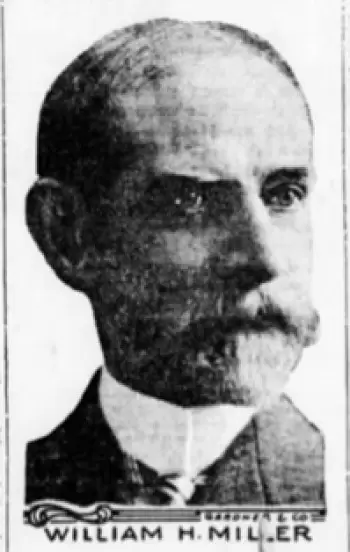
MILLER, WILLIAM WEBSTER (1845-1929). Drummer, 87th New York Infantry, Company G; private, 40th New York Infantry, Company G. After enlisting as a drummer at Whitehall, New York, on October 5, 1861, Miller, a native of New York City, mustered into the 87th New York six days later. On September 5, 1862, he was transferred into the 40th New York as a private. On December 13, 1862, he wounded at Fredericksburg, Virginia, and was discharged on April 3, 1863. He last lived on Marine Avenue in Brooklyn. Section 11, lot 4625.
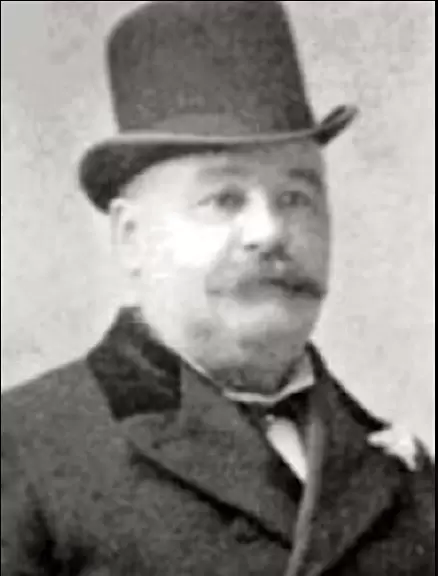
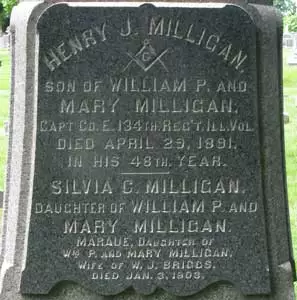
MILLIGAN, HENRY J. (1841-1891). Captain, 134th Illinois Infantry, Company E. A native of Hudson, New York, he was the brother of Robert Milligan (see). Milligan was living in Chicago and working as a painter as per the census of 1860 and the 1861 Chicago City Directory. He was a resident of Chicago, Illinois, when he enlisted as a captain on May 31, 1864, the same day that he was commissioned into the 134th Illinois. The Database of Illinois Veterans notes that at the time of his enlistment, he was an unmarried printer who was 5′ 10″ tall with dark hair, hazel eyes and a light complexion. He mustered out after 100 days on October 25, 1864, at Chicago.
According to his obituary in the Inter Ocean (Chicago), which confirms his Civil War service, Milligan was a well-known and popular citizen of the city. Before devoting the last twelve years of his life to house and sign painting and interior decorating, he was associated with the Heath & Milligan Mixed Paint Manufacturing Company. Milligan also had an interest in real estate. The 1877 and 1878 Chicago City Directories list him as a general manager living at Sherman House. He severed his connection with Heath & Milligan as per an advertisement in the Chicago Daily Tribune on February 9, 1879. He was a charter member of Chicago’s Union League Club and the Mont Joie Commandery #53 of the Knights Templar in which he held the position of captain general. He also belonged to other Masonic temples. He lived his adult life in Chicago; he last lived at the Sherman House Hotel there. His sister, Silvia C. Milligan, who lived at 58 Orange Street in Brooklyn, went to Chicago when he took sick and arrived too late for a final good-bye. His obituary notes that he died from typhoid pneumonia which weakened his nervous system. A funeral service with Masonic honors was held at the residence of George Milligan, his nephew, at 49 Center Avenue in Chicago before his body was returned Brooklyn for burial.
An article about his funeral in the Inter Ocean reported that Milligan was mourned for his “sturdy manhood and tenderness of heart.” Milligan was described as a “strong, well-posted man of affairs” who was always willing to give counsel to those in need. That article tells how Hank Milligan befriended a scrub-woman at the Sherman House, earned her confidence and helped her invest her $500 into $1,500, a sum that would see her through to the end of her life. Milligan also helped the daughter of his former employee who died after falling off a scaffold. Milligan paid for her education and helped her secure a teaching job. His sister and an honor guard from the Mont Joie Commandery escorted his remains to Brooklyn. An article in the Brooklyn Daily Eagle on May 16, 1891, reported that the sisters of Milligan and the nephew, George D. Milligan, disputed the estate, estimated to be worth $100,000; the nephew claimed to be the surviving partner in the family business and that he was entitled to the assets. Section 189, lot 16207.
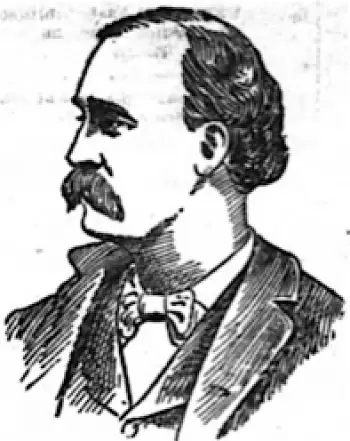
MILLIGAN, ROBERT A. (1844-1865). Corporal, 1st Illinois Light Artillery, Battery K; second sergeant, Illinois’s Colvin’s Light Artillery. Milligan was born in New York. He and Henry Milligan (see) were brothers. A resident of Chicago, Illinois, he enlisted and mustered into Illinois’s Colvin’s Light Artillery on February 16, 1865, as a private. As per the Database of Illinois Veterans, he was a painter who was 5′ 9″ tall with dark hair, hazel eyes and a dark complexion. On March 23, 1865, he transferred into Battery K of the 1st Illinois Light Artillery. He was promoted to corporal during his service, mustered out on July 15, and died of typhoid fever on July 17, 1865. His gravestone at Green-Wood states that he died “from disease contracted while serving as 2nd sergt. in Colvins Battery.” Originally interred in lot 16207, his remains were moved to their present location on October 26, 1869. Section 189, lot 16207.
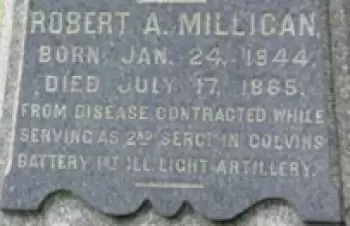
MILLMANN (or MILLMAN, MILLEMANN), JOHN (1837-1876). Private, 45th New York Infantry, Company A; 58th New York Infantry, Company A. Although Green-Wood’s records indicate that Millmann was born in Germany, his muster roll lists his birthplace as Kronstadt, Russia. During the Civil War, Millmann enlisted as a private at New York City on January 7, 1862, and mustered into 45th New York on that day. As per his muster roll, he was a carpenter who was 5′ 8″ tall with blue eyes, brown hair and a light complexion. He re-enlisted into the same regiment and company on January 4, 1864, was transferred into the 58th New York on June 30, 1865, and mustered out at Nashville, Tennessee, on October 1, 1865. Millman was listed in the 1872 New York City Directory as a cabinetmaker. His last address was 36 Essex Street in Manhattan. Millmann’s death was caused by consumption. Section 17, lot 17245, grave 480.
MILLS, CHARLES CLARENCE (1841-1865). Captain, 7th Connecticut Infantry, Company G; private, 1st Connecticut Infantry, Company A. A native of Kent, Connecticut, he was listed as living in New Haven on the censuses of 1850 and 1860; the 1860 census listed him as a student. He left Yale University during the third term of his freshman year to serve his country. Mills enlisted as a private on April 25, 1861, and mustered into Company A (also known as “Rifle A”) of the 1st Connecticut that same day. He mustered out at New Haven on July 31. He was promoted to first lieutenant on September 7, 1861, and commissioned that day into Company G of the 7th Connecticut. Mills rose to adjutant on March 7, 1862, the same day that he was transferred to the Field and Staff. Lieutenant Colonel Joseph R. Hawley of the 7th Connecticut wrote from James Island, South Carolina, on June 16, 1862, to report on the assault on Fort Pulaski, Georgia, describing the heavy fire that the troops encountered, “To meet that discharge of grape and musketry was a severe test. When the ditch broke up our line the men did not leave the ground; they stood patiently until the line was formed, and our advances and retreats were in regular line and time…” He continued to applaud Mills for his bravery and cited him for being “…entirely fearless and constantly active and near me every moment…”
Mills became a captain on September 1, 1862, and returned to Company G at that time. On February 25, 1864, he wrote a report about the engagement at Olustee, South Carolina (also called Ocean Pond), five days earlier, “…The advance of our line of skirmishers commenced to be very much impeded at about 3 miles from Olustee. At a distance of 4 miles its advance was entirely checked, all the left of the line being thrown into a swamp and exposed to a galling fire from the enemy’s right. From this position the right was advanced a few rods, the ground being more open and passable, and then ordered to lie down, maintaining all the while a lively fire. In this position, with an occasional slight advance, our ammunition was nearly all expended, and our line gradually withdrew, being charged upon by a regiment of the enemy…” He was wounded on June 2, 1864, at Bermuda Hundred, Virginia, and praised for bravery by Colonel Hawley in his field report on the next day.
Mills’s name appeared in The New York Times on July 19, 1864, as one of the wounded soldiers (“right lung”) transported from Fortress Monroe, Virginia, to New York City and Connecticut on the hospital steamer George Leary. He was discharged on December 19, 1864. Although Mills applied for an invalid pension in January 1865, application 58,989, he died before it was certified. He died from empyema, a lung disease, at Brooklyn City Hospital on DeKalb Avenue; 60 beds in the West Pavilion of the hospital were set aside for the care of sick and disabled soldiers. Cynthia Mills, whom he married in September of 1862, applied for and received a widow’s pension on February 7, 1865, certificate 76,996. Yale’s Biographical Record for the Class of 1864, published at its triennial meeting, which incorrectly states that he died in July 1864, notes that he left school in his freshman year to “offer his services…to his afflicted country. It honors Mills’s service that proved to “sacrifice a noble life on the altar of patriotism.” That sketch notes that he was beloved by officers and comrades and that the class valedictorian alluded to his service in his address. Section 157, lot 15593.
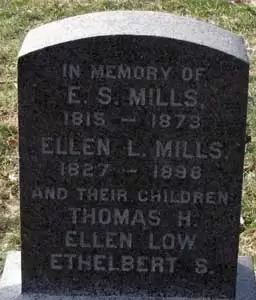
MILLS, ELLEN LOW (1827-1898). Member of the Sanitary Commission. Mills was born in Salem, Massachusetts, and was the aunt of Seth Low, a mayor of Brooklyn and president of Columbia University. She was a member of the Sanitary Commission which was founded in 1861 to help maintain clean and healthy conditions in Union camps. It achieved its aims through fund raising, providing supplies, educating the public, staffing field hospitals, etc. Many women were involved in its activities and soldier outreach. According to her obituary in The New York Times, Mills was active in the Second Unitarian Church in Brooklyn Heights where she lived at 150 Montague Street for almost 25 years. She died at her summer home in Saratoga, New York. Section 71, lot 825.
MILLS, FRANK W. (also known as MOORE, GEORGE M.) (1847-1864). Private, 158th New York Infantry, Company E. Frank Mills was also known as George Moore on his soldier records. Mills, a New Yorker by birth, enlisted as a private at New York City on January 14, 1864, using the alias of George M. Moore. He mustered into the 158th New York the same day. As per his muster roll, he was a laborer who was 5′ 3″ tall with brown eyes, brown hair and a fair complexion. Mills died of a gunshot wound on September 30, 1864, at the Battle of Fort Harrison, Virginia (also known as Fort Burnham). His obituary in the New York Herald on October 31, 1864, confirms his death in the line of duty; friends and relatives were invited to attend his funeral at the home of his grandmother, Eliza Wilson, at 105 East 19th Street in Manhattan. On November 16, 1864, Kate Mills, his mother, applied for and received a survivor’s pension, certificate 74,917. Section 15, lot 9055.
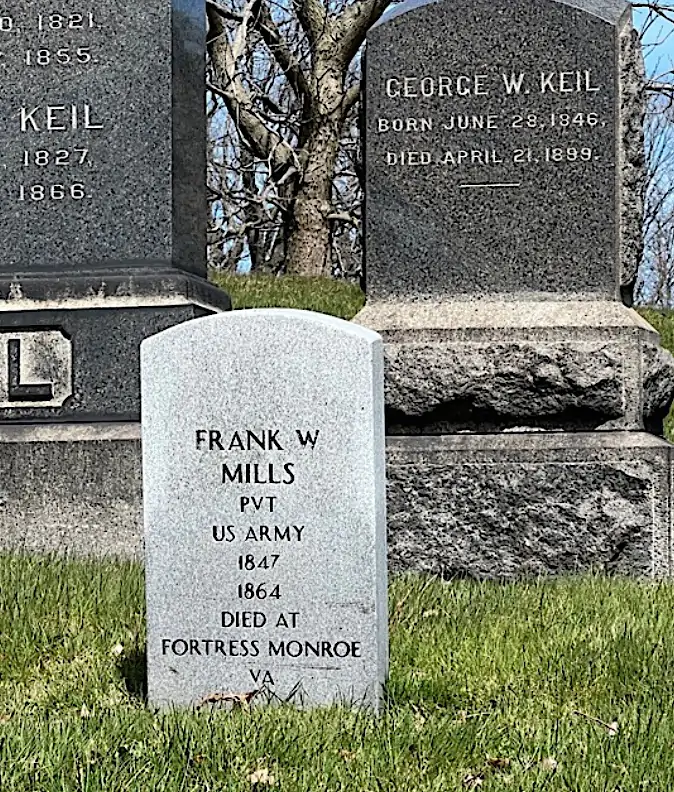
MILLS, JAMES B. (1845-1889). Private, 2nd New York Mounted Rifles, Company K. Mills enlisted as a private at Buffalo, New York, on January 27, 1864, and mustered into 2nd New York Mounted Rifles on February 6. He was discharged on June 9, 1865, at Washington, D.C. He last resided at 628 Hudson Street in Manhattan. Annie Mills applied for and received a widow’s pension, certificate 352,854. His original government-issued gravestone was provided by a Vermont contractor. Section 6, lot 20118, grave 574.
MILLS, JESSE W. (1846-1937). Drummer, 13th Regiment, New York State Militia, Company B; 51st New York Infantry, Company G. Mills was born in Brooklyn. He first served three months in 1861 as a drummer with the 13th New York State Militia under then-Lieutenant Samuel Sims (see). After Sims was discharged from the 13th and began recruiting for Company G of the 51st Regiment, Mills re-enlisted in that company as a drummer at Brooklyn on August 19, 1861, and mustered into the 51st New York on September 12. His muster roll records that he was a clerk who was 5′ 7″ tall with grey eyes, black hair and a fair complexion. As per “The Gallant Sims”: A Civil War Hero Rediscovered by Jeffrey Richman (2016), at the Battle of Newbern, North Carolina, Mills bravely drummed the 51st into battle. “For his unflinching courage, a ceremony was held at Camp Potter near Newbern on June 9, 1862, in which Captain Sims called out his company to witness his presentation to Mills of two sets of drum sticks. One set was capped with silver mounts and inscribed: To/Jesse Mills/from/Company B 13th Regt./N.Y.S.M.”- Sims’s and Mills’s company in the old 13th. A newspaper account of this ceremony reported, “In making the presentation Captain Sims had the company drawn up in front of his quarters and addressed his men in a very appropriate manner, remarking that these gifts were evidence that they were not forgotten at home; he was much pleased to present these testimonials of the kind regard of their friends.” Captain Sims told his men that he took great delight in giving the drumsticks to Mills “as he had always performed his duty and was ever a reliable man in his company.” The account concludes: “The Captain then proposed three hearty cheers for Company B of the 13th Regiment of Brooklyn, which were heartily given as only Company G can give them.”
Mills’s muster roll indicates that he was absent and sick in the hospital at Covington, Kentucky, from August through December 1863. He re-enlisted on January 28, 1864, and mustered out with his company at Alexandria, Virginia, on July 25, 1865. According to his obituary in the Brooklyn Daily Eagle, Mills also participated in Virginia at the Battle of Second Bull Run and the Battle of the Wilderness, and at the Battle of Antietam in Maryland. He was twice wounded and twice captured; once he escaped and once he was exchanged. The obituary notes that in addition to serving as a drummer, he was also a dispatch bearer and an orderly to General Ambrose Burnside.
After the war ended, Mills entered the hat business and then worked for the Parks Department in Brooklyn. Continuing his interest in military affairs, he was for more than 25 years a member of the 23rd New York State National Guard (the 106th at the time of his death). In 1888, Mills drummed at the dedication of the Green-Wood Cemetery monument marking the grave of Captain Samuel Sims, his former commander. In 1891, he applied for and was granted a pension, certificate 1,149,093. As per an article in the Brooklyn Daily Eagle on August 3, 1928, Mills and the commander of Ulysses S. Grant Post #327 of the G.A.R. were charged with the responsibility of donating historical books, pictures and Civil War relics to the Brooklyn Public Library; any remaining memorabilia were scheduled to be sold at auction. His obituary in the Brooklyn Daily Eagle notes his honorary membership in the 13th New York Veterans’ Association and membership in the Freemasons and the Society of Old Brooklynites. In addition, the obituary reports that his cap, drum and drumsticks were included in an exhibition of Civil War memorabilia at the Brooklyn Museum. Mills was the last surviving member of Ulysses S. Grant Post #327 of the G.A.R. He was a member of the old Hanson Place M. E. Church. Mills retired from his Park Department job in 1913. His last Brooklyn residence was at 357 Cumberland Street. At the time of his death, at age 91, he was a resident of St. Cloud, Florida, his home for the last five years of his life. His funeral was held at the Fairchild Chapel at 86 Lefferts Place in Brooklyn. Section 25, lot 7405.
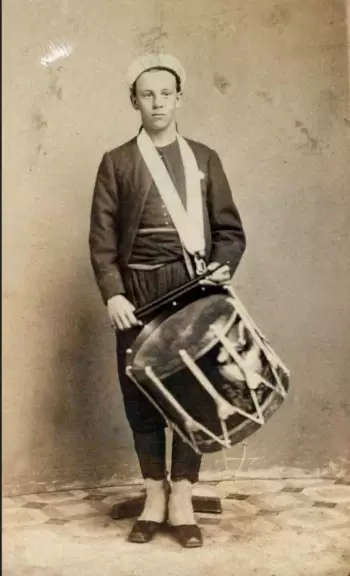
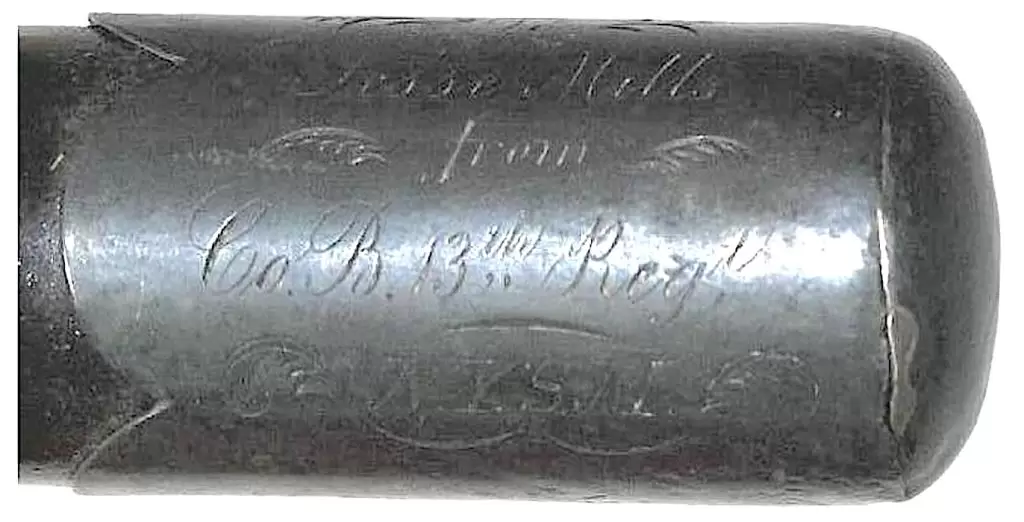
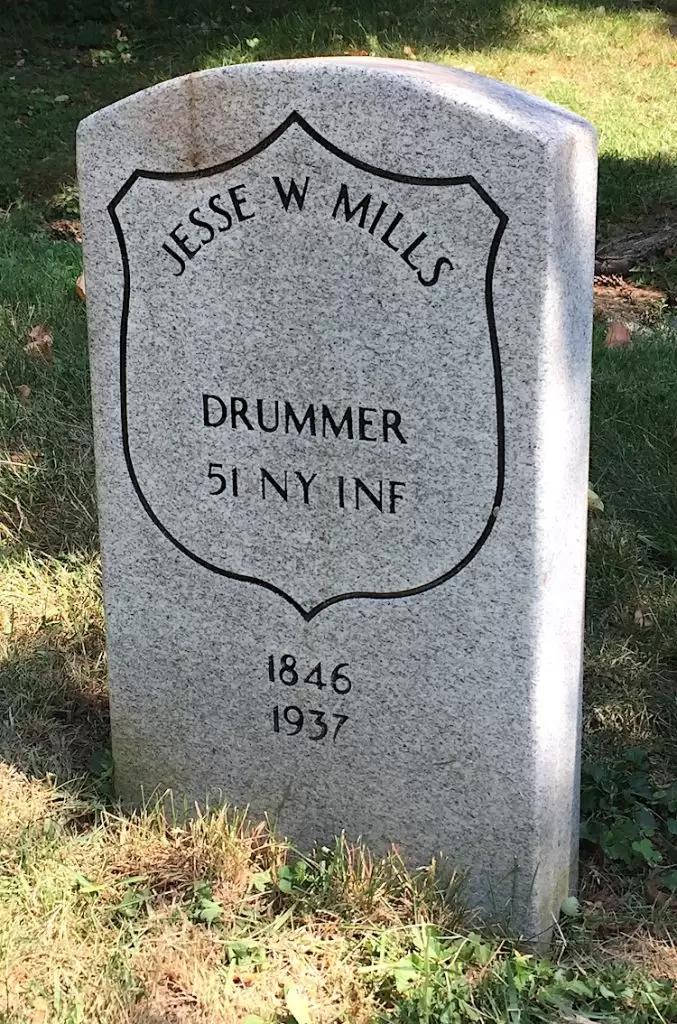
MILLWARD, JR., JAMES E. (1831-1892). Major, New York Union Coast Guard, Field & Staff; first lieutenant, 99th New York Infantry, Companies F, H and G; rank unknown, Washington D.C.’s Clay Battalion, Company E. Originally from England, Millward was living in Manhattan and was employed as a lumber dealer, as per the 1860 census. As per the Westchester W.P.A. (Works Progress Administration) Veterans Project, he was a member of the Clay Battalion, Company E. The Cassius M. Clay Battalion defended the White House in Washington, D.C., in April 1861. (See photo below.) That battalion was organized by Cassius Marcellus Clay, a Kentucky politician who was the son of a slave-holder and friend Mary Todd Lincoln’s family. Clay was appointed by President Abraham Lincoln (after failing to be chosen as his vice-president) to be minister to Russia from March 28, 1861 until April 1861 and again in 1863. In 1861, Clay organized the battalion of 300 volunteers, known as Clay’s Washington Guards, to protect the White House and the United States Naval Yard from a possible Confederate attack. Lincoln gave Clay a presentation Colt revolver in thanks. When federalized state troops arrived in Washington to take over this protection, Clay left for Russia. Clay, who became an abolitionist as a young man, was a founder of the Republican Party in Kentucky and won the support of Russia for the Union during his diplomatic duty, serving there until 1869. Clay was also a major general of volunteers from June 1862 to March 1863.
After enlisting as a major at New York City on May 28, 1861, Millward was commissioned into the Field & Staff of the New York Union Coast Guard. His muster roll notes that he was “acting as a major” and was paid as a major. He was discharged on July 1, 1861. He re-enlisted on January 17, 1862, and was commissioned into Company F of the 99th New York as a first lieutenant. He was transferred into Company H on January 21, 1862, and into Company G on March 30, 1862, then discharged on July 15, 1863, at Fort Monroe, Virginia. As per the Veterans’ Census of 1890, he was wounded in the arm at Bethel, Virginia. The 1870 census, which incorrectly reports that he was born in New York, notes that he lived in Manhattan and worked at a livery stable. In 1890, he was living in Yonkers, New York; the 1892 Yonkers City Directory reports that he was a merchant living at 182 North Broadway in Yonkers. Millward was a member of the J. Howard Kitching Post #60 of the G.A. R. He last lived in Yonkers but died of Bright’s disease in Boston. Section ?, lot 10093.
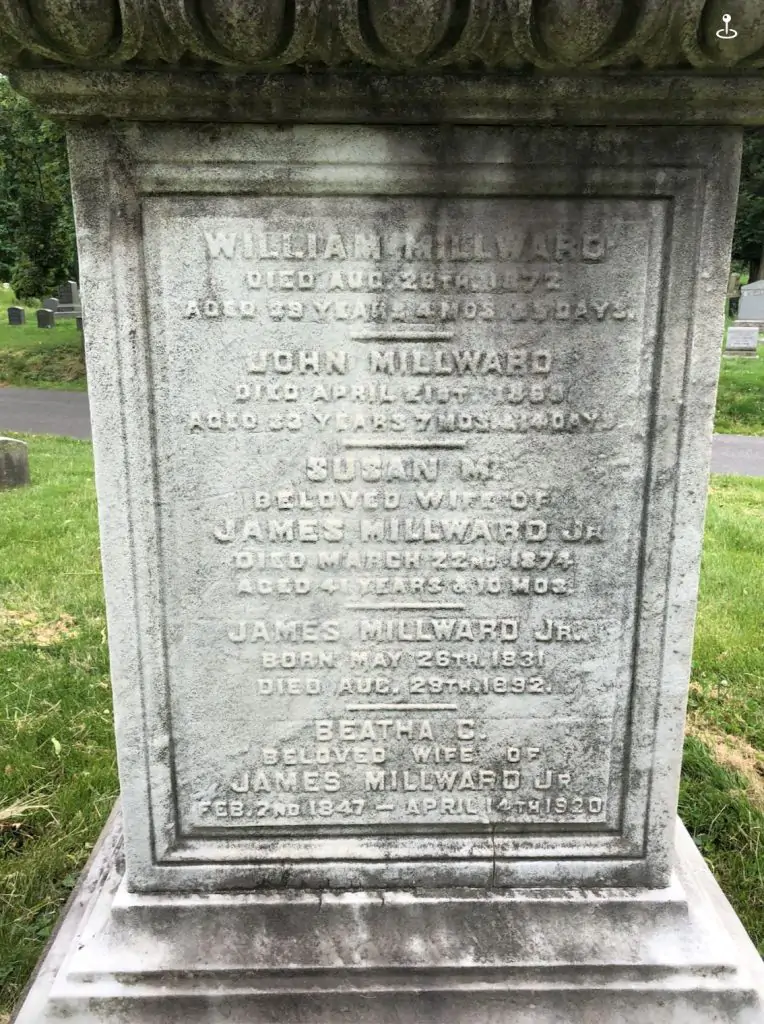
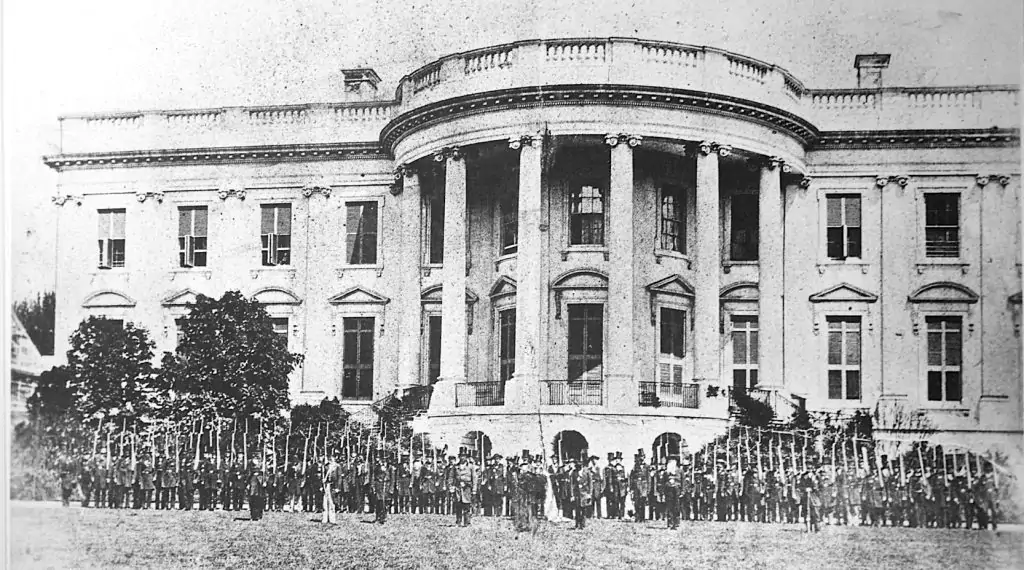
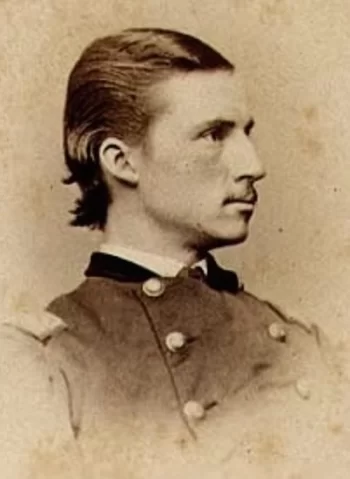
MILN, DAVID IRVING (1843-1880). Lieutenant colonel by brevet; lieutenant colonel, 65th New York Infantry, Companies H, K, and F; private, 7th Regiment, New York State Militia, Company B. A native New Yorker, Miln enrolled there as a private on April 17, 1861, mustered into the 7th on April 26, and mustered out with his company on June 3. After re-enlisting as a second lieutenant at New York City on June 11, 1861, he was commissioned into Company H of the 65th New York on August 20. (He served as a volunteer officer with the 11th New York from July 4-August 8, at which time he was present at the Battle of Bull Run, Virginia.) His muster roll reports that he was a soldier who was 5′ 9½”tall with black eyes, brown hair and a fair complexion. Miln was promoted to first lieutenant on January 1, 1862, effective upon his transfer that day to Company K, and rose to captain on August 1, 1862, the same day that he transferred into Company F.
He fought in the battles of the Peninsula Campaign including these in Virginia: Chantilly, Marye’s Heights, and the Wilderness, and at Gettysburg, Pennsylvania. He commanded the 65th at the Battle of Spotsylvania Court House, Virginia, on May 8-21, 1864, where he was wounded in the head by a musket ball. He led his regiment at the assault on Petersburg, Virginia, from June 15-19, 1864, and was detached from the Army of the Potomac from August-December 1864. After he returned to the 65th on December 1, 1864, he was commissioned in as its major the next day and was assigned as provost marshal on the staff of Major General Horatio G. Wright of the Sixth Corps. Miln became lieutenant colonel on June 13, 1865, dating from May 31, 1865, shortly before he mustered out on July 17 at Hall’s Hill, Virginia. On June 20, 1865, he was brevetted lieutenant colonel of U.S. Volunteers “for meritorious and efficient services during the campaign terminating in the surrender of the insurgent army under General Robert E. Lee,” to date from April 9, 1865. As per his obituary in the New York Herald, “He was distinguished as a good, brave and faithful officer, and was popular with his comrades and men in the army, as well as among his many friends at home.”
Remaining active in military affairs, Miln was a comrade in the Phil Kearney Post #8 of the G.A.R., a member of the 7th Veteran Association, and a member of the Civil War officers’ organization, the Loyal Legion. Although he died in Helena, Montana, he last lived at 442 West 23rd Street in Manhattan. His obituary in the New York Herald, which confirms his Civil War service, notes that his death was caused by congestion of the brain. An article in the Rocky Mountain Husbandsman (White Sulphur Springs, Montana) reported on July 8, 1880, that Miln died in Helena shortly after arriving there from New York City on a business trip. He had made many friends in that city a year earlier when he spent several weeks there on business. The Montanans (still a territory in 1880) were taken with Miln because of his social qualities and “noble nature.”After Miln’s death, the civilian and military leaders of Helena convened to pay their respects, including comrades from the Loyal Legion. After religious services, his remains were placed in a strong box for the rail journey home to New York.
As per Miln’s obituaries in the New York Herald and the New York Tribune, his funeral took place at St. Bartholomew’s Church at Madison Avenue and East 44th Street; friends and relatives were invited to attend. On July 16, 1880, the New York Tribune wrote about his church funeral in a piece headlined, “Honors to a Dead Soldier.” Floral tributes bedecked his coffin. In front of the pulpit stood a cross of violets on a myrtle stand; the number of his regimental company, the 6th, was “written” with carnations and the word “Chasseurs,” a familiar name for the 65th New York, was wrought with white roses on the stand. Members of the Loyal Legion, veterans of the National Guard and members of his company were in attendance. Military officers were the pallbearers. Miln’s remains were taken to Green-Wood after the Episcopal service. Section 159, lot 14178.
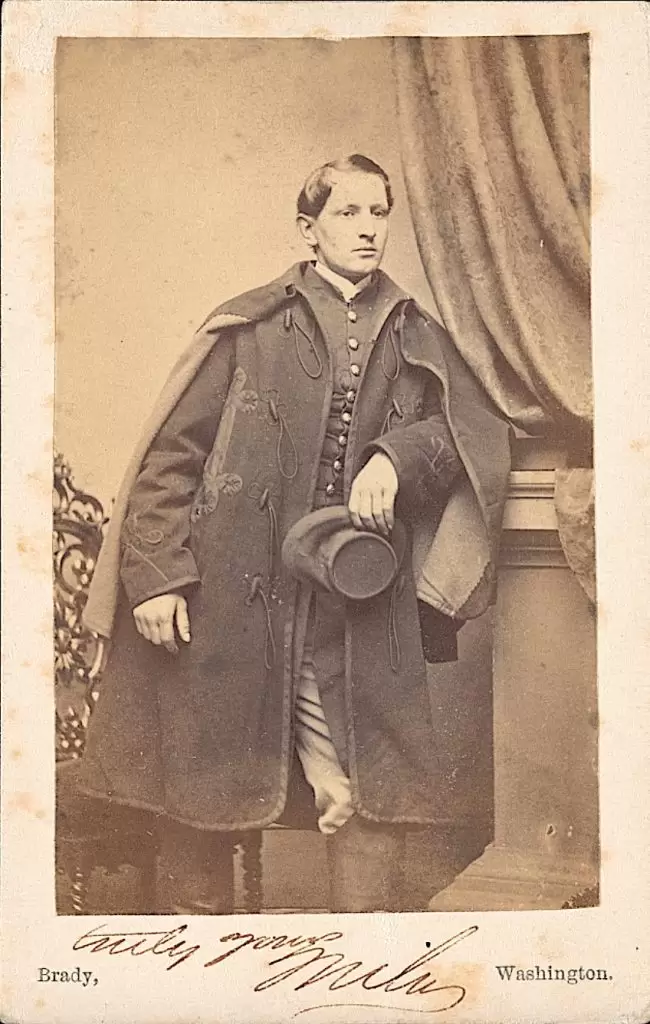
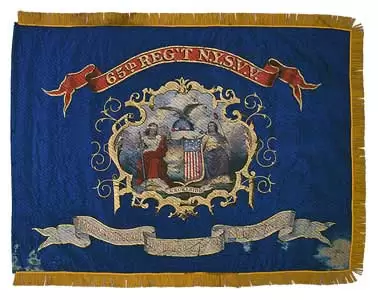
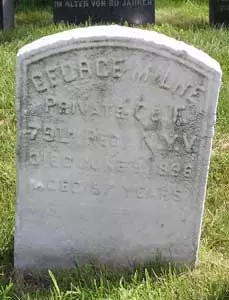
MILNE, GEORGE (1839-1896). Private, 79th New York Infantry, Company F. A native of Montrose, Scotland, he immigrated to the United States when he was fourteen and first settled in New Jersey. During the Civil War, Milne enlisted on May 13, 1861, at New York City, mustered into the 79th New York, also known as the Highlanders or Scotch Highlanders, on May 28, and was discharged for disability on December 29, 1863, at Falmouth, Virginia.
The 1865 New York State census reports that he was a clerk; the census of 1880 lists him as working in dry goods. His obituaries in the New York World and the Tribune confirm his Civil War service. Those obituaries indicate that he was a member of the Veteran Association of the 79th New York. In 1891, Milne’s application for an invalid pension was approved, certificate 828,267. His obituary in the New York Tribune reports that Milne was in the dry-goods business and was employed by the firm of H. B. Claflin & Co. until five years before his death. (Horace Claflin (see) was an abolitionist and Republican in addition to his prominence as a merchant.) The Tribune also reports that Milne was active in Republican Party politics. He last lived at 423 12th Street in Brooklyn; as per his obituary in the Brooklyn Daily Eagle, friends and relatives were invited to attend his funeral at his late residence. He died from phthisis. Eliza Milne, who is interred with him, applied for and received a widow’s pension in 1896, certificate 430,192. Section 135, lot 14964.
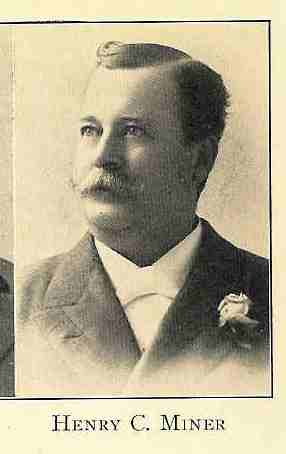
MINER, HENRY CLAY (1842-1900). Pharmacist, 1st New York Engineers. A New York City native, Miner’s father, a mechanical engineer, built the waterworks at Havana, Cuba, and constructed the first locomotive that ran on Long Island. Henry Clay Miner was educated at the Crystie Street Grammar School and at the American Institute School, where he learned the drug business. Miner also studied pharmacy at the American Institute of Physicians and Surgeons, an alternative healing school, and with his brother, Dr. Edward Miner, the president of the Brooklyn Medical College. Known familiarly as “Harry,” he was a drug clerk at various Manhattan stores at the start of his working life. Subsequently, his first business venture, the H.C. Miner Company, operated multiple drug stores and was a wholesale supplier of toiletries and merchandise to other drug stores.
During the Civil War, Miner enlisted at New York City as a pharmacist for three months, served with the 1st New York Engineers (the Mechanics and Artisans Regiment), and was assigned to the Field and Staff. After his discharge, he gave up his work as a drug clerk due to ill health and was a patrolman for the Brooklyn Police Department for two years in the Mercer Street Precinct. By 1864, he developed an interest in the theater after working as an advance man for a traveling medical lecturer, Professor De Courcey. Miner’s first theatrical venture was a variety hall in Baltimore, Maryland, before coming to New York City in 1875. He then operated a number of theaters in New York City including the London Theater and the People’s Theater on the Bowery and other venues where vaudeville productions were performed. Starting with just a small investment of $800 in 1875, his theater on the Bowery was turning a profit of $28,000 a year later, as per the New York Dramatic Mirror.
Perhaps his most long-lasting legacy was “the hook” used at amateur nights at Miner’s Bowery Theater on Friday nights beginning in 1878. Contestants were given a dollar (a lot of money then) and the winner was given a watch or other prize; those performers who were not to the audience’s liking were hauled offstage with a shepherd’s crook—“given the hook.” As per the article “A Miner’s Lantern” in The New York Wanderer (November 22, 2006), the familiar expression “give ‘em the hook,” first heard in 1903, kept Miner’s memory alive. Miner was an advance man for Wild Bill Hickok, Buffalo Bill and Texas Jack and pioneered the creation of circuits by booking acts into several theaters under his management instead of a single engagement at one theater. Eventually, he owned theaters in Newark, New Jersey, Brooklyn and Detroit, Michigan. According to an article about his sudden death in The New York Times, at one time he controlled more playhouses than any manager of his day. He also controlled the H. C. Miner Lithography Company, which produced advertising and colorful posters for his theatrical productions, and was the publisher of the American Dramatic Directory. Miner’s entrepreneurial bent extended to interests in railroads, mining and real estate.
Active in Democratic Party politics, he became a crony of “Big” Tim Sullivan, a Tammany Hall politician. Miner was elected to the fifty-fourth Congress in 1894, the same year that his first wife, Julia Lucinda Moore, died. A member of the New York Athletic Club and the Comanche Club, he also turned around the debt-ridden Actors’ Fund when he was its president, and organized a corps of nurses from New York City to help in the South during a yellow fever scourge. An article in the Brooklyn Daily Eagle on April 5, 1896, noted his baptism to Catholicism prior to his second marriage to a much younger bride, Annie O’Neill, who was an aspiring actress. The article stated that he “settled” $500,000 on his bride and included his Congressional biography which stated in part that he was also a financier of numerous enterprises, had a controlling interest in a New York City newspaper syndicate and a photographic material house, and sponsored several touring companies. According to his obituary in the New York Dramatic Mirror, he built his own fortune which at the time of his death was worth several million dollars and had a new baby, a six-week-old son, John. Another biography states that he was worth more than $5 million ($146 million in 2017) and that his estate was controlled by Henry C. Miner, one of his four sons from his first marriage. His last residence was 44 Riverside Drive in Manhattan. His death was attributed to diabetes. His body was placed in the family mausoleum at Green-Wood. Miner’s Bowery Theater burnt down in 1929; “The Miner’s Lantern,” titled for the glass slides that was projected in auditoriums in the 1800s, notes that among the performers who made their debut at Miner’s Bowery Theater were George M. Cohan, Al Jolson, Weber and Fields and Eddie Cantor. Section 9, lot 29526.
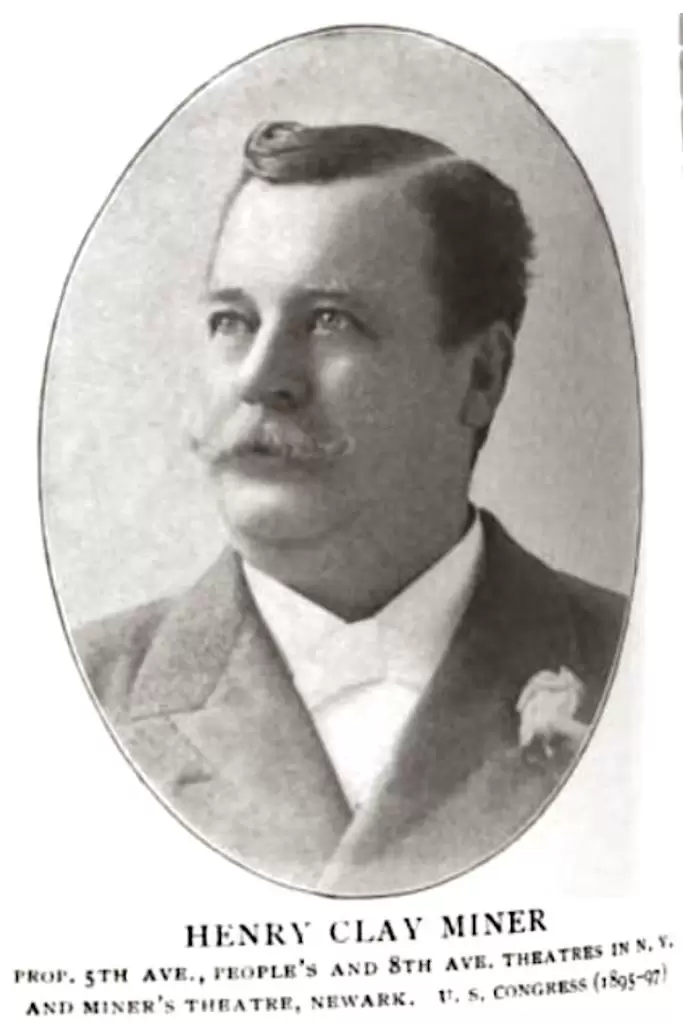
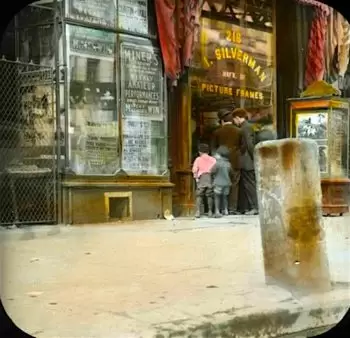
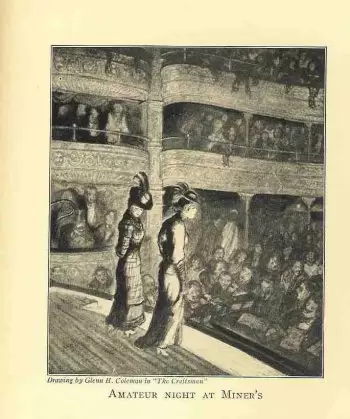
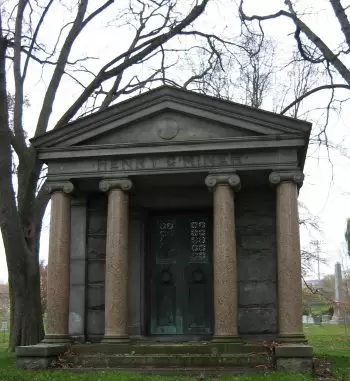
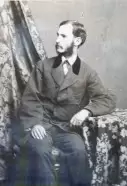
MINGAY, ELWOOD B. (1843-1898). Private, 7th Regiment, New York State Militia, Company I. Mingay served in the first activation of the 7th Regiment from April 18-June 3, 1861. He re-enlisted as a private at New York City on May 25, 1862, mustered immediately into the same regiment and company, then part of the 7th National Guard, and mustered out after three months at New York City on September 5. He returned to his company for the 1863 activation from June 16-July. According to his obituary in the New York Herald, Mingay was an illustrious noble in the Oasis of New York, Mecca Temple, a fraternal organization. He died of heart disease. Section 91, lot 5422.
